Abstract
Background
In a previous Cochrane Review, we found that for women with metastatic breast cancer unselected for triple‐negative disease, there is little or no survival benefit and excess toxicity from platinum‐based regimens. In subgroup analyses, however, we found preliminary low‐quality evidence of a survival benefit from platinum‐based regimens for women with metastatic triple‐negative breast cancer (mTNBC). This review updates the evidence from the mTNBC subgroup analyses in the previous Cochrane Review.
Objectives
To assess the effects of platinum‐containing chemotherapy regimens with regimens not containing platinum in the management of women with mTNBC.
Search methods
We obtained relevant studies published prior to 2015 and their extracted results from the mTNBC subgroup analysis in the previous Cochrane Review. We searched the Cochrane Breast Cancer Group's Specialised Register, CENTRAL, MEDLINE, Embase, the World Health Organization's International Clinical Trials Registry Platform and ClinicalTrials.gov between 2015 and 27 September 2019. We identified further potentially relevant studies from previous trial reports, systematic reviews, and meta‐analyses.
Selection criteria
Randomised trials comparing platinum‐containing chemotherapy regimens with regimens not containing platinum in women with mTNBC. Individual trials could compare one or more platinum‐based regimens to one or more non‐platinum regimens; hence there could be more 'treatment‐comparisons' (i.e. platinum regimen versus non‐platinum regimen comparison) than trials. Trial participants may have been purposely selected for mTNBC or inadvertently selected as a subgroup.
Data collection and analysis
At least two independent reviewers assessed studies for eligibility and quality, and extracted all relevant data from each study. We derived hazard ratios (HRs) for time‐to‐event outcomes, where possible, and used fixed‐effect models for meta‐analyses. We analysed objective tumour response rates (OTRRs) and toxicities as binary (dichotomous) outcomes with risk ratios (RRs) used as measures of effects. We extracted quality of life data, if available. We used GRADE to rate the quality of evidence for time‐to‐event and tumour response outcomes.
Main results
This review includes 13 treatment‐comparisons involving 1349 women from 10 studies. Twelve of the 13 treatment‐comparisons were included in one or more meta‐analyses. Of the 13 treatment‐comparisons, six and eight had published or provided time‐to‐event data on overall survival (OS) or progression‐free survival/time to progression (PFS/TTP), respectively, that could be included in meta‐analyses. Ten treatment‐comparisons published or provided OTRR data that could be included in meta‐analyses. Eight of the 13 treatment‐comparisons were from studies that selected participants on the basis of mTNBC status, while the other five treatment‐comparisons were from studies that reported mTNBC results as part of subgroup analyses.
Analysis of six treatment‐comparisons indicated that platinum‐containing regimens may have provided a small survival benefit to mTNBC patients (HR 0.85, 95% CI 0.73 to 1.00; 958 women; moderate‐quality evidence) with no evidence of heterogeneity (P = 0.41; I2 = 1%). Data from eight treatment‐comparisons showed that platinum regimens may improve PFS/TTP (HR 0.77, 95% CI 0.68 to 0.88; 1077 women; very low‐quality evidence). There was marked evidence of heterogeneity (P < 0.0001; I2 = 80%). There was also low‐quality evidence of better tumour response for platinum recipients (RR 1.40, 95% CI 1.22 to 1.59; 1205 women) with some evidence of heterogeneity (P = 0.01; I2 = 58%). The observed heterogeneity for the PFS/TTP and OTRR outcomes may reflect between‐study differences and general difficulties in assessing tumour response, as well as the varying potencies of the comparators.
Compared with women receiving non‐platinum regimens: rates of grade 3 and 4 nausea/vomiting were higher for platinum recipients (RR 4.77, 95% CI 1.93 to 11.81; 655 women; low‐quality evidence) and rates of grade 3 and 4 anaemia were higher for platinum recipients (RR 3.80, 95% CI 2.25 to 6.42; 843 women; low‐quality evidence). In general, however, relatively few intervention‐comparisons could be included in meta‐analyses for adverse events. None of the studies reported quality of life.
Authors' conclusions
For women with mTNBC, there was moderate‐quality evidence of a small survival benefit from platinum‐based regimens compared to non‐platinum regimens. This finding is consistent with findings of a PFS/TTP benefit and improved tumour response from platinum‐based regimens. These potential benefits, however, should be weighed against previously identified excess toxicities from platinum‐based regimens, particularly regimens containing cisplatin. Further randomised trials of platinum‐based regimens among women with mTNBC are required.
Keywords: Female; Humans; Antineoplastic Agents; Antineoplastic Agents/adverse effects; Antineoplastic Agents/therapeutic use; Bias; Carboplatin; Carboplatin/adverse effects; Carboplatin/therapeutic use; Cisplatin; Cisplatin/adverse effects; Cisplatin/therapeutic use; Genes, BRCA1; Genes, BRCA2; Nausea; Nausea/chemically induced; Oxaliplatin; Oxaliplatin/adverse effects; Oxaliplatin/therapeutic use; Progression-Free Survival; Randomized Controlled Trials as Topic; Triple Negative Breast Neoplasms; Triple Negative Breast Neoplasms/drug therapy; Triple Negative Breast Neoplasms/genetics; Triple Negative Breast Neoplasms/mortality; Vomiting; Vomiting/chemically induced
Plain language summary
Platinum‐containing regimens for triple‐negative metastatic breast cancer
What is the issue?
Metastatic breast cancer occurs when the cancer has spread to areas of the body beyond the breast and nearby lymph nodes. Although metastatic breast cancer is generally not curable, it is widely accepted that women with metastatic disease should receive some form of chemotherapy to help ease the severity of disease symptoms, slow cancer progression and improve survival, when compared to no treatment. Chemotherapy containing platinum is known to be effective for treating a number of cancer types including lung, testicular, head and neck, bladder and ovarian cancers. However, it is also known to cause more adverse effects (such as nausea and vomiting, hair loss, anaemia, kidney damage and low white blood cells) than other chemotherapy options. The two platinum agents most used for treating metastatic breast cancer are carboplatin and cisplatin.
In a previous Cochrane Review, we found that for women with metastatic breast cancer, there is little or no survival benefit, and more side effects related to toxicity, from platinum‐based regimens. In analysing different groups of women with metastatic disease, however, we found preliminary evidence of a survival benefit from platinum‐based regimens for women with the triple‐negative subtype of metastatic breast cancer. The term 'triple‐negative' relates to the fact that this subtype of breast cancer tests negative for oestrogen receptors (ERs) and progesterone receptors (PgRs), and have low levels of a protein called human epidermal growth factor receptor 2 (HER2).
The current review updates the evidence on platinum‐containing regimens for women with a specific breast cancer subtype of triple‐negative metastatic breast cancer (mTNBC).
Why does it matter?
mTNBC makes up approximately 12% to 17% of breast cancers and is associated with shorter survival and higher chance that the cancer returns. In recent years, some researchers have hypothesised that chemotherapy containing platinum might be more effective in treating mTNBC than other chemotherapy options. Randomised controlled trials (RCTs) have been designed and conducted to test this hypothesis.
We asked:
Are chemotherapy treatments containing a platinum agent more or less effective for treating women with mTNBC than chemotherapy treatments not containing a platinum agent?
We found:
10 studies involving 1349 women. The evidence is current to September 2019. This review found that for women with mTNBC, a chemotherapy containing platinum:
‐ may increase survival time over chemotherapy without platinum;
‐ reduces the number of breast cancer recurrences compared to chemotherapy that did not contain platinum but we are uncertain about these results;
‐ appears to cause tumours to shrink more than chemotherapy without platinum;
‐ may increase the chance of severe nausea and vomiting compared to treatment without platinum; and
‐ may increase the chance of anaemia compared to chemotherapy without platinum.
What does this mean?
Chemotherapy containing platinum may provide a small survival benefit to mTNBC participants, but still large enough to justify its use. This potential benefit needs to be weighed against the higher risks of toxic side effects from platinum‐based regimens compared to non‐platinum regimens. Further studies are required before a more definitive conclusion can be made.
Summary of findings
Summary of findings 1. Platinum compared to non‐platinum regimens for metastatic triple‐negative breast cancer: OS, PFS/TTP and OTRR.
| Platinum compared to non‐platinum chemotherapy regimens for women with metastatic triple‐negative breast cancer | ||||||
| Patient or population: women with metastatic triple‐negative breast cancer (mTNBC) Setting: hospital Intervention: platinum Comparison: non‐platinum chemotherapy regimens | ||||||
| Outcomes | Anticipated absolute effects* (95% CI) | Relative effect (95% CI) | No. of participants (treatment‐ comparisons) | Quality of the evidence (GRADE) | Comments | |
| Risk with non‐platinum chemotherapy regimens | Risk with platinum containing regimens | |||||
| Overall survival (OS) | 1‐year risk of death | HR 0.85 (0.73 to 1.00) | 958 (6) | ⊕⊕⊕⊝ MODERATE3 | Heterogeneity: Chi² = 5.05, df = 5 (P = 0.41); I² 1% | |
| 510 per 1,000 1 | 455 per 1,000 (406 to 510)2 | |||||
| 2‐year risk of death | ||||||
| 711 per 1,000 1 | 652 per 1,000 (596 to 711)2 | |||||
| Progression‐free survival/time to progression (PFS/TTP) | 1‐year risk of progression or death | HR 0.77 (0.68 to 0.88) | 1077 (8) | ⊕⊝⊝⊝ VERY LOW 4 5 6 | Heterogeneity: Chi² = 34.78, df = 7 (P < 0.0001); I² 80% | |
| 936 per 1,000 1 | 880 per 1,000 (846 to 911)2 | |||||
| 2‐year risk of progression or death | ||||||
| 970 per 1,000 1 | 933 per 1,000 (908 to 954)2 | |||||
| Objective tumour response rate (OTRR) (assessable participants) | 368 per 1,000 7 | 515 per 1,000 (449 to 585) | RR 1.40 (1.22 to 1.59) | 1205 (10) | ⊕⊕⊝⊝ LOW 4 5 | Heterogeneity: Chi² = 21.44, df = 9 (P = 0.01); I² 58% |
| *The risk in the intervention group (and its 95% confidence interval) is based on the assumed risk in the comparison group and the relative effect of the intervention (and its 95% CI). CI: Confidence interval; RR: Risk ratio; HR: Hazard ratio; | ||||||
|
GRADE Working Group grades of evidence High quality (⊕⊕⊕⊕): We are very confident that the true effect lies close to that of the estimate of the effect Moderate quality (⊕⊕⊕⊝): We are moderately confident in the effect estimate: The true effect is likely to be close to the estimate of the effect, but there is a possibility that it is substantially different Low quality (⊕⊕⊝⊝): Our confidence in the effect estimate is limited: The true effect may be substantially different from the estimate of the effect Very low quality (⊕⊝⊝⊝ or ⊝⊝⊝⊝): We have very little confidence in the effect estimate: The true effect is likely to be substantially different from the estimate of effect Each ⊝ symbol represents a downgrading of the quality of evidence one level from the highest level of 'high quality (⊕⊕⊕⊕).' | ||||||
1Estimated from the average of non‐platinum group Kaplan‐Meier probabilities from the 3 highest weighted treatment‐comparisons in Analysis 1.1.
2Estimated as 1000*(1‐S(t)HR) where S(t) is the estimated probability of survival for non‐platinum participants and HR is the pooled hazard ratio (Guyatt 1998)
3Downgraded quality of evidence one level for ’serious imprecision’ because the confidence interval for the pooled estimate is wide and crosses or nearly crosses unity.
4Downgraded quality of evidence one level for ’serious indirectness’ because this outcome is a surrogate endpoint of questionable validity for assessing the more important outcome of OS in the context of metastatic breast cancer (Burzykowski 2008).
5Downgraded quality of evidence one level for ’serious inconsistency’ because there was substantial evidence of heterogeneity.
6Downgraded quality of evidence one level for suspected publication bias (forest plot asymmetry).
7Estimated from all 10 mTNBC treatment‐comparisons in the review with OTRR results.
Summary of findings 2. Platinum‐containing regimens and toxicity profile.
| Platinum compared to non‐platinum chemotherapy regimens for treatment related death, nausea/vomiting, nephrotoxicity, anaemia, hair loss, leukopaeniaand treatment discontinuation due to adverse event | ||||||
| Patient or population: women with metastatic triple‐negative breast cancer (mTNBC) Setting: hospital Intervention: platinum Comparison: non‐platinum chemotherapy regimens | ||||||
| Outcomes | Anticipated absolute effects* (95% CI) | Relative effect (95% CI) | No. of participants (treatment‐ comparisons) | Quality of the evidence (GRADE) | Comments | |
| Risk with non‐platinum chemotherapy regimens | Risk with platinum containing regimens | |||||
| Treatment‐related death (safety population) | 5 per 1000 1 | 5 per 1,000 (1 to 23) | (RR 1.06, 95% CI 0.24 to 4.61) | 843 (5) | ⊕⊕⊝⊝ LOW 3 | Heterogeneity: P = 0.69, I2 0% |
| Nausea/vomiting* grade 3 or 4 (safety population) | 15 per 1,000 1 | 72 per 1,000 (29 to 177) | (RR 4.77, 95% CI 1.93 to 11.81) | 655 (3) | ⊕⊕⊝⊝ LOW 3 | Heterogeneity: P = 0.32, I2 12% |
| Nephrotoxicity (safety population) | ‐ | ‐ | ‐ | ‐ | ‐ | No trials reported this outcome for mTNBC patients. |
| Anaemia grade 3 or 4 (safety population) | 36 per 1,000 1 | 137 per 1,000 (81 to 231) | (RR 3.80, 95% CI 2.25 to 6.42) | 843 (5) | ⊕⊕⊝⊝ LOW 24 | Heterogeneity: P = 0.04, I2 65% |
| Hair loss (safety population) | 3 per 1000 1 | 1 per 1,000 (0 to 24) | (RR 0.33, 95% CI 0.01 to 8.04) | 602 (2) | ⊕⊕⊝⊝ LOW 3 | Heterogeneity not applicable |
| Leukopaenia (safety population) | 155 per 1000 1 | 169 per 1000 (130 to 220) | (RR 1.09, 95% CI 0.84 to 1.42) | 843 (5) | ⊕⊕⊕⊝ MODERATE 2 | Heterogeneity: P = 0.75, I2 0% |
| Treatment discontinuation due to adverse event (safety population) | 93 per 1000 1 | 82 per 1000 (55 to 123) | (RR 0.88, 95% CI 0.59 to 1.32) | 843 (5) | ⊕⊕⊕⊝ MODERATE 2 | Heterogeneity: P = 0.07, I2 57% |
| *The risk in the intervention group (and its 95% confidence interval) is based on the assumed risk in the comparison group and the relative effect of the intervention (and its 95% CI). CI: Confidence interval; RR: Risk ratio; | ||||||
|
GRADE Working Group grades of evidence
High quality (⊕⊕⊕⊕): We are very confident that the true effect lies close to that of the estimate of the effect
Moderate quality (⊕⊕⊕⊝): We are moderately confident in the effect estimate: The true effect is likely to be close to the estimate of the effect, but there is a possibility that it is substantially different
Low quality (⊕⊕⊝⊝): Our confidence in the effect estimate is limited: The true effect may be substantially different from the estimate of the effect
Very low quality (⊕⊝⊝⊝ or ⊝⊝⊝⊝): We have very little confidence in the effect estimate: The true effect is likely to be substantially different from the estimate of effect Each ⊝ symbol represents a downgrading of the quality of evidence one level from the highest level of 'high quality (⊕⊕⊕⊕).' | ||||||
1Estimated from all treatment‐comparisons contributing data for pooling for this outcome (including treatment‐comparisons with non‐estimable effects due to no events in either arm).
2Downgraded quality of evidence one level for 'serious imprecision' because the confidence interval for the pooled estimate is wide.
3Downgraded quality of evidence two levels for 'very serious imprecision' because the confidence interval for the pooled estimate is very wide.
4Downgraded quality of evidence one level for 'serious inconsistency' because there was evidence of heterogeneity across studies (P < 0.05)
*data on vomiting was included if data on nausea/vomiting was reported separately
Background
Description of the condition
Breast cancer is both the most common type of cancer in women and the most common cause of cancer death in women (Ferlay 2018a). In 2018, there was an estimated 2.1 million estimated new cases and approximately 627,000 deaths from breast cancer worldwide, with an age‐standardised death rate (ASR) of 13.0 per 100,000 (Ferlay 2018a). In the same year, the disease was the most common cancer type in more than three‐quarters of countries worldwide and was the leading cause of cancer death in more than half of countries worldwide (Ferlay 2018b).
The stage of breast cancer at the time of diagnosis is an important indicator of prognosis. Once breast cancer becomes metastatic, it is not generally considered curable and most women with metastatic disease do not survive beyond five years from the time of their metastatic diagnosis (Clements 2012). Another important predictor of prognosis is the biological subtype of breast cancer. One of these subtypes, triple‐negative breast cancer (TNBC), is characterised by a lack of expression of oestrogen receptors (ER), progesterone receptors (PgR) and human epidermal receptor 2 (HER2). TNBC comprises approximately 12% to 17% of breast cancers and is associated with shorter survival and higher likelihood of recurrence (Foulkes 2010). The median survival time for women diagnosed with metastatic TNBC (mTNBC) is about one year from their metastatic diagnosis (Kassam 2009).
Although there is no evidence from randomised trials comparing chemotherapy with observation (i.e. no chemotherapy) in women with metastatic breast cancer, it is widely accepted that women with metastatic disease should receive some form of systemic therapy at some time during the course of their metastatic disease. Chemotherapy is considered by many to be the appropriate first treatment option for women with multiple sites of recurrence or where visceral disease is not easily treated by local modalities (Hayes 1995; Beslija 2009). Chemotherapy is also considered to be useful in women whose cancer is hormone refractory or is expected to be hormone resistant (Hortobagyi 1996).
Description of the intervention
Platinum compound, an alkylating agent, has been known to be active in metastatic breast cancer since clinical trials in the 1970s. However, it is more toxic and difficult to administer than other chemotherapy agents. The three most widely used platinum agents for treating breast cancer are cisplatin, carboplatin (both divalent complexes) and oxaliplatin (a tetravalent complex) (Sikov 2015). Cisplatin and carboplatin have demonstrated benefits in treating a number of cancer types including lung, testicular, head and neck, bladder and ovarian cancers. Oxaliplatin is often used to treat cisplatin‐ and carboplatin‐resistant tumours because it is commonly believed that cross‐resistance between oxaliplatin and cisplatin or carboplatin is incomplete (Mani 2002). More recent evidence suggests that the benefits of oxaliplatin may be due to its low toxicity and ability to be combined with other drugs rather than incomplete cross‐resistance with other platinum agents (Stordal 2007).
The use of oxaliplatin for treating breast cancers is much less common than the use of cisplatin or carboplatin, both in normal clinical practice and as an intervention in clinical trials (Sikov 2015). Cisplatin and carboplatin have been used and studied extensively as first‐line metastatic therapy in combination with other older pharmacological agents including 5‐fluorouracil and etoposide, and more recently with doxorubicin, epirubicin, vinorelbine, paclitaxel, docetaxel, cyclophosphamide, methotrexate and gemcitabine. The potential benefits of cisplatin or carboplatin as monotherapy for metastatic breast cancer, rather than as combination therapy, are rarely studied in clinical trials.
Although platinum agents have been shown to be efficacious in the treatment of a number of cancer types, their use is often associated with a variety of side effects. The known side effects of platinum agents include nausea, vomiting, myelosuppression (thrombocytopaenia, leukopaenia, neutropaenia and anaemia), peripheral neuropathy (symptoms include tingling in fingers and toes), nephrotoxicity, ototoxicities (hearing loss and tinnitus), hypomagnesaemia and anaphylaxis. Carboplatin is reported to be more tolerable than cisplatin with less nausea and vomiting, nephrotoxicity, ototoxicity and neurotoxicity, but worse myelosuppression, especially thrombocytopaenia (Sikov 2015).
How the intervention might work
The exact mechanism of action of platinum agents is not known but deoxyribonucleic acid (DNA) adducts are formed (Sikov 2015). These complexes are believed to inhibit DNA synthesis, replication and transcription by forming interstrand and intrastrand cross‐linking of DNA molecules. Interstrand cross‐links that remain intact can produce cell death, and it is this cytotoxic effect, when successful, that forms the mechanistic basis of action for cancer cell death by platinum agents (Noll 2006). For TNBC, it has been additionally hypothesised that a dysfunctional BRCA1 pathway in some TNBCs may make them more sensitive to platinum agents that selectively target cells deficient in homologous recombination DNA repair (Foulkes 2010).
Why it is important to do this review
In a previous Cochrane Review (Egger 2017), we found high‐quality evidence of little or no survival benefit from platinum‐based regimens for women with metastatic breast cancer unselected for triple‐negative disease. In that review we concluded that in relation to platinum agents, "... it is difficult to justify their use over commonly‐available less toxic active agents as first‐line treatment for metastatic patients without mTNBC." We determined that this conclusion was unlikely to change with the inclusion of additional studies. Hence, we are no longer updating the previous review in regards to women with metastatic breast cancer, unselected for triple‐negative disease.
However, in the previous review's subgroup analyses, we found preliminary low‐quality evidence of a survival benefit from platinum‐based regimens for women with mTNBC. This finding led us to conclude that "... although the evidence may be premature to recommend widespread use of platinum‐based regimens for mTNBC patients, some women and clinicians may consider platinum‐based regimens worth trying." We determined that there is a reasonable likelihood that this conclusion could change with the inclusion of additional studies; therefore we believe it is important to conduct a new review that updates the evidence from the mTNBC subgroup analyses in our previous Cochrane Review (Egger 2017).
Objectives
To assess the effects of platinum‐containing chemotherapy regimens with regimens not containing platinum in the management of women with mTNBC.
Additional objectives of this review were to investigate whether or not women in selected subgroups of studies benefited more or less from platinum‐based chemotherapy. Subgroups analyses were pre‐specified in the protocol of our previous review (Egger 2017), conducted in the original version of the review (Carrick 2004) or added in response to new hypotheses and the availability of new subgroups.
Methods
Criteria for considering studies for this review
Types of studies
Properly randomised controlled clinical trials (i.e. where the trial report asserts that the trial was randomised and there was no evidence to suggest otherwise) were eligible for inclusion. Because individual trials may compare one or more platinum‐based regimens to one or more non‐platinum‐based regimens, there were more 'treatment‐comparisons' (i.e. platinum regimen versus non‐platinum regimen comparisons) than studies in this review.
Types of participants
Participants are women with mTNBC, whether newly diagnosed or recurrent, who may have been purposely selected for mTNBC, or inadvertently selected as a subgroup. Treatment‐comparisons that included groups of women with loco‐regionally recurrent disease or women with non‐TNBC were only eligible for inclusion if it was possible to distinguish between these groups (i.e. where data were reported separately) or if the proportion of women in each group represented at least 80% of the total group. There were no age restrictions. In the protocol for the previous review (Egger 2017), it was proposed that studies would be included if the women randomised to receive chemotherapy were to receive it as first‐line treatment (i.e. if no previous chemotherapy were given except as adjuvant therapy). As few studies assessing first‐line treatment were identified for inclusion in the original version of the previous review, those meeting the remaining eligibility criteria but which involved participants who were not first‐line naive were included. This modification of the inclusion criteria was maintained for this review, with subgroup analysis by treatment being performed (treatment‐comparisons with first‐line therapy for > 80% of participants versus other treatment lines).
Types of interventions
Interventions were any chemotherapy regimen containing a platinum agent (see Table 3 and Table 4). Comparators were any chemotherapy regimen without a platinum agent. In the protocol for the previous review (Egger 2017), endocrine therapy could also have been given to participants if it had been planned to be given to both treatment groups. However, endocrine therapy is unlikely to be relevant to women with TNBC. Studies may or may not have specified recommended treatment upon disease progression or initial treatment failure, or both. This recommended treatment may have included cross‐over to the alternative treatment arm of the treatment‐comparison.
1. Common platinum agents.
| Generic name | Other names |
| Carboplatin | Blastocarb, Carboplat, Carboplatin Hexal, Carboplatino, Carbosin, Carbosol, Carbotec, CBDCA, Displata, Ercar, Nealorin, Novoplatinum, Paraplat, Paraplatin AQ, Paraplatin, Paraplatine, Platinwas, Ribocarbo |
| Cisplatin | Abiplatin, Blastolem, Briplatin,CACP, CDDP, cis‐DDP, cis‐diamminedichloridoplatinum, cis‐diamminedichloro platinum (II), cis‐diamminedichloroplatinum, Cis‐dichloroammine Platinum (II), Cismaplat, Cisplatina, cis‐platinous diamine dichloride, cis‐platinum II diamine dichloride, cis‐platinum II, cis‐platinum, Cisplatyl, Citoplatino, Citosin, CPDD, Cysplatyna, DDP, DDP, Lederplatin, Metaplatin, Neoplatin, PDD, Peyrone's Chloride, Peyrone's Salt, Placis, Platamine, Platiblastin, Platiblastin‐S, Platinex, Platinol‐ AQ, Platinol, Platinol‐AQ VHA Plus, Platinol‐AQ, Platinoxan, platinum diamminodichloride, Platiran, Platistin, Platosin |
| Oxaliplatin | Ai Heng, Aiheng, diaminocyclohexane oxalatoplatinum, oxalatoplatin, oxalatoplatinum, oxaliplatine, Eloxatin, Dacotin, Dacplat, Eloxatine, 1‐OHP, L‐OHP, oxaliplatin medac |
2. Chemotherapeutic Agents (adapted from Table 1.1 in The Chemotherapy Source Book).
| Type of Agent | Action | Includes |
| Agents that damage the DNA template | by alkylation: nitrogen mustards | cyclophosphamide, melphalan, ifosfamide, chlorambucil |
| by alkylation: nitrosureas | carmustine (BCNU), lomustine (CCNU) | |
| by alkylation: other agents | thiotepa, mitomycin C | |
| by platinum coordination cross‐linking | cisplatin, carboplatin | |
| antibiotics | doxorubicin, daunorubicin, mitoxantrone, idarubicin, epirubicin, amsacrine | |
| podophyllotoxins | etoposide, teniposide | |
| by intercalation | dactinomycin, mithramycin | |
| by uncertain mechanisms | bleomycin | |
| Spindle poisons | vinca alkaloids | vincristine, vinblastine, vendesine, vinorelbine |
| taxanes | taxol, taxotere | |
| Antimetabolites | thymidylate synthase | 5‐fluorouracil |
| dihydrofolate reductase | methotrexate |
Types of outcome measures
Primary outcomes
Overall survival (OS)
Progression‐free survival/time to progression (PFS/TTP)
Secondary outcomes
Time to treatment failure (TTF)
Objective tumour response rate (OTRR)
Toxicity rates (multiple condition‐specific outcomes)
Quality of life (QoL) measures (multiple outcomes)
The definitions of some outcomes varied slightly across studies included in this review. Outcomes were commonly defined as the following.
OS: time elapsed between randomisation (or study enrolment or treatment initiation) to date of death from any cause.
Progression‐free survival (PFS): time elapsed between randomisation (or study enrolment or treatment initiation) and event, with event defined as disease progression or death from any cause.
Time to progression (TTP): time elapsed between randomisation (or study enrolment or treatment initiation) and event, with event defined as disease progression (which sometimes included cause‐specific death from the study disease).
TTF: time elapsed between randomisation (or study enrolment or treatment initiation) to treatment discontinuation for any reason, including disease progression, treatment toxicity, participant preference, or death.
OTRR: the proportion of participants who experienced a complete or partial tumour response (versus stable disease or no response).
Toxicity rates (multiple condition‐specific outcomes): the proportions of participants who experienced a grade 3 or 4 adverse event of nausea and vomiting, nephrotoxicity, anaemia, hair loss and leukopaenia, based on WHO criteria or individual protocol‐based definitions. We also investigated treatment‐related death which, for the purpose of this review, was defined as death due to the toxicity of the drug and not to disease progression or other cause. If an individual trial did not include their definition of a treatment‐related death but used the terms "toxic death" or "lethal toxicity," then these deaths were counted as treatment‐related deaths. Lastly, in response to a reviewer suggestion, we also examined treatment discontinuation due to adverse events.
QoL (generally measured using validated instruments for various QoL domains, but no studies in this review reported QoL results for mTNBC patients).
For the purposes of this review, we analysed PFS and TTP as the same outcome (referred to as PFS/TTP), with preference given to PFS for studies reporting both PFS and TTP data.
Search methods for identification of studies
Electronic searches
For this review, we searched the following databases and registries on the 27 September 2019.
The Cochrane Breast Cancer Specialised Register maintained by the Cochrane Breast Cancer Group (searched 2015 onwards). Details of the search strategies used by the Cochrane Breast Cancer Group for the identification of studies and the procedure used to code references are outlined in their module (www.mrw.interscience.wiley.com/cochrane/clabout/articles/BREASTCA/frame.html). Trials coded with the key words 'advanced,' 'Cisplatin,' 'cisplatinum,' 'carboplatin,' 'carboplatinum,' 'platin,' 'platinum,' 'platinum diamminodichloride,' 'cis‐diamminedichloroplatinum,' 'cis‐dichlorodiammineplatinum,' 'biocisplatinum,' 'dichlorodiammineplatinum,' 'nsc‐119875,' 'platidiam,' 'platino,' 'Platinol,' 'cis‐diamminedichloroplatinum,' 'cis‐platinum,' 'cis‐diammine (cyclobutanedicarboxylato) platinum,' 'cbdca,' 'jm‐8,' 'nsc‐241240,' 'paraplatin' were extracted for consideration.
Cochrane Central Register of Controlled Trials (CENTRAL; 2019, Issue 9) in the Cochrane Library. See Appendix 1.
MEDLINE (via OvidSP; from 2015 to 27 September 2019). See Appendix 2.
Embase (Via OvidSP; from 2015 to 27 September 2019). See Appendix 3.
The WHO International Clinical Trials Registry Platform (ICTRP) search portal (http://apps.who.int/trialsearch/Default.aspx) for all prospectively registered and ongoing trials. See Appendix 4.
ClinicalTrials.gov (http://clinicaltrials.gov/ct2/home). See Appendix 5.
We applied no restrictions based on language.
Searching other resources
We obtained relevant studies published prior to 2015 and their extracted results from the mTNBC subgroup analysis in our previous Cochrane Review (Egger 2017). We also searched for potentially relevant studies from previous trial reports, systematic reviews, and meta‐analyses.
Data collection and analysis
Selection of studies
Two review authors independently applied the selection criteria (including the quality of randomisation) to each reference identified by the search strategy while masked to the study results. Any discrepancies regarding eligibility or quality were resolved by consensus or adjudication from a third review author. Studies that may appear to have met the eligibility criteria, but which were deemed ineligible, are listed in the Characteristics of excluded studies table.
Data extraction and management
Data on the relevant outcomes were extracted by at least two review authors, with discrepancies resolved by consensus or adjudication from another review author. Data were also extracted on information relating to outcome definitions, study accrual, randomisation methods, baseline characteristics of participants (e.g. age; first‐line or second‐line treatment; prior anthracyclines or anthracycline‐naive), chemotherapy regimens (number of cycles and duration), follow‐up time and analytical methods used. Where available, multiple publications on the same study were obtained and the most complete report was assigned as the primary reference. In instances where a more recent publication was used in this review for a study that was included in our previous review (Egger 2017), the year of the reference ID was also updated. We entered data into the Cochrane Review Manager 5 (RevMan 2014) software, and we used this software for most statistical analyses.
Assessment of risk of bias in included studies
We assessed potential sources of bias for all included studies, using the first version of Cochrane's 'Risk of bias' assessment tool (Higgins 2011). At least two review authors independently evaluated the risk of bias for each treatment‐comparison and resolved discrepancies by consensus or adjudication from an additional reviewer. We sought clarification from authors if the published data provided inadequate information for the review. We assessed the 'Risk of bias' domains of random sequence generation, allocation concealment, blinding of participants and personnel, blinding of outcome assessment, incomplete outcome data, selective reporting and 'other bias.' For each included study, we assigned ratings of 'high,' 'low,' or 'unclear' risk of bias for each 'Risk of bias' domain, following criteria outlined in the 'Risk of bias' assessment tool (Higgins 2011).
Open‐label studies are common in phase III oncology trials because it is often difficult to conceal treatments from participants, care‐providers and outcome assessors (due to differences in toxicities and treatment schedules of various treatments, for example). However, because a lack of blinding can affect risk of bias in different ways for different outcomes, we assessed blinding of outcome assessment by dividing outcomes into two outcome classes: 1) OS and 2) outcomes other than OS and QoL. We made this division because, unlike other outcomes, assessment of OS is unlikely to be affected by non‐blinding.
We also divided the 'incomplete outcome data' risk of bias domain into two outcome classes: 1) time‐to‐event outcomes and 2) binary (i.e. dichotomous) outcomes. For time‐to‐event outcomes, we deemed risk of bias to be low, unclear, and high risk if time‐to‐event analysis was intention‐to‐treat (ITT), modified intention‐to‐treat (mITT) or per‐protocol, respectively. For the binary outcomes (OTRRs and toxicity rates), risk of bias was deemed low, unclear, and high risk if the highest percentage of randomised participants excluded from effect estimation was less than 10%, between 10% and 15%, or more than 15%, respectively.
For 'Risk of bias' domains that we divided into outcome classes, we made assessments for all studies known to be measuring the outcomes, regardless of results being reported in sufficient detail to be included in meta‐analysis or reported at all (e.g. a study might specify OS as an outcome in the study protocol but not report any results).
Measures of treatment effect
We analysed OS, PFS/TTP and TTF as time‐to‐event outcomes, for which the hazard ratio (HR) is the most appropriate measure of treatment effect. If reported, the HR and associated variance were extracted directly from the trial publication(s), and these were used to calculate observed (O) minus expected (E) numbers of events and logrank variance (V) for each treatment‐comparison using the methods described by Tierney 2007 or Parmar 1998. If not reported, we obtained O minus E and V indirectly from other available summary statistics or from data extracted from published Kaplan‐Meier curves using the methods described by Tierney 2007 or Parmar 1998. For studies that did not report the relevant effect estimates and required curve extraction, the numbers at risk were based on reported minimum and maximum follow‐up times. If these were not reported, minimum follow‐up was estimated as the time taken to complete treatment, and maximum follow‐up was estimated using the last event reported in the relevant time‐to‐event curve. These follow‐up estimates were recorded in the Characteristics of included studies table under 'Notes.' For the purposes of data extraction, we gave preference to time‐to‐event effect estimates derived from ITT analysis, followed by mITT analysis, then per‐protocol analysis.
We obtained pooled HRs and 95% CIs from the O minus E and V statistics for each treatment‐comparison, using the fixed‐effect model (Yusuf 1985). The pooled HR represented the instantaneous risk of an event (such as death, disease progression or treatment failure) for women receiving platinum, divided by the corresponding risk for those not receiving platinum. HRs less than 1.00 favoured the platinum‐containing regimens and values greater than 1.00 favoured non‐platinum regimens.
We analysed toxicity rates and OTRRs as proportions using the RR as the measure of treatment effect. OTRRs were most often calculated by trialists using only participants that were assessable for tumour response. These 'assessable participants' were generally defined as participants whose tumour response could be assessed according to prespecified criteria such as RECIST (Eisenhauer 2009); this definition was sometimes extended to additionally exclude participants who had not received a specified minimum dose of chemotherapy. In this review, we calculated OTRRs using the numbers of assessable participants in the OTRR denominators, where available, and randomised participants in the OTRR denominators where assessable participants were not available. Toxicity rates were most often calculated by trialists using a 'safety population' of participants who received a specified minimum dose of chemotherapy. We calculated toxicity rates for each study using the population used by that study.
We obtained pooled RRs and 95% CIs through Mantel‐Haenszel fixed‐effect analysis. The pooled RR represented the cumulative risk of an event for participants receiving platinum divided by the corresponding risk for those not receiving platinum. RRs greater than 1.00 favoured platinum‐containing regimens and values less than 1.00 favoured non‐platinum regimens.
QoL is generally reported as a continuous outcome. Hence, if sufficient QoL data become available for meta‐analysis in future review updates, the effect measure would most likely be the mean difference (MD) or standardized mean difference (SMD), depending on whether the same or different validated questionnaires (respectively) were employed. The direction of QoL scales will be standardized across individual studies such MD and SMD values greater than zero will favour (i.e. better QoL) platinum‐containing regimens while values less than zero will favour non‐platinum regimens. To help with interpretation, we will re‐express SMDs in the original units of one of the QoL instruments.
Unit of analysis issues
Treatment‐comparisons were the unit of analysis in this review and corresponded to pairwise comparisons of platinum and non‐platinum regimens. Individual studies assessing more than one platinum‐based regimen or more than one non‐platinum regimen (or both) contributed more than one treatment‐comparison to the review. Consequently, there were more treatment‐comparisons in this review than there were studies.
One study contained two non‐platinum regimen (control) groups for comparison against a single platinum‐based regimen (intervention) group. We took this into account when we calculated treatment effect statistics by splitting the study into two treatment‐comparisons (Stemmler 2011 A and Stemmler 2011 B) and halving the number of participants in the intervention group. For odd‐numbered group sizes, the additional participant was arbitrarily distributed to the treatment‐comparison with the label ending with 'A'. Two studies contained two platinum‐based regimen (intervention) groups for comparison against a single non‐platinum (control) group. These studies was split into two treatment‐comparisons (Han 2018 A and Han 2018 B; Yardley 2018 A and Yardley 2018 B) with treatment effect statistics calculated by halving the number of participants in the control group (with additional participants again arbitrarily distributed to treatment‐comparisons with label ending with 'A'). These methods for correcting for multiple intervention and/or control groups were suggested in the Cochrane Handbook for Systematic Reviews of Interventions (Higgins 2019).
Dealing with missing data
We made attempts to contact a number of trial investigators for additional information. One trialist (Icli 2005) provided additional results relating to their mTNBC subgroup.
Assessment of heterogeneity
Heterogeneity (variation) between trial results was assessed using the Chi2 test statistic and the I2 statistic. The Chi2 test statistic assesses the amount of variation in a set of trials. Small P values for the Chi2 test statistic suggest that there is more heterogeneity present than would be expected by chance. Chi2 is not a particularly sensitive test: a cut‐off of P value less than 0.10 is often used to indicate significance, but lack of statistical significance does not mean there is no heterogeneity. I2 is the proportion of variation that is due to heterogeneity rather than chance. In conjunction with the Chi2 test, we used the I2 statistic to assess heterogeneity using the rule of thumb guide outlined in the Cochrane Handbook (Higgins 2019) (i.e. I2 between 0% to 40% might not be important; between 30% to 60% may represent moderate heterogeneity; between 50% to 90% may represent substantial heterogeneity; and between 75% to 100% considerable heterogeneity).
Assessment of reporting biases
In addition to assessing each treatment‐comparison individually for selective outcome reporting, using the first version of Cochrane's 'Risk of bias' tool (see Assessment of risk of bias in included studies above), we assessed publication bias and/or small‐study effects for the outcomes OS, PFS/TTP and OTRR by visual inspection of funnel plot asymmetry. We used Egger's statistical test to formally assess the degree of asymmetry (Egger 1997).
Data synthesis
For time‐to‐event outcomes, we used RevMan 5 (RevMan 2014) to estimate pooled HRs and 95% CIs, using fixed‐effect models of the derived or reported observed (O) and expected (E) number of events, and the variance of the log‐rank statistic (V) for each trial. For binary outcomes, we used RevMan 5 (RevMan 2014) to estimate pooled RRs and 95% CIs, using the fixed‐effect Mantel‐Haenszel method.
Subgroup analysis and investigation of heterogeneity
We performed subgroup analyses to determine whether the results differed by:
type of regimen comparison: (a) regimen A + platinum versus regimen A, (b) regimen A + platinum versus regimen B, (c) single agent platinum versus regimen C; (note that we allowed 'regimen A' to differ in dosage by small amounts between intervention and control arms);
type of platinum agent in platinum arm: (a) cisplatin, (b) carboplatin, (c) oxaliplatin;
first‐line therapy: (a) first‐line therapy for > 80% of participants, (b) second‐ or third‐line therapy for ≥ 20% of participants;
taxane in regimens: (a) no taxane in platinum or non‐platinum regimens, (b) platinum + taxane versus non‐platinum + taxane regimens, (c) platinum + non‐taxane versus non‐platinum + taxane regimens, (d) platinum + taxane versus non‐platinum + non‐taxane regimens;
BRCA1/2 mutation status: (a) germline BRCA1/2 mutation, (b) germline BRCA1/2 wild‐type; and
homologous recombination deficiency status: (a) homologous recombination deficient, (b) not homologous recombination deficient.
We assessed possible subgroup differences using Chi2 tests.
Of the above six subgroup analyses:
subgroup analysis 1 was the only a priori subgroup analysis pre‐specified in the protocol of our previous review (Egger 2017); all other subgroup analyses were post hoc;
subgroup analyses 2 to 4 were conducted in the original version (Carrick 2004) of our previous review (Egger 2017), and in our previous review;
subgroup analysis 5 was added to the current review because three of the included trials (Han 2018 A/Han 2018 BTutt 2018, Zhang 2018) hypothesised that BRCA1/2 positive breast cancers may be sensitive to chemotherapy regimens containing platinum; and
subgroup analysis 6 was added to the current review in response to hypotheses that somatic changes in tumours, similar to the effect of a germline BRCA mutation, could be predicted by HRD.
In the original version (Carrick 2004) of our previous review (Egger 2017), and in our previous review, we assessed trastuzumab in regimens as a subgroup analysis. This analysis, however, was not included in the current review because trastuzumab is not a relevant treatment for women with TNBC.
in order to reduce the number of forest plots in this review, toxicity rates were only shown overall and by subgroup analysis 2 ('type of platinum agent'). In general, however, few intervention‐comparisons could be included in meta‐analyses for adverse events. Better evidence of the toxicity of platinum regimens compared to non‐platinum regimens is found in our previous review's analysis of adverse events in women with metastatic breast cancer (Egger 2017), regardless of mTNBC status.
We had also intended to do a subgroup analysis looking at anthracycline in regimens. But because no studies had anthracycline in their platinum or non‐platinum regimens, the anthracycline subgroup meta‐analysis was not performed in this current version the review.
Sensitivity analysis
We performed several sensitivity analyses. First, we performed sensitivity analyses to assess whether the absence of OS data from some studies included in this review may have affected the OS result. In these analyses, we subgrouped the pooled effect estimates for OTRR and PFS/TTP according to whether treatment‐comparisons were included in OS meta‐analysis. Second, we stratified PFS/TTP estimates according to whether the outcome was PFS or TTP. For these analyses, we classified estimates as PFS if the event of interest was defined as disease progression or death from any cause. We classified estimates as TTP if the event of interest was defined as disease progression, which may also include cause‐specific death from breast cancer. In instances where the event of interest was ambiguously defined or not defined at all, we relied on the authors label of the outcome for classifying as PFS or TTP. Third, to assess the sensitivity of our primary results to our choice of analytical method, we repeated the main analyses (Analysis 1.1, Analysis 1.2 and Analysis 1.3) but using random‐effects rather than fixed‐effect methods. Fourth, it is plausible that trials not specifically assessing mTNBC patients might be more inclined to publish statistically significant mTNBC results from a subgroup analysis that was not pre‐specified in the trial protocol or trial registration. Consequently, we performed sensitivity analysis which subgrouped trials into those designed to specifically assess mTNBC patients and those where mTNBC patients were part of a post‐hoc subgroup analysis. Fifth, because Carey 2012 used a drug which is now widely considered to be ineffective in the treatment of breast cancer, the benefits of platinum chemotherapy are potentially exaggerated in the Carey 2012 trial. Therefore, we repeated the main analyses after exclusion of Carey 2012.
1.1. Analysis.
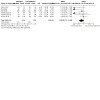
Comparison 1: Platinum vs non‐platinum regimens, Outcome 1: Overall survival
1.2. Analysis.
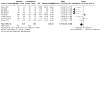
Comparison 1: Platinum vs non‐platinum regimens, Outcome 2: Progression‐free survival/time to progression
1.3. Analysis.
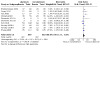
Comparison 1: Platinum vs non‐platinum regimens, Outcome 3: Objective tumour response rate (assessable participants)
Summary of findings and assessment of the certainty of the evidence
We used the GRADE system (Guyatt 2011) to rate the quality of evidence relating to the estimated treatment effects on OS, PFS/TTP and OTRR, as well as on rates of treatment‐related death, nausea/vomiting, anaemia, hair loss, leukopaenia and treatment discontinuation due to adverse events. GRADE criteria for assessing quality of evidence include study design, risk of bias, inconsistency, indirectness, imprecision, suspected publication bias and other considerations. Assessments of these criteria and corresponding justifications are provided in three 'Summary of findings' tables, largely created using GRADEproGDT (GradeproGDT). We performed GRADE assessments separately for selected subgroups related to inconsistency (i.e. heterogeneity) among effect estimates.
Results
Description of studies
Results of the search
We reviewed 1199 unique records identified by the 2019 database searches (Figure 1). Of these, we excluded 1177 based on information in the title or abstract. We considered 11 records from trial registries or protocol publications to be potentially relevant. These were ongoing studies that have not yet published results (see Characteristics of ongoing studies). For the remaining 11 records, we retrieved full‐text articles or abstracts for further examination. We excluded five of the 11 articles or abstracts because they were review articles, but we examined their bibliographies to search for additional relevant studies. We excluded one other full‐text article for reasons outlined in the Characteristics of excluded studies table. We re‐assessed studies included in our previous review (Egger 2017) for inclusion in the current review.
1.

Review 2020: study flow diagram.
Included studies
We included 10 studies with 13 treatment‐comparisons in this review.
Of these 13 treatment‐comparisons, eight were identified from our previous review (Egger 2017): three with the same mTNBC‐specific results reported in our previous review (Bhattacharyya 2009; Carey 2012; Fan 2012) and five with new or updated mTNBC‐specific results (Icli 2005; Stemmler 2011 A; Stemmler 2011 B; Tutt 2018; Zhang 2018). The other five treatment‐comparisons were identified by our September 2019 search (Han 2018 A; Han 2018 B; Mustafa 2019; Yardley 2018 A; Yardley 2018 B).
Of the 13 treatment‐comparisons included in this review (Table 5):
3. Number of treatment‐comparisons by subgroup and three outcomes.
| Outcome | ||||
| Subgroup |
Treatment‐ comparisons N |
Overall survival n (% of N) |
Progression ‐free survival/time to progression n (% of N) |
Objective tumour response rate n (% of N) |
| Overall: | 13 | 6 (46%) | 8 (62%) | 10 (77%) |
| Type of regimen comparison: | ||||
| Regimen A + platinum agent vs regimen A | 2 | 1 (50%) | 1 (50%) | 2 (100%) |
| Regimen A + platinum agent vs regimen B | 9 | 4 (44%) | 5 (56%) | 7 (78%) |
| Single agent platinum vs regimen C | 2 | 1 (50%) | 2 (100%) | 1 (50%) |
| Type of platinum agent in platinum arm: | ||||
| Cisplatin in platinum arm | 7 | 2 (29%) | 2 (29%) | 6 (86%) |
| Carboplatin in platinum arm | 6 | 4 (67%) | 6 (100%) | 4 (67%) |
| First‐line therapy: | ||||
| First‐line therapy for > 80% of patients | 6 | 5 (83%) | 5 (83%) | 6 (100%) |
| Second‐ or third‐line therapy for >=20% of patients | 7 | 1 (14%) | 3 (43%) | 4 (57%) |
| Anthracycline in regimens: | ||||
| No anthracycline in platinum or non‐platinum regimens | 13 | 6 (46%) | 8 (62%) | 10 (77%) |
| Taxane in regimens: | ||||
| No taxane in platinum or non‐platinum regimens | 4 | 1 (25%) | 1 (25%) | 4 (100%) |
| Platinum + taxane vs non‐platinum + taxane regimens | 2 | 2 (100%) | 2 (100%) | 2 (100%) |
| Platinum + non‐taxane vs non‐platinum + taxane regimens | 5 | 3 (60%) | 3 (60%) | 4 (80%) |
| Platinum + taxane vs non‐platinum + non‐taxane regimens | 2 | (0%) | 2 (100%) | (0%) |
| BRCA1/2 subtype: | ||||
| Germline BRCA1/2 mutation # | 4 | 1 (25%) | 4 (100%) | 2 (50%) |
| Germline BRCA1/2 wild‐type # | 2 | 1 (50%) | 2 (100%) | 2 (100%) |
| Homologous recombination deficiency status: | ||||
| Homologous recombination deficient # | 2 | 1 (50%) | 2 (100%) | 2 (100%) |
| Not homologous recombination deficient # | 2 | 1 (50%) | 2 (100%) | 2 (100%) |
^Numbers for each outcome are the number of treatment‐comparison with sufficient data to be included in meta‐analysis for that outcome.
# BRCA1/2 subtype and homologous recombination deficiency status were within‐study subgroupings for Tutt 2018 and Zhang 2018; hence Tutt 2018 and Zhang 2018 both contributed to both BRCA1/2 subroups and both homologous recombination deficiency status subgroups.
two (15%) compared 'regimen A + platinum versus regimen A,' nine (69%) compared 'regimen A + platinum versus regimen B' and 2 (15%) compared single agent platinum versus regimen C' (Table 5);
seven (54%) used cisplatin and 6 (46%) used carboplatin as the platinum agent in the intervention arm (Table 5 and Table 6);
six (46%) had more than 80% of participants receiving first‐line therapy;
all 13 (100%) had no anthracycline in the platinum or non‐platinum regimens (consequently, the anthracycline subgroup meta‐analysis was not performed);
four (31%) had no taxane in the platinum or non‐platinum regimens; two (15%) had a taxane in both regimens, five (38%) had a taxane in the non‐platinum regimen only and two (15%) had a taxane in the platinum regimen only;
four (31%) had germline BRCA1/2 mutation subgroup results and two (13%) had BRCA1/2 wild‐type subgroup results; and
two (15%) were homologous recombination deficient and two (15%) were not homologous recombination deficient.
4. Summary of regimens included in the analysis.
| Trials ID | Arm 1(platinum‐containing) | Arm 2(control) | First‐line therapy for > 80% of participants | Majority participants anthracycline‐naive |
| Regimen A + platinum vs regimen A | ||||
| Bhattacharyya 2009 | (Endoxan + with 'cisplatinum') | (Endoxan) | N | N |
| Carey 2012 | C + Cb (Cetuximab + carboplatin) | C (Cetuximab with carboplatin added after progression) | N | N |
| Regimen A + platinum vs regimen B | ||||
| Fan 2012 | TP (docetaxel + cisplatin) | TX (docetaxel + capecitabine) | Y | N |
| Mustafa 2019 | (cisplatin + gemcitabine) | (paclitaxel + gemcitabine) | Y | N |
| Han 2018 A | PCP (placebo + carboplatin/paclitaxel) | VT (veliparib + temozolomide) | N | Unknown |
| Han 2018 B | VCP (eliparib + carboplatin/paclitaxel) | VT (veliparib + temozolomide) | N | Unknown |
| Stemmler 2011 A | GemCis (gemcitabine + cisplatin) | GemVin (gemcitabine + vinorelbine) | N | N |
| Stemmler 2011 B | GemCis (gemcitabine + cisplatin) | GemCap (gemcitabine + capecitabine) | N | N |
| Yardley 2018 A | nab‐P/C (nab‐paclitaxel + carboplatin) | nab‐P/G (nab‐paclitaxel + gemcitabine) | Y | N |
| Yardley 2018 B | G/C (gemcitabine + carboplatin) | nab‐P/G (nab‐paclitaxel + gemcitabine) | Y | N |
| Zhang 2018 | (cisplatin + gemcitabine) | (paclitaxel + gemcitabine) | Y | N |
| Icli 2005 | Etop + Cis (etoposide + cisplatin) | P (paclitaxel) | N | N |
| Single agent platinum vs regimen C | ||||
| Tutt 2018 | C (carboplatin) | D (docetaxel) | Y | Y |
Not all studies provided sufficient information on all outcomes for inclusion in meta‐analyses. Of the 13 treatment‐comparisons:
six (46%), eight (62%) and 10 (77%) had sufficient data to be included in the meta‐analyses of effect estimates for OS, PFS/TTP and OTRR, respectively (Table 5 and Figure 1); and
five (38%), three (23%), zero (0%), five (38%), two (15%), five (38%) and five (38%) had sufficient data to be included in the meta‐analyses of effect estimates for treatment‐related death, nausea/vomiting, nephrotoxicity, anaemia, hair loss, leukopaenia, and treatment discontinuation due to adverse events, respectively (Table 7 and Figure 1).
5. Summary of outcomes for included trials.
| Trial ID | OS data useable for HR estimation for mTNBC patients1 | MedianOS time for mTNBC patients2 | PFS/TTP data useable for HR estimation for mTNBC patients1 | Median PFS/TTP time for mTNBC patients2 | Objective tumour response for mTNBC patients | Treatment‐related deaths for mTNBC patients | Grade III & IV Toxicity for mTNBC patients | Analysed3 |
| Regimen A + platinum vs regimen A | ||||||||
| Bhattacharyya 2009 | NR | Y | NR | Y | Y | NR | NR | 126 |
| Carey 2012 | Y | Y | Y | NR | Y | NR | Not useable for meta‐analysis | 102 |
| Regimen A + platinum vs regimen B | ||||||||
| Fan 2012 | Y | Y | Y | Y | Y | Y | Nausea/vomiting Anaemia Leukopaenia Treatment‐discontinuation |
53 |
| Mustafa 2019 | NR | NR | NR | Y | Y | NR | Not useable for meta‐analysis | 110 |
| Han 2018 A | NR | NR | Y | NR | NR | NR | NR | 60 |
| Han 2018 B | NR | NR | Y | NR | NR | NR | NR | 59 |
| Stemmler 2011 A | NR | NR | NR | NR | Y | NR | NR | 15 |
| Stemmler 2011 B | NR | NR | NR | NR | Y | NR | NR | 21 |
| Yardley 2018 A | Y | Y | Y | Y | Y | Y | Anaemia Leukopaenia Treatment‐discontinuation |
95 |
| Yardley 2018 B | Y | Y | Y | Y | Y | Y | Anaemia Leukopaenia Treatment‐discontinuation |
96 |
| Zhang 2018 | Y | NR | Y | Y | Y | Y | Nausea/vomiting Anaemia Hair loss Leukopaenia Treatment‐discontinuation |
236 |
| Icli 2005 | NR | Y | NR | Y | N | Y | Nausea/vomiting Anaemia Leukopaenia |
0 |
| Single agent platinum vs regimen C | ||||||||
| Tutt 2018 | Y | Y | Y | Y | Y | Y | Nausea/vomiting Anaemia Hair loss Leukopaenia Treatment‐discontinuation |
376 |
1Sufficient data reported to estimate a HR for pooling as outlined by Parmar 1998 and Tierney 2007; this includes Kaplan‐Meier curve, HR and standard error/confidence interval or logrank statistics 2Trials that did not explicitly report median time were classified as NR here regardless of estimable median time from Kaplan‐Meier curve 3Analysed numbers represent the maximum numbers of participants in the treatment‐comparison that were included in a meta‐analysis of OS, PFS/TTP or OTRR (assessable participants).
DU: deaths unexplained NR: not reported at all or not reported for mTNBC subgroup OS: overall survival PFS: progression‐free survival TTP: time to progression Y: year reported
No studies reported QoL or TTF results for women with mTNBC.
Excluded studies
Eight studies may have appeared to have met the eligibility criteria but were deemed ineligible for reasons given in the Characteristics of excluded studies table.
Risk of bias in included studies
Figure 2 shows a summary of the 'Risk of bias' judgements for each 'Risk of bias' domain of the included treatment‐comparisons. Reasons for each judgement are detailed for each treatment‐comparison in the Characteristics of included studies table. For each 'Risk of bias' domain, a summary of the general risk of bias for results of the included studies was as follows.
2.
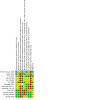
Risk of bias summary: review authors' judgements about each risk of bias item for each included study.
Allocation
All 10 studies, reporting 13 treatment‐comparisons, were described as randomised. The method of random sequence generation was described sufficiently to be judged at low risk of bias for this domain in six treatment‐comparisons (Bhattacharyya 2009; Carey 2012; Tutt 2018; Yardley 2018 A; Yardley 2018 B; Zhang 2018). The remaining seven treatment‐comparisons were judged to be at unclear risk of bias for random sequence generation, as the information available was insufficient to accurately assess this domain.
Five of the 13 treatment‐comparisons described central randomisation systems, and were thus judged to be at low risk of bias for treatment allocation concealment (Icli 2005; Tutt 2018; Yardley 2018 A; Yardley 2018 B; Zhang 2018). The remaining seven treatment‐comparisons did not adequately describe methods of concealment and were thus judged as having unclear risk of bias for this domain.
Blinding
Eleven treatment‐comparisons were described as "nonblinded," "not blinded," "single blind" or "open‐label" (Carey 2012; Fan 2012; Han 2018 A; Han 2018 B; Icli 2005; Stemmler 2011 A; Stemmler 2011 B; Tutt 2018; Yardley 2018 A; Yardley 2018 B; Zhang 2018). These 11 'unblinded' treatment‐comparisons were judged to be at high risk of 'performance bias' due to the lack of blinding of participants and personnel to the treatment being administered. The remaining two treatment‐comparisons were judged as at unclear risk of performance bias because of a lack of information needed to make a firm conclusion. It seemed highly likely, however, that these two treatment‐comparisons would have also been 'unblinded,' as open‐label studies are common in phase III oncology trials.
All 12 treatment‐comparisons known to have OS as a study outcome (including six not included in OS meta‐analyses; but excluding Mustafa 2019, which did not assess OS as an outcome) were judged to be at low risk of bias from a lack of blinding of outcome assessors, regardless of actual blinding. This is because death certification was unlikely to have been affected by any lack of blinding.
For outcomes other than OS and QoL, two treatment‐comparisons were judged to be at low risk of bias from a lack of blinding of outcome assessors due to these outcomes being measured or confirmed through formal assessments including imaging, biochemical tests and/or the involvement of an independent clinical or radiological review group (Carey 2012; Icli 2005). Three treatment‐comparisons were judged to be at high risk of bias from a lack of blinding of outcome assessors (Tutt 2018; Yardley 2018 A; Yardley 2018 B). The remaining eight treatment‐comparisons provided insufficient detail on outcome assessments and were thus classified as having an unclear risk of bias.
Incomplete outcome data
Five treatment‐comparisons excluded randomised participants who never started treatment or who were subsequently found to have been 'ineligible' from time‐to‐event analyses (mITT analyses) (Carey 2012; Han 2018 A; Han 2018 B; Icli 2005; Zhang 2018). These five treatment‐comparisons were judged to be at unclear risk of attrition bias for time‐to‐event outcomes. The remaining eight treatment‐comparisons were judged to be at low risk of attrition bias for time‐to‐event outcomes because all randomised participants were analysed in the groups to which they were randomised (ITT analysis).
Two treatment‐comparisons had more than 15% of participants not assessed or not assessable for at least one binary outcome, and were thus judged to be at high risk of attrition bias for binary outcomes (Stemmler 2011 A; Stemmler 2011 B). Five treatment‐comparisons had less than 10% of participants not assessed or not assessable for all binary outcomes, and were thus judged to be at low risk of attrition bias for binary outcomes (Fan 2012; Mustafa 2019; Yardley 2018 A; Yardley 2018 B; Zhang 2018). The remaining six treatment‐comparisons were judged to be at unclear risk of attrition bias for binary outcomes (10% to 15% of participants not assessed or not assessable for at least one binary outcome, or it was unclear what proportion were not assessed).
Selective reporting
The assessment of risk of bias from selective reporting included cross‐checking the outcomes for which there were published results against the stated outcomes reported in trial registers and published protocols. In our assessment of risk of bias from selective reporting, studies that began recruiting participants on or after July 1, 2005 were expected have a clinical registration or published protocol specifying the study outcomes, or we deemed them to be at high risk of bias from selective reporting. We chose July 1, 2005 as our early limit because the International Committee of Medical Journal Editors (ICMJE) made a seminal announcement in September 2004 that clinical trials that begin recruiting on or after July 1, 2005 would not be considered for publication unless they were included on a clinical trials registry (De Angelis 2005). Studies included in this review that began recruiting participants before July 1, 2005 and which did not have a trial registration or published protocol pre‐specifying study outcomes, were assumed to be at unclear risk of bias from selective reporting, unless additional evidence suggested otherwise.
Four treatment‐comparisons from three studies were judged to be at low risk of bias from the selective reporting of outcomes (Carey 2012; Yardley 2018 A; Yardley 2018 B; Zhang 2018). Each of these studies was included on a clinical trials registry and their prespecified outcomes either matched those in the trial reports or non‐matches were considered to be relatively minor. Eight treatment‐comparisons were judged to be at high risk of bias from the selective reporting of outcomes. Of these eight treatment‐comparisons: Bhattacharyya 2009 indicated in the abstract that toxicity was recorded, but did not report results; there was no trial registration or published protocol containing the study's prespecified outcomes). Fan 2012 and Mustafa 2019 did not have a trial registration or published protocol, despite recruitment beginning after July 1, 2005. Han 2018 A/Han 2018 B, Icli 2005 and Stemmler 2011 A/Stemmler 2011 B did not report all outcomes specified in their protocol for the mTNBC subgroup analysis. We judged the remaining treatment‐comparison (Tutt 2018) to be at unclear risk of bias from the selective reporting of outcomes because while the protocol‐specified outcomes of TTP and TTF were not reported, the similar outcome of PFS was reported.
Egger's tests for funnel plot asymmetry indicated some evidence consistent with the presence of publication bias or small‐study effects, or both, for PFS/TTP (P = 0.02; Figure 3) but not for OS (P = 0.08; Figure 4) or OTRR (P = 0.12; Figure 5).
3.
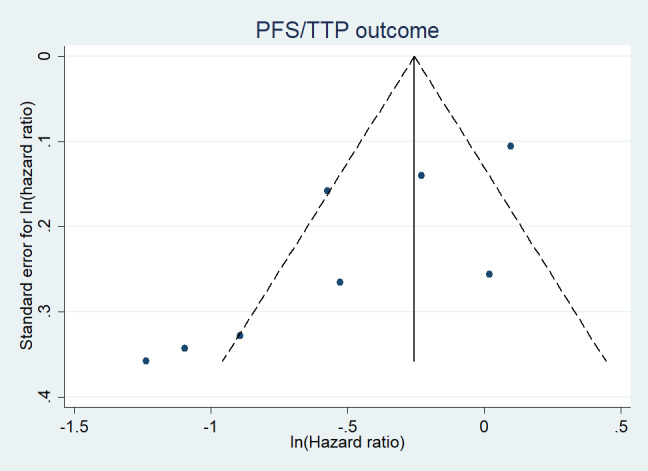
Funnel plot for PFS/TTP (Progression‐free survival/time to progression). Assessing publication bias and/or small‐study effects. Plot includes all treatment‐comparisons with data for PFS/TTP that could be included in meta‐analysis. The plot suggests some level of asymmetry (Egger's test P value = 0.02).
4.
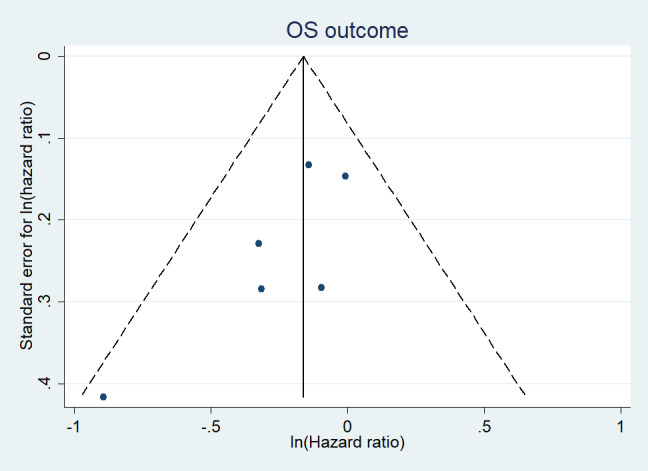
Funnel plot for overall survival (OS). Assessing publication bias and/or small‐study effects. Plot includes all treatment‐comparisons with data for OS that could be included in meta‐analysis.. The plot does not show substantial asymmetry (Egger's test P value = 0.08)
5.
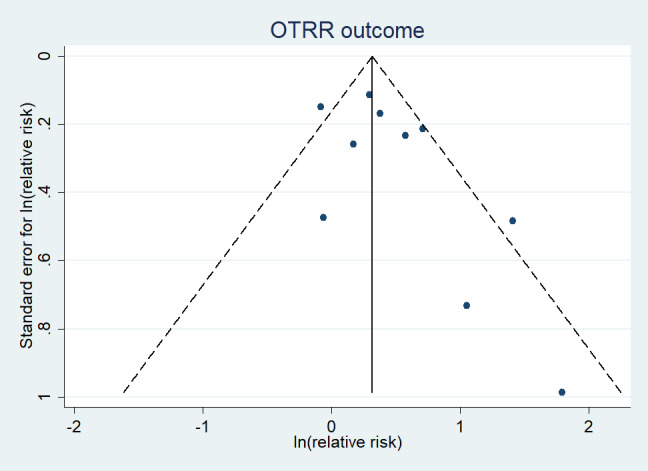
Funnel plot for objective tumour response rate (OTRR). Assessing publication bias and/or small‐study effects. Plot includes all treatment‐comparisons with data for OTRR that could be included in meta‐analysis. The plot does not show asymmetry (Egger's test P value = 0.12).
Other potential sources of bias
Eight treatment‐comparisons were judged to be at unclear risk of 'other bias' (Carey 2012; Han 2018 A; Han 2018 B; Mustafa 2019; Tutt 2018; Yardley 2018 A; Yardley 2018 B; Zhang 2018) for various reasons outlined in the Characteristics of included studies table. The remaining five treatment‐comparisons were judged to be at low risk of 'other bias.'
Effects of interventions
Please refer to Table 1
Overall survival
Twelve of the 13 included treatment‐comparisons assessed OS as an outcome; six provided sufficient OS data specific to mTNBC patients for pooling in meta‐analyses. From these six treatment‐comparisons, 958 of 972 randomised participants were analysed representing 99% of randomised participants in these treatment‐comparisons (and there were about 573 deaths). Pooled analysis indicated a 15% lower rate of death for women receiving platinum‐containing regimens compared to those receiving non‐platinum regimens (HR 0.85, 95% CI 0.73 to 1.00; P = 0.05; heterogeneity P = 0.41, I2 = 1%; moderate‐quality evidence) (Analysis 1.1; Figure 6). Subgroup analyses of OS indicated no evidence of subgroup differences (P values ranged from P = 0.19 to P = 0.89; see Analysis 2.1; Analysis 3.1; Analysis 4.1; Analysis 5.1; Analysis 6.1; Analysis 7.1).
6.
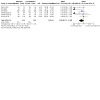
Forest plot of comparison: 1 Platinum vs non‐platinum regimens, outcome: 1.1 Overall survival.
2.1. Analysis.
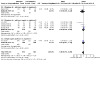
Comparison 2: Platinum vs non‐platinum regimens (subgroup analysis 1: by type of regimen comparison), Outcome 1: Overall survival
3.1. Analysis.
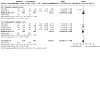
Comparison 3: Platinum vs non‐platinum regimens (subgroup analysis 2: by type of platinum agent in platinum arm), Outcome 1: Overall survival
4.1. Analysis.
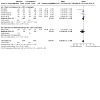
Comparison 4: Platinum vs non‐platinum regimens (subgroup analysis 3: by first‐line therapy), Outcome 1: Overall survival
5.1. Analysis.
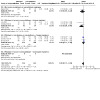
Comparison 5: Platinum vs non‐platinum regimens (subgroup analysis 4: by taxane in regimens), Outcome 1: Overall survival
6.1. Analysis.
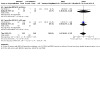
Comparison 6: Platinum vs non‐platinum regimens (subgroup analysis 5: BRCA1/2 mutation status), Outcome 1: Overall survival
7.1. Analysis.
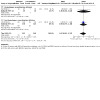
Comparison 7: Platinum vs non‐platinum regimens (subgroup analysis 6: homologous recombination deficient status), Outcome 1: Overall survival
PFS/TTP
All 13 included treatment‐comparisons assessed PFS or TTP, or both, as an outcome; eight provided sufficient mTNBC‐specific data for pooling in meta‐analyses of the composite outcome of PFS/TTP. From these eight treatment‐comparisons, 1077 out of 1092 (99%) randomised participants were analysed (with approximately 909 events). Pooled analysis indicated platinum‐containing regimens were associated with better PFS/TTP (HR 0.77, 95% CI 0.68 to 0.88; P < 0.0001), although the quality of the evidence was very low. This was due to marked evidence of heterogeneity (P < 0.0001; I2 = 80%) (Analysis 1.2; Figure 7), the use of PFS/TTP is a surrogate endpoint and suspected publication bias (Table 1).
7.
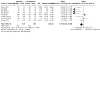
Forest plot of comparison: 1 Platinum vs non‐platinum regimens, outcome: 1.2 Progression‐free survival/time to progression.
Evidence of subgroup differences in the pooled HRs of subgroups was found in four of the six subgroup analyses involving PFS/TTP:
comparing 'regimen A + platinum versus regimen A' (HR 0.56, 95% CI 0.41 to 0.77; n = 1); 'regimen A + platinum versus regimen B' (HR 0.68, 95% CI 0.55 to 0.82; heterogeneity P = 0.007, I2 = 71%; n = 5); and 'single agent platinum versus regimen C' (HR 1.00, 95% CI 0.83 to 1.22; heterogeneity P = 0.004, I2 = 88%; n = 2) (P = 0.002 for subgroup difference) (Analysis 2.2);
comparing first‐line therapy for > 80% of participants (HR 0.89, 95% CI 0.77 to 1.04; heterogeneity P = 0.002, I2 = 77%; n = 5); and second‐ or third‐line therapy for ≥ 20% of participants (HR 0.50, 95% CI 0.38 to 0.64; heterogeneity P = 0.32, I2 = 13%; n = 3) (P < 0.0001 for subgroup difference) (Analysis 4.2);
with no taxane in platinum or non‐platinum regimens (HR 0.56, 95% CI 0.41to 0.77; n = 1); a taxane in both the platinum and non‐platinum regimens (HR 0.46, 95% CI 0.30 to 0.70; heterogeneity P = 0.11, I2 = 61%; n = 2); a taxane in the non‐platinum regimen only (HR 0.98, 95% CI 0.84 to 1.15; heterogeneity P = 0.17, I2 = 43%; n = 3); and a taxane in the platinum regimen only (HR 0.37, 95% CI 0.23 to 0.59; heterogeneity P = 0.67, I2 = 0%; n = 2) (P < 0.00001 for subgroup difference) (Analysis 5.2);
with women with germline BRCA 1/2 mutation (HR 0.43, 95% CI 0.30 to 0.62; heterogeneity P = 0.73, I2 = 0%; n = 4); compared to women with germline BRCA 1/2 wild‐type (HR 1.14, 95% CI 0.93 to 1.40; heterogeneity P = 0.18, I2 = 45%; n = 2). (P < 0.00001 for subgroup difference) (Analysis 6.2).
2.2. Analysis.
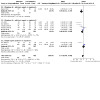
Comparison 2: Platinum vs non‐platinum regimens (subgroup analysis 1: by type of regimen comparison), Outcome 2: Progression‐free survival/time to progression
4.2. Analysis.
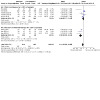
Comparison 4: Platinum vs non‐platinum regimens (subgroup analysis 3: by first‐line therapy), Outcome 2: Progression‐free survival/time to progression
5.2. Analysis.
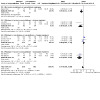
Comparison 5: Platinum vs non‐platinum regimens (subgroup analysis 4: by taxane in regimens), Outcome 2: Progression‐free survival/time to progression
6.2. Analysis.
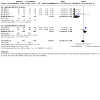
Comparison 6: Platinum vs non‐platinum regimens (subgroup analysis 5: BRCA1/2 mutation status), Outcome 2: Progression‐free survival/time to progression
The two other subgroup analyses showed no evidence of subgroup differences (P values ranged from P = 0.14 to P = 0.75; see Analysis 3.2; Analysis 7.2).
3.2. Analysis.
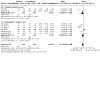
Comparison 3: Platinum vs non‐platinum regimens (subgroup analysis 2: by type of platinum agent in platinum arm), Outcome 2: Progression‐free survival/time to progression
7.2. Analysis.
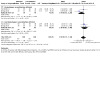
Comparison 7: Platinum vs non‐platinum regimens (subgroup analysis 6: homologous recombination deficient status), Outcome 2: Progression‐free survival/time to progression
TTF
None of the 13 included treatment‐comparisons assessed TTF as an outcome.
OTRR: assessable participants
All 13 included treatment‐comparisons assessed OTRR as an outcome; 10 provided sufficient OTRR data specific to mTNBC patients for pooling in meta‐analyses. From the 10 treatment‐comparisons, 1205 out of 1244 (97%) randomised participants were assessable for tumour response (and 529 had a complete or partial response). Women receiving platinum‐containing regimens had 40% better OTRR than women receiving non‐platinum regimens (RR 1.40, 95% CI 1.22 to 1.59, P < 0.00001), but the quality of the evidence was low because of evidence of heterogeneity (P = 0.01; I2 = 58%) (Analysis 1.3; Figure 8) and because OTRR is a surrogate endpoint (Table 1).
8.
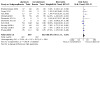
Forest plot of comparison: 1 Platinum vs non‐platinum regimens, outcome: 1.3 Objective tumour response rate (assessable participants).
Evidence of subgroup differences in the pooled RRs of subgroups were found in five of the six OTRR subgroup analyses:
comparing 'regimen A + platinum versus regimen A' (RR 2.14, 95% CI 1.42 to 3.23; heterogeneity P = 0.64, I2 = 0%; n = 2); 'regimen A + platinum versus regimen B' (RR 1.51, 95% CI 1.29 to 1.77; heterogeneity P = 0.14, I2 = 38%; n = 7); and 'single agent platinum versus regimen C' (RR 0.92, 95% CI 0.69 to 1.23; n = 1) (P = 0.003 for subgroup difference) (Analysis 2.3);
using cisplatin (RR 1.61, 95% CI 1.36 to 1.89; heterogeneity P = 0.05, I2 = 54%; n = 6); and carboplatin (RR 1.16, 95% CI 0.93 to 1.44; heterogeneity P = 0.06, I2 = 59%; n = 4) (P = 0.02 for subgroup difference) (Analysis 3.3);
comparing first‐line therapy for > 80% of participants (RR 1.30, 95% CI 1.13 to 1.50; heterogeneity P = 0.02, I2 = 63%; n = 6); and second‐ or third‐line therapy for ≥ 20% of participants (RR 2.05, 95% CI 1.42 to 2.96; heterogeneity P = 0.25, I2 = 27%; n = 4) (P = 0.02 for subgroup difference) (Analysis 4.3);
with no taxane in the platinum or non‐platinum regimens (RR 2.05, 95% CI 1.42 to 2.96; heterogeneity P = 0.25, I2 = 27%; n = 4); a taxane in both platinum and non‐platinum regimens (RR 2.23, 95% CI 1.48 to 3.38; heterogeneity P = 0.11, I2 = 61%; n = 2); a taxane in the non‐platinum regimen only (RR 1.18, 95% CI 1.02 to 1.38; heterogeneity P = 0.13, I2 = 47%; n = 4) (P = 0.001 for subgroup difference) (Analysis 5.3);
with women with germline BRCA 1/2 mutation (RR 2.09, 95% CI 1.17 to 3.72; heterogeneity P = 0.89, I2 = 0%; n = 2); compared to women with germline BRCA 1/2 wild‐type (RR 0.90, 95% CI 0.71 to 1.15; heterogeneity P = 0.05, I2 = 74%; n = 2) (P = 0.008 for subgroup difference) (Analysis 6.3).
2.3. Analysis.

Comparison 2: Platinum vs non‐platinum regimens (subgroup analysis 1: by type of regimen comparison), Outcome 3: Objective tumour response rate (assessable participants)
3.3. Analysis.
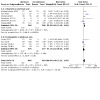
Comparison 3: Platinum vs non‐platinum regimens (subgroup analysis 2: by type of platinum agent in platinum arm), Outcome 3: Objective tumour response rate (assessable participants)
4.3. Analysis.
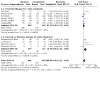
Comparison 4: Platinum vs non‐platinum regimens (subgroup analysis 3: by first‐line therapy), Outcome 3: Objective tumour response rate (assessable participants)
5.3. Analysis.
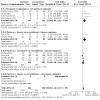
Comparison 5: Platinum vs non‐platinum regimens (subgroup analysis 4: by taxane in regimens), Outcome 3: Objective tumour response rate (assessable participants)
6.3. Analysis.
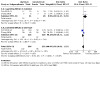
Comparison 6: Platinum vs non‐platinum regimens (subgroup analysis 5: BRCA1/2 mutation status), Outcome 3: Objective tumour response rate (assessable participants)
The other subgroup analyses showed no evidence of subgroup differences (P = 0.30 for Analysis 7.3).
7.3. Analysis.
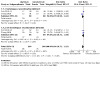
Comparison 7: Platinum vs non‐platinum regimens (subgroup analysis 6: homologous recombination deficient status), Outcome 3: Objective tumour response rate (assessable participants)
Toxicity: safety populations
Please refer to Table 2
Treatment‐related death
Five of the 13 included treatment‐comparisons reported treatment‐related death for mTNBC patients and provided sufficient data for extraction. Of these five treatment‐comparisons, two had non‐estimable RRs due to no treatment‐related deaths and thus did not contribute to the pooled estimates. For the three remaining treatment‐comparisons, 554 out of 567 (98%) randomised women were included in the safety populations, with six treatment‐related deaths. There was no evidence of a difference between platinum and non‐platinum regimens in terms of treatment‐related death but the quality of evidence was low because the confidence interval was very wide (RR 1.06, 95% CI 0.24 to 4.61; Analysis 3.4) (Table 2). There was no evidence of heterogeneity (P = 0.69; I2 = 0%).
3.4. Analysis.
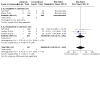
Comparison 3: Platinum vs non‐platinum regimens (subgroup analysis 2: by type of platinum agent in platinum arm), Outcome 4: Treatment‐related death (safety population)
It was not possible to perform subgroup analyses according to the type of platinum agent used, as the two cisplatin treatment‐comparisons had non‐estimable RRs, due to no treatment‐related deaths.
Nausea/vomiting
Three of the 13 included treatment‐comparisons reported grade 3 and 4 nausea/vomiting for mTNBC patients with sufficient data for extraction. Of these three treatment‐comparisons, 655 out of 669 (98%) randomised women were included in the safety populations with 31 cases of grade 3 or 4 nausea/vomiting. Risk of grade 3 or 4 nausea/vomiting was nearly five times higher among women receiving platinum‐containing regimens (RR 4.77, 95% CI 1.93 to 11.81; P = 0.0007) but the quality of evidence was deemed low because the confidence interval was very wide. There was no evidence of heterogeneity (P = 0.32, I2 = 12%) (Analysis 3.5).
3.5. Analysis.

Comparison 3: Platinum vs non‐platinum regimens (subgroup analysis 2: by type of platinum agent in platinum arm), Outcome 5: Nausea/vomiting (safety population)
There was little evidence of difference in pooled RRs according to the type of platinum agent used (P = 0.15).
Nephrotoxicity
None of the 13 included treatment‐comparisons reported grade 3 and 4 nephrotoxicity for mTNBC patients.
Anaemia
Five of the 13 included treatment‐comparisons reported grade 3 and 4 anaemia in mTNBC patients and provided sufficient data for extraction. Of these five treatment‐comparisons, one had a non‐estimable RR due to no grade 3 and 4 anaemia and thus did not contribute to the pooled estimates. For the three remaining treatment‐comparisons, 790 out of 807 (98%) randomised women were included in the safety populations, with 86 cases of grade 3 and 4 anaemia. Risk of grade 3 or 4 anaemia was nearly four times higher among women receiving platinum‐containing regimens (RR 3.80, 95% CI 2.25 to 6.42; P < 0.00001) (Analysis 3.6), but the quality of evidence was deemed low because the confidence interval was wide and there was some evidence of heterogeneity (P = 0.04; I2 = 65%).
3.6. Analysis.
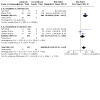
Comparison 3: Platinum vs non‐platinum regimens (subgroup analysis 2: by type of platinum agent in platinum arm), Outcome 6: Anaemia (safety population)
Subgroup analysis showed weak evidence indicating that the increased risk of grade 3 or 4 anaemia for platinum recipients (compared to non‐platinum recipients) was worse for cisplatin recipients compared to carboplatin recipients (P = 0.06).
Hair loss
Two of the 13 included treatment‐comparisons assessed grade 3 and 4 hair loss for mTNBC patients and reported sufficient data for extraction. One of these two treatment‐comparisons had a non‐estimable RR due to there being no grade 3 or 4 cases. For the one remaining treatment‐comparison, 366 out of 376 (97%) randomised women were included in the safety population, with one case of grade 3 or 4 hair loss. There was no evidence that the risk of grade 3 or 4 hair loss was different for women receiving platinum‐containing regimens (RR 0.33, 95% CI 0.01 to 8.04) (Analysis 3.7), but the quality of evidence was low because the confidence interval was very wide.
3.7. Analysis.

Comparison 3: Platinum vs non‐platinum regimens (subgroup analysis 2: by type of platinum agent in platinum arm), Outcome 7: Hair loss (safety population)
Leukopaenia
Five of the 13 included treatment‐comparisons assessed grade 3 and 4 leukopaenia for mTNBC patients and reported sufficient data for extraction. One treatment‐comparison had a non‐estimable RR due to there being no grade 3 or 4 cases of leukopaenia. For the four remaining treatment‐comparisons, 790 out of 807 (98%) randomised women were included in the safety populations, with 131 cases of grade 3 or 4 leukopaenia. There was no evidence of a difference in risk of grade 3 or 4 leukopaenia between platinum and non‐platinum containing regimens (RR 1.09, 95% CI 0.84 to 1.42, P = 0.52). The quality of evidence was deemed moderate because the confidence interval was wide. There was no evidence of heterogeneity (P = 0.75, I2 = 0%) (Analysis 3.8).
3.8. Analysis.
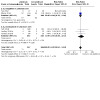
Comparison 3: Platinum vs non‐platinum regimens (subgroup analysis 2: by type of platinum agent in platinum arm), Outcome 8: Leukopenia (safety population)
There was no evidence of differences in pooled RRs according to the type of platinum agent used (P = 0.44).
Treatment discontinuation due to adverse events
Five of the 13 included treatment‐comparisons assessed treatment discontinuation due to adverse events and reported sufficient data for extraction. One treatment‐comparison had a non‐estimable RR due to there being no treatment discontinuations. For the four remaining treatment‐comparisons, 790 out of 807 (98%) randomised women were included in the safety populations, with 89 treatment discontinuations. There was no evidence of a difference in risk of treatment discontinuations between platinum and non‐platinum containing regimens (RR 0.88, 95% CI 0.59 to 1.32, P = 0.55). The quality of evidence was deemed moderate because the confidence interval was wide. There was some evidence of heterogeneity (P = 0.07, I2 = 57%) (Analysis 3.9).
3.9. Analysis.
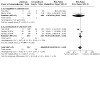
Comparison 3: Platinum vs non‐platinum regimens (subgroup analysis 2: by type of platinum agent in platinum arm), Outcome 9: Treatment discontinuation due to adverse event (safety population)
There was no evidence of differences in pooled RRs according to the type of platinum agent used (P = 0.63).
QoL
None of the 13 included treatment‐comparisons reported QoL outcomes for mTNBC patients.
Sensitivity analyses
The benefit of platinum regimens over non‐platinum regimens in terms of PFS/TTP was more pronounced for treatment‐comparisons not included in the OS meta‐analysis (HR 0.37, 95% CI 0.23 to 0.59; n = 2) than for treatment‐comparisons included the OS meta‐analysis (HR 0.82, 95% CI 0.72 to 0.94; n = 6) (P = 0.001 for subgroup difference) (Analysis 8.1). Similarly, the benefit of platinum regimens over non‐platinum regimens in terms of OTRR was marginally more pronounced for treatment‐comparisons not included in the OS meta‐analysis (RR 1.70, 95% CI 1.33 to 2.18; n = 4) than for treatment‐comparisons included the OS meta‐analysis (RR 1.30, 95% CI 1.11 to 1.52; n = 6) (P = 0.07 for subgroup difference) (Analysis 8.2). Together these results provide some suggestion that the absence of some treatment‐comparisons (namely Bhattacharyya 2009; Han 2018 A; Han 2018 B; Mustafa 2019; Stemmler 2011 A; Stemmler 2011 B) from the OS meta‐analysis may have, if anything, lead to an underestimate of the benefit of platinum regimens in terms of OS.
Stratifying PFS/TTP estimates according to whether the outcome was PFS or TTP suggested that platinum chemotherapy was more beneficial in terms of TTP than PFS (P = 0.03), although this difference was based on only one treatment‐comparison in the TTP group (Analysis 9.1).
Repeating Analysis 1.1, Analysis 1.2 and Analysis 1.3 using random‐effects methods did not appreciably change the pooled estimates (Analysis 10.1; Analysis 10.2 and Analysis 10.3).
Of the 13 treatment‐comparisons included in this review, five were results from trials not specifically assessing mTNBC patients (i.e. mTNBC patients were part of a subgroup analysis; Han 2018 A; Han 2018 B; Icli 2005; Stemmler 2011 A; Stemmler 2011 B). Of these five treatment‐comparisons, four were included in meta‐analyses (Han 2018 A and Han 2018 B were included in meta‐analyses for PFS/TTP and Stemmler 2011 A and Stemmler 2011 B were included in meta‐analyses for OTRR). Sensitivity analysis indicated that the two very small treatment‐comparisons Stemmler 2011 Aand Stemmler 2011 B had very little influence on the original OTRR pooled estimate (RR 1.40, 95% CI 1.22 to 1.59 when including Stemmler 2011 Aand Stemmler 2011 B and RR 1.39, 95% CI 1.21 to 1.59 after excluding Stemmler 2011 Aand Stemmler 2011 B) (Analysis 11.3). With regard to Han 2018 A and Han 2018 B, sensitivity analysis indicated that these two treatment‐comparisons had PFS/TTP effect estimates more favourable to platinum than those of the other six treatment‐comparisons in the PFS/TTP meta‐analyses (P = 0.001; Analysis 11.2). Despite this, the PFS/TTP pooled estimate did not change appreciably when Han 2018 A and Han 2018 B were excluded (HR 0.77, 95% CI 0.68 to 0.88 when including Han 2018 A and Han 2018 B and HR 0.82, 95% CI 0.72 to 0.94 after excluding Han 2018 A and Han 2018 B). These results suggest our main findings were not appreciably affected by the inclusion of trials in which the analysis of mTNBC patients was part of a subgroup analysis.
Removal of the trial that used a drug which is now widely considered to be ineffective in the treatment of breast cancer (Carey 2012) had little effect on the OS, PFS/TTP and OTRR point estimates of effect (Analysis 12.1; Analysis 12.2; Analysis 12.3).
8.1. Analysis.
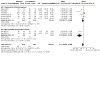
Comparison 8: Platinum vs non‐platinum regimens (sensitivity analysis 1: included in OS meta‐analysis vs. not included in OS meta‐analysis), Outcome 1: Progression‐free survival/time to progression
8.2. Analysis.

Comparison 8: Platinum vs non‐platinum regimens (sensitivity analysis 1: included in OS meta‐analysis vs. not included in OS meta‐analysis), Outcome 2: Objective tumour response rate (assessable participants)
9.1. Analysis.
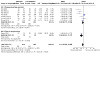
Comparison 9: Platinum vs non‐platinum regimens (sensitivity analysis 2: Progression‐free survival vs. time to progression), Outcome 1: Progression‐free survival vs time to progression
10.1. Analysis.
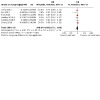
Comparison 10: Platinum vs non‐platinum regimens (sensitivity analysis 3: Analyses 1 repeated but with random‐effects approach), Outcome 1: Overall survival
10.2. Analysis.
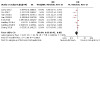
Comparison 10: Platinum vs non‐platinum regimens (sensitivity analysis 3: Analyses 1 repeated but with random‐effects approach), Outcome 2: Progression‐free survival/time to progression
10.3. Analysis.
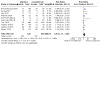
Comparison 10: Platinum vs non‐platinum regimens (sensitivity analysis 3: Analyses 1 repeated but with random‐effects approach), Outcome 3: Objective tumour response rate (assessable participants)
11.3. Analysis.
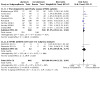
Comparison 11: Platinum vs non‐platinum regimens (sensitivity analysis 4: mTNBC patients selected for trial vs. a subgroup of trial), Outcome 3: Objective tumour response rate (assessable participants)
11.2. Analysis.
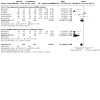
Comparison 11: Platinum vs non‐platinum regimens (sensitivity analysis 4: mTNBC patients selected for trial vs. a subgroup of trial), Outcome 2: Progression‐free survival/time to progression
12.1. Analysis.
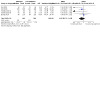
Comparison 12: Platinum vs non‐platinum regimens (sensitivity analysis 5: Analyses 1 repeated but with Carey 2012 excluded), Outcome 1: Overall survival
12.2. Analysis.
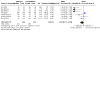
Comparison 12: Platinum vs non‐platinum regimens (sensitivity analysis 5: Analyses 1 repeated but with Carey 2012 excluded), Outcome 2: Progression‐free survival/time to progression
12.3. Analysis.
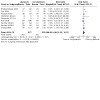
Comparison 12: Platinum vs non‐platinum regimens (sensitivity analysis 5: Analyses 1 repeated but with Carey 2012 excluded), Outcome 3: Objective tumour response rate (assessable participants)
Discussion
Summary of main results
Consistent with the findings of the mTNBC subgroup analysis in our previous review (Egger 2017), we found in our current review a marginal OS benefit from platinum‐containing regimens compared to non‐platinum regimens. Specifically, data from six treatment‐comparisons included in the OS meta‐analysis showed a 15% reduction in the risk of death for recipients of platinum‐containing regimens compared to recipients of non‐platinum regimens (P = 0.05). In absolute terms, this 15% risk reduction corresponded to about 55 fewer deaths at one year after metastatic diagnosis for every 1000 mTNBC participants who received platinum‐containing chemotherapy, and about 59 fewer deaths at two years (Table 1). Supporting the observed benefit from platinum in terms of OS, platinum‐containing regimens also reduced the risk of death and/or progression (PFS/TTP) by about 23% (P < 0.0001) and increased the likelihood of achieving a complete or partial response (OTRR) by about 40% (P < 0.00001). Moreover, sensitivity analyses suggested that the absence of some treatment‐comparisons from the OS meta‐analysis may have led to an underestimate of the benefit of platinum regimens in terms of OS. While we found a number of statistically significant subgroup differences for OTRR and PFS/TTP (see Effects of interventions), it is difficult to judge the importance or reliability of these findings, given that similar differences were not observed in relation to OS.
It is worth noting that the largest trial, Tutt 2018 did not find an OS, PFS or OTRR advantage for women with mTNBC receiving carboplatin (versus docetaxel). However, in subgroup analysis restricted to 43 BRCA1/2 positive participants, Tutt 2018 found carboplatin was associated with significantly better OTRRs and PFS/TTP. Of the 43 BRCA1/2 positive participants, only 14 (33%) had TNBC, and the remaining 29 (66%) were ER positive, PgR positive and/or HER2 positive (the more common breast cancer clinical subtypes). This suggests that the apparent benefits of platinum for mTNBC patients might be, at least in part, due to the presence of BRCA1/2 mutations in many mTNBC patients, rather than due to the triple‐negative subtype. Furthermore, in the only included trial where 100% of participants were BRCA1/2 positive (Han 2018 A/Han 2018 B), subgroup analysis indicated that the PFS benefits from the two platinum regimens were similar between mTNBC patients and non‐mTNBC patients. Taken together, the findings of Tutt 2018 and Han 2018 A/Han 2018 B and the significant subgroup differences according to BRCA1/2 germline mutation status for PFS/TTP and OTRR (which also included results from Zhang 2018) highlight the importance of performing BRCA1/2 subgroup analysis in future trials assessing platinum chemotherapies for mTNBC patients.
In addition to the BRCA1/2 findings of Tutt 2018, the trial is noteworthy in that it was the largest in this review, it did not find an OS advantage for women with mTNBC receiving carboplatin, and the platinum group performed worst (relative to control) among all trials in this review in terms of PFS and OTRR. Moreover, much of the observed heterogeneity for the PFS and OTRR outcomes appears to be driven by the estimates from Tutt 2018. While it is not clear why the platinum arm faired relatively poorly in Tutt 2018, the trial was the only one to use single agent platinum (carboplatin) in the intervention arm and the only trial to use single agent docetaxel in the control arm.
Another subgroup finding of interest was that the relative benefits of platinum in terms of PFS/TTP and OTRR were greater for trials with 'second‐ or third‐line therapy for ≥ 20% of patients' than for trials with 'first‐line therapy for > 80% of patients' (although this subgroup difference was not observed for the OS outcome). This finding suggests that platinum based regimens may be an effective treatment option following first‐line therapy for mTNBC.
Assessments of toxicity showed that women receiving platinum‐containing regimens experienced higher rates of grade 3 and 4 nausea/vomiting and anaemia than women receiving non‐platinum regimens, but no differences between treatment groups in terms of treatment related death, or grade 3 and 4 hair loss, leukopaenia and treatment discontinuation due to adverse event. In general, however, relatively few intervention‐comparisons could be included in meta‐analyses for adverse events. Better evidence of the toxicity of platinum regimens compared to non‐platinum regimens can be found in our previous analysis (Egger 2017) of adverse events in women with metastatic breast cancer unselected for TNBC. In this regard, our previous review indicated that women receiving platinum‐containing regimens experienced higher rates of grade 3 and 4 nausea/vomiting, anaemia and leukopaenia. More specifically, the higher rate of grade 3 and 4 nausea/vomiting was associated with cisplatin but not carboplatin use, and the increased risk of grade 3 and 4 anaemia was higher for cisplatin recipients than for carboplatin recipients. However, it is likely that newer antiemetics might now lessen the severity of cisplatin‐associated nausea and vomiting. In addition, our previous review also reported that women receiving platinum‐containing regimens experienced a higher rate of grade 3 and 4 hair loss than women receiving non‐platinum regimens. This finding, however, probably relates more to the partner chemotherapy agent than to the platinum itself, as single agent platinum chemotherapies tend not to cause much hair loss.
Overall completeness and applicability of evidence
This review includes data from 10 studies relating to 13 treatment‐comparisons, with publications years ranging from 2005 to 2018. Of the 13 treatment‐comparisons, six (46%), eight (62%) and 10 (77%) provided sufficient data to be included in OS, PFS/TTP and OTRR meta‐analyses, respectively. In general, the number of treatment‐comparisons that had sufficient data on adverse events for mTNBC patients was low, including treatment‐related death (n = 5; 38%), nausea/vomiting (n = 3; 75%), nephrotoxicity (n = 0; 0%), anaemia (n = 5; 38%), hair loss (n = 2; 15%), leukopaenia (n = 5; 38%) and treatment discontinuation due to adverse events (n = 5; 38%). The evidence relating to treatment effects on QoL was wholly incomplete, with no studies reporting QoL results for mTNBC patients.
Although data for the most important outcome (OS) could be included in meta‐analysis for 46% of treatment‐comparisons, the evidence would clearly be more complete if OS data were available for all treatment‐comparisons. Nonetheless, it is somewhat reassuring that in sensitivity analyses, the treatment‐comparisons with PFS/TTP or OTRR data that were not included in the OS meta‐analysis tended to show a greater benefit to platinum in terms of PFS/TTP and/or OTRR results than the six treatment‐comparisons included in the OS meta‐analysis. This provides some evidence that the 'overall' pooled effect estimate for OS was unlikely to show less benefit to platinum if OS data had been available for all 12 treatment‐comparisons that were included in one or more meta‐analyses.
The evidence in this review appears to be generally applicable to the current practice of the treatment of mTNBC for a number of reasons. First, the platinum and non‐platinum regimens used in the included trials contained commonly used chemotherapy drugs currently used in clinical practice to treat metastatic breast cancer including cyclophosphamide, methotrexate and various taxanes. On the other hand, the applicability of the evidence is somewhat reduced by the fact that no trials included an anthracycline (a commonly used class of drug for the treatment mTNBC) in their non‐platinum regimens. Second, the review included trials of women receiving first‐line treatment and women receiving treatment after failure of previous anthracycline or taxane regimens. Third, the trials in the review used the two most commonly used platinum agents for treating metastatic breast cancer, carboplatin and cisplatin. Fourth, this review and our previous review (Egger 2017) are, to date, the only reviews to use meta‐analysis to synthesise the evidence from RCTs assessing whether platinum‐based chemotherapies improved OS for mTNBC participants.
Quality of the evidence
We downgraded the quality of the evidence for the OS effect estimate by one level resulting in moderate‐quality evidence. This was due to imprecision (the CI for the pooled estimate was wide and close to the null) (Table 1). This rating of moderate‐quality evidence for OS has improved from low‐quality evidence in our previous review (Egger 2017) because the largest study (Tutt 2018) has now published previously unpublished OS results. This lowered the risk of publication bias for the OS pooled estimate. The quality of the evidence ratings for PFS/TTP and OTRR were downgraded one level for indirectness (because the outcome is a surrogate endpoint) and one level for inconsistency (because there was substantial evidence of heterogeneity). The rating for PFS/TTP was further downgraded one level for suspected publication bias (forest plot asymmetry). As a consequence, we judged the quality of the evidence to be very low for PFS/TTP and low for OTRR.
We graded the quality of evidence for treatment effect estimates of seven key toxicity outcomes (Table 2). We judged the quality of evidence to be low for treatment‐related death, nausea/vomiting, anaemia and hair loss. Evidence quality was moderate for leukopaenia and treatment discontinuation due to adverse events. As mentioned above, however, because few treatment‐comparisons could be included in meta‐analyses for adverse events, better evidence of the toxicity of platinum regimens compared to non‐platinum regimens should be found in our previous analysis (Egger 2017) of adverse events in women with metastatic breast cancer unselected for TNBC. However, many studies in that analysis were older trials.
Potential biases in the review process
There were a number of potential biases in the review process. First, it is possible that we may not have identified every eligible study with published results, study protocol or clinical trial registration. This seems unlikely, however, given our highly sensitive search strategies, including access to the Cochrane Breast Cancer Specialised Register maintained by the Cochrane Breast Cancer Group. Second, as with all systematic reviews of clinical trials, there is a risk of reporting bias arising from completed trials that never published their (largely) negative findings (i.e. publication bias). In this review, however, all but one of the included studies were conducted in an era when non‐publication of negative findings was less likely (i.e. due to increasing pressures to pre‐register clinical trials and publish results within reasonable time‐frames). Third, it is possible that trials not specifically assessing mTNBC patients might be more inclined to publish significant mTNBC results from a subgroup analysis that was not pre‐specified in the trial protocol or trial registration. In this review, however, sensitivity analyses indicated that our main results were not appreciably affected by the inclusion of trials in which the analysis of mTNBC patients was part of a post‐hoc subgroup analysis.
Agreements and disagreements with other studies or reviews
Included in the mTNBC subgroup meta‐analyses of our previous review (Egger 2017) were three treatment‐comparisons of 391 women for OS, three treatment‐comparisons of 391 women for PFS/TTP and five treatment‐comparisons of 878 women for OTRR. In the current review, these numbers increased to six treatment‐comparisons of 958 women for OS, eight treatment‐comparisons of 1077 women for PFS/TTP and 10 treatment‐comparisons of 1205 women for OTRR.
In our previous review, we found that for women with mTNBC, platinum‐containing regimens provided benefits in terms of OS (HR 0.75, 95% CI 0.57 to 1.00; low‐quality evidence), PFS/TTP (HR 0.59, 95% CI 0.49 to 0.72; low‐quality evidence) and OTRR (RR 1.33, 95% CI 1.13 to 1.56; low‐quality evidence). In the current review, we found similar, but smaller, benefits for platinum recipients in terms of OS (HR 0.85, 95% CI 0.73 to 1.00; moderate‐quality evidence) and PFS/TTP (HR 0.77, 95% CI 0.68 to 0.88; 1077 women; very low‐quality evidence), and similar, but slightly larger, benefits for platinum recipients in terms of OTRR (RR 1.40, 95% CI 1.22 to 1.59; low‐quality evidence). As a general statement, the findings in this review are similar to the mTNBC‐specific findings in our previous review.
To our knowledge, there is only one other systematic review of randomised trials comparing the effects of platinum and non‐platinum‐containing regimens among participants with mTNBC (Guan 2015). That review, however, only performed meta‐analyses of tumour response rates and not time‐to‐event outcomes. The OTRR meta‐analysis in Guan 2015 comprised three of the 10 mTNBC treatment‐comparisons included in the current review (Bhattacharyya 2009; Carey 2012; Fan 2012). The inclusion of seven additional treatment‐comparisons in the current review resulted in a pooled OTRR estimate of effect (RR 1.40, 95% CI 1.22 to 1.59) that is significantly lower than that of Guan 2015 (RR 2.42, 95% CI 1.66 to 3.53).
While another systematic review also found significant OS and PFS benefits for mTNBC patients who received platinum (Kaya 2018), this review included observational studies and did report RCT‐specific results.
Authors' conclusions
Implications for practice.
The main findings in this review are broadly similar to the mTNBC subgroup findings in our previous review (Egger 2017). In particular, this review found moderate‐quality evidence of a small survival benefit from platinum‐based regimens for women with mTNBC. While it remains unclear whether the possible benefits for women with mTNBC are related to the type of platinum agent, evidence from our previous review suggested that carboplatin was generally associated with less toxicity than cisplatin. Given the similarity of the findings in this review with those from our previous review, we find no compelling reason for changing our previous conclusions. That is, we believe the current evidence suggests that it may be premature to recommend widespread use of platinum‐based regimens for mTNBC patients given the excess toxicity associated with such regimens. Nonetheless, some women and clinicians may consider platinum‐based regimens worth trying given that nausea and vomiting can be manageable with modern antiemetics, and that carboplatin can be a less toxic alternative to cisplatin.
Implications for research.
Our finding of a small survival benefit from platinum‐based regimens for women with mTNBC was based on moderate‐quality evidence from only six trials with 958 women; hence, additional randomised trials are necessary to confirm this finding. In addition, as we discuss above, BRCA1/2 subgroup results suggest that a useful line of research might be BRCA1/2 testing and subgroup analysis in future trials assessing platinum chemotherapies for mTNBC patients.
What's new
| Date | Event | Description |
|---|---|---|
| 7 December 2020 | Amended | Analysis 5.3 has been reformatted in the PDF. |
History
Review first published: Issue 10, 2020
| Date | Event | Description |
|---|---|---|
| 27 September 2019 | New citation required but conclusions have not changed | The current review updates the evidence on platinum‐based chemotherapy for women with metastatic triple‐negative breast cancer. The refinement in scope of this review update takes into account new trials assessing treatments based on more detailed breast cancer biology. In the previous version of this review, evidence relating to women with triple‐negative metastatic breast cancer was part of a subgroup analysis. |
| 27 September 2019 | New search has been performed | Ten studies were included in this review. A further 11 'ongoing studies' have been identified. |
| 23 August 2017 | New search has been performed | The effect of platinum‐containing regimens for women with metastatic breast cancer is generally well established. The results in the 2016 review update are consistent with findings of the previous review, mainly in women without triple‐negative breast cancer. In the future, however, the scope of this review topic will be modified and likely involve an assessment of platinum‐containing regimens in women with a specific subtype of breast cancer (that is, triple‐negative breast cancer or BRCA mutation and metastatic breast cancer). Such a topic will be classified as a new review in the Cochrane Library. |
| 28 May 2015 | New search has been performed | Performed searches for new studies on 28 May 2015. Twelve new studies with 15 new treatment‐comparisons were included in this review update, adding 2327 (analysed) participants since the original 2004 version of this review. Risk of bias was assessed for all domains. New subgroup analyses have been added to this review update in response to new hypotheses and available subgroups. The measure of effect for proportion (dichotomous) outcomes has been changed from odds ratio to risk ratio for ease of interpretation |
| 28 May 2015 | New citation required and conclusions have changed | Conclusions are largely unchanged although there is now preliminary, low‐quality evidence of a survival benefit from platinum‐containing chemotherapy regimens compared to non‐platinum regimens for women with metastatic triple negative breast cancer |
| 19 April 2012 | Amended | Additional table linked to text. |
| 4 August 2008 | Amended | Converted to new review format. |
| 25 February 2004 | New citation required and conclusions have changed | First review publication |
Acknowledgements
We would like to thank the peer‐reviewers and editors who gave feedback for this review update: Brent O'Carrigan (external clinical reviewer), Annabel Goodwin (clinical editor), Sandra Finestone (consumer reviewer), Nora Carbine (consumer reviewer) and Kerry Dwan (statistical reviewer).
For the current and previous review versions, we would like to thank Ava Tan‐Koay, Anne Parkhill, Fergus Tai and Slavica Berber for conducting the review search strategy and Mingming Zhang and Miao Yu for their assistance with translation. For previous versions, we would like to acknowledge the contribution made to the original concept for this review by thanking Craig Henderson, Kathleen Pritchard, Martin Tattersall, Martin Stockler, Christine Brunswick, Roldano Fossati, Alessandro Liberati and Anna Nowak. We would also like to acknowledge the contribution of authors of previous reviews that led to the current review: Melina Willson, Jenna Morgan, Harriet Walker, Sue Carrick, Davina Ghersi.
Appendices
Appendix 1. CENTRAL
MeSH descriptor: [Breast Neoplasms] explode all trees
breast near neoplasm*
breast near carcinoma*
breast near cancer*
breast near tumour*
breast near tumor*
#1 or #2 or #3 or #4 or #5 or #6
platinum or cisplatin or cisplatinum or Oxaliplatin or Carboplatin
MeSH descriptor: [Platinum] explode all trees
MeSH descriptor: [Cisplatin] explode all trees
MeSH descriptor: [Platinum Compounds] explode all trees
MeSH descriptor: [Carboplatin] explode all trees
#8 or #9 or #10 or #11
#7 and #13
Appendix 2. MEDLINE (via OvidSP)
| 1 | randomized controlled trial.pt. |
| 2 | controlled clinical trial.pt. |
| 3 | randomized.ab. |
| 4 | placebo.ab. |
| 5 | Clinical Trials as Topic/ |
| 6 | randomly.ab. |
| 7 | trial.ti. |
| 8 | (crossover or cross‐over).tw. |
| 9 | Pragmatic Clinical Trials as Topic/ |
| 10 | pragmatic clinical trial.pt. |
| 11 | or/1‐10 |
| 12 | exp Breast Neoplasms/ |
| 13 | advanced breast cancer$.tw,sh. |
| 14 | advanced breast neoplasm$.tw,sh. |
| 15 | advanced breast carcinoma$.tw,sh. |
| 16 | advanced breast tumo?r$.tw,sh. |
| 17 | metastatic breast cancer$.tw,sh. |
| 18 | metastatic breast neoplasm$.tw,sh. |
| 19 | metastatic breast carcinoma$.tw,sh. |
| 20 | metastatic breast tumo?r$.tw,sh. |
| 21 | exp Triple Negative Breast Neoplasms/ |
| 22 | Triple Negative Breast cancer$.tw,sh. |
| 23 | Triple Negative Breast neoplasm$.tw,sh. |
| 24 | Triple Negative Breast carcinoma$.tw,sh. |
| 25 | Triple Negative Breast tumo?r$.tw,sh. |
| 26 | or/12‐25 |
| 27 | exp Cisplatin/ |
| 28 | exp Carboplatin/ |
| 29 | cisplatinum.mp. |
| 30 | carboplat*.mp. |
| 31 | exp Organoplatinum Compounds/ |
| 32 | exp Platinum/ |
| 33 | platinum compound*.tw. |
| 34 | platinum containing regime*.tw. |
| 35 | (platin* or diamminedicholoroplatinum or cis‐diamminedichloroplatinum or cis‐dichlorodiammineplatinum or biocisplatinum or dichlorodiammineplatinum or nsc‐119875 or platidiam or paraplatin or cis‐platinum or carboplatinum or cyclobutanedicarboxylato or jm‐8 or cbdca or nsc‐241240).mp. |
| 36 | (Carboplatin or Blastocarb or Carboplat or Carboplatin Hexal or Carboplatino or Carbosin or Carbosol or Carbotec or CBDCA or Displata or Ercar or Nealorin or Novoplatinum or Paraplat or Paraplatin AQ or Paraplatin or Paraplatine or Platinwas or Ribocarbo).mp. |
| 37 | (Cisplatin or Abiplatin or Blastolem or Briplatin or CACP or CDDP or cis‐DDP or cis‐diamminedichloridoplatinum or cis‐diamminedichloro platinum II or cis‐diamminedichloroplatinum or Cis‐dichloroammine Platinum II or Cismaplat or Cisplatina or cisplatinous diamine dichloride or cis‐platinum II diamine dichloride or cis‐platinum II or cis‐platinum or Cisplatyl).mp. |
| 38 | (Citoplatino or Citosin or CPDD or Cysplatyna or DDP or Lederplatin or Metaplatin or Neoplatin or PDD or Peyrone's Chloride or Peyrone's Salt or Placis or Platamine or Platiblastin or Platiblastin‐S or Platinex or Platinol‐AQ or Platinol or Platinol‐ AQ VHA Plus or Platinol‐AQ or Platinoxan or platinum diamminodichloride or Platiran or Platistin or Platosin).mp. |
| 39 | (Oxaliplatin or Ai Heng or Aiheng or diaminocyclohexane oxalatoplatinum or oxalatoplatin or oxalatoplatinum or oxaliplatine or Eloxatin or Dacotin or Dacplat or Eloxatine or 1‐OHP or L‐OHP or oxaliplatin medac).mp. |
| 40 | or/27‐39 |
| 41 | 11 and 26 and 40 |
| 42 | Animals/ not humans/ |
| 43 | 41 not 42 |
Appendix 3. Embase (via OvidSPa)
| 1 | Randomized controlled trial/ |
| 2 | Controlled clinical study/ |
| 3 | Random$.ti,ab. |
| 4 | randomization/ |
| 5 | intermethod comparison/ |
| 6 | placebo.ti,ab. |
| 7 | (compare or compared or comparison).ti. |
| 8 | (open adj label).ti,ab. |
| 9 | ((double or single or doubly or singly) adj (blind or blinded or blindly)).ti,ab. |
| 10 | double blind procedure/ |
| 11 | parallel group$1.ti,ab. |
| 12 | (crossover or cross over).ti,ab. |
| 13 | ((assign$ or match or matched or allocation) adj5 (alternate or group$1 or intervention$1 or patient$1 or subject$1 or participant$1)).ti,ab. |
| 14 | (assigned or allocated).ti,ab. |
| 15 | (controlled adj7 (study or design or trial)).ti,ab. |
| 16 | (volunteer or volunteers).ti,ab. |
| 17 | trial.ti. |
| 18 | or/1‐17 |
| 19 | exp breast cancer/ |
| 20 | breast cancer$.tw,sh. |
| 21 | advanced breast cancer$.tw,sh. |
| 22 | advanced breast carcinoma$.tw,sh. |
| 23 | advanced breast neoplasm$.tw,sh. |
| 24 | advanced breast tumo?r$.tw,sh. |
| 25 | exp metastatic breast cancer/ |
| 26 | metastatic breast cancer$.tw,sh. |
| 27 | metastatic breast carcinoma$.tw,sh. |
| 28 | metastatic breast neoplasm$.tw,sh. |
| 29 | metastatic breast tumo?r$.tw,sh. |
| 30 | exp triple negative breast cancer/ |
| 31 | triple negative breast cancer$.tw,sh. |
| 32 | Triple Negative Breast carcinoma$.tw,sh. |
| 33 | Triple Negative Breast neoplasm$.tw,sh. |
| 34 | Triple Negative Breast tumo?r$.tw,sh. |
| 35 | or/21‐34 |
| 36 | (19 or 20) and 35 |
| 37 | exp cisplatin/ |
| 38 | exp carboplatin/ |
| 39 | exp platinum complex/ |
| 40 | exp platinum/ |
| 41 | exp oxaliplatin/ |
| 42 | exp platinum derivative/ |
| 43 | platinum containing regime*.tw. |
| 44 | (platin* or diamminedicholoroplatinum or cis‐diamminedichloroplatinum or cis‐dichlorodiammineplatinum or biocisplatinum or dichlorodiammineplatinum or nsc‐119875 or platidiam or paraplatin or cis‐platinum or carboplatinum or cyclobutanedicarboxylato or jm‐8 or cbdca or nsc‐241240).mp. |
| 45 | (Carboplatin or Blastocarb or Carboplat or Carboplatin Hexal or Carboplatino or Carbosin or Carbosol or Carbotec or CBDCA or Displata or Ercar or Nealorin or Novoplatinum or Paraplat or Paraplatin AQ or Paraplatin or Paraplatine or Platinwas or Ribocarbo).mp. |
| 46 | (Cisplatin or Abiplatin or Blastolem or Briplatin or CACP or CDDP or cis‐DDP or cis‐diamminedichloridoplatinum or cis‐diamminedichloro platinum II or cis‐diamminedichloroplatinum or Cis‐dichloroammine Platinum II or Cismaplat or Cisplatina or cisplatinous diamine dichloride or cis‐platinum II diamine dichloride or cis‐platinum II or cis‐platinum or Cisplatyl).mp. |
| 47 | (Citoplatino or Citosin or CPDD or Cysplatyna or DDP or Lederplatin or Metaplatin or Neoplatin or PDD or Peyrone's Chloride or Peyrone's Salt or Placis or Platamine or Platiblastin or Platiblastin‐S or Platinex or Platinol‐AQ or Platinol or Platinol‐ AQ VHA Plus or Platinol‐AQ or Platinoxan or platinum diamminodichloride or Platiran or Platistin or Platosin).mp. |
| 48 | (Oxaliplatin or Ai Heng or Aiheng or diaminocyclohexane oxalatoplatinum or oxalatoplatin or oxalatoplatinum or oxaliplatine or Eloxatin or Dacotin or Dacplat or Eloxatine or 1‐OHP or L‐OHP or oxaliplatin medac).mp. |
| 49 | or/37‐48 |
| 50 | 18 and 36 and 49 |
| 51 | limit 50 to (human and (conference abstracts or embase)) |
Appendix 4. WHO ICTRP Search Portal
Basic Searches:
1. Platinum‐containing regimens for metastatic breast cancer 2. Metastatic breast cancer AND platinum 3. Advanced breast cancer AND platinum 4. Triple negative breast cancer AND platinum
Advanced Searches:
1. Condition: metastatic breast cancer OR advanced breast cancer OR triple negative breast cancer Intervention: platinum‐containing regime% OR platinum compound% OR platinum% OR cisplatin OR carboplatin OR platin% OR cisplatinum OR carboplatinum OR platinum diamminodichloride OR cis‐diamminedicholoroplatinum OR oxaliplatin Recruitment Status: ALL
2. Condition: metastatic breast cancer OR advanced breast cancer OR triple negative breast cancer Intervention: biocisplatinum OR dichlorodiammineplatinum OR nsc‐119875 OR platidiam OR platino OR platinol OR paraplatin OR cis‐diamminedichloroplatinum OR cis‐platinum OR cyclobutanedicarboxylato OR cbdca OR jn‐8 OR nsc‐241240 Recruitment Status: ALL
Appendix 5. ClinicalTrials.gov
Basic Searches:
1. Condition or disease: Metastatic breast cancer Other terms: platinum 2. Condition or disease: Advanced breast cancer Other terms: platinum 3. Condition or disease: Triple negative breast cancer Other terms: platinum
Advanced Searches:
1. Condition or disease: metastatic breast cancer OR advanced breast cancer OR triple negative breast cancer Intervention/treatment: platinum‐containing regime% OR platinum compound% OR platinum% OR cisplatin OR carboplatin OR platin% OR cisplatinum OR carboplatinum OR platinum diamminodichloride OR cis‐diamminedicholoroplatinum OR oxaliplatin Study type: All Study results: All
2. Condition or disease: metastatic breast cancer OR advanced breast cancer OR triple negative breast cancer Intervention/treatment: biocisplatinum OR dichlorodiammineplatinum OR nsc‐119875 OR platidiam OR platino OR platinol OR paraplatin OR cis‐diamminedichloroplatinum OR cis‐platinum OR cyclobutanedicarboxylato OR cbdca OR jn‐8 OR nsc‐241240 Study type: All Study results: All
Data and analyses
Comparison 1. Platinum vs non‐platinum regimens.
| Outcome or subgroup title | No. of studies | No. of participants | Statistical method | Effect size |
|---|---|---|---|---|
| 1.1 Overall survival | 6 | 958 | (Exp[(O‐E) / V], Fixed, 95% CI) | 0.85 [0.73, 1.00] |
| 1.2 Progression‐free survival/time to progression | 8 | 1077 | (Exp[(O‐E) / V], Fixed, 95% CI) | 0.77 [0.68, 0.88] |
| 1.3 Objective tumour response rate (assessable participants) | 10 | 1205 | Risk Ratio (M‐H, Fixed, 95% CI) | 1.40 [1.22, 1.59] |
Comparison 2. Platinum vs non‐platinum regimens (subgroup analysis 1: by type of regimen comparison).
| Outcome or subgroup title | No. of studies | No. of participants | Statistical method | Effect size |
|---|---|---|---|---|
| 2.1 Overall survival | 6 | 958 | (Exp[(O‐E) / V], Fixed, 95% CI) | 0.85 [0.73, 1.00] |
| 2.1.1 Regimen A + platinum agent vs regimen A | 1 | 102 | (Exp[(O‐E) / V], Fixed, 95% CI) | 0.72 [0.46, 1.13] |
| 2.1.2 Regimen A + platinum agent vs regimen B | 4 | 480 | (Exp[(O‐E) / V], Fixed, 95% CI) | 0.87 [0.70, 1.09] |
| 2.1.3 Single agent platinum vs regimen C | 1 | 376 | (Exp[(O‐E) / V], Fixed, 95% CI) | 0.87 [0.67, 1.13] |
| 2.2 Progression‐free survival/time to progression | 8 | 1077 | (Exp[(O‐E) / V], Fixed, 95% CI) | 0.77 [0.68, 0.88] |
| 2.2.1 Regimen A + platinum agent vs regimen A | 1 | 102 | (Exp[(O‐E) / V], Fixed, 95% CI) | 0.56 [0.41, 0.77] |
| 2.2.2 Regimen A + platinum agent vs regimen B | 5 | 539 | (Exp[(O‐E) / V], Fixed, 95% CI) | 0.68 [0.55, 0.82] |
| 2.2.3 Single agent platinum vs regimen C | 2 | 436 | (Exp[(O‐E) / V], Fixed, 95% CI) | 1.00 [0.83, 1.22] |
| 2.3 Objective tumour response rate (assessable participants) | 10 | 1205 | Risk Ratio (M‐H, Fixed, 95% CI) | 1.40 [1.22, 1.59] |
| 2.3.1 Regimen A + platinum agent vs regimen A | 2 | 222 | Risk Ratio (M‐H, Fixed, 95% CI) | 2.14 [1.42, 3.23] |
| 2.3.2 Regimen A + platinum agent vs regimen B | 7 | 607 | Risk Ratio (M‐H, Fixed, 95% CI) | 1.51 [1.29, 1.77] |
| 2.3.3 Single agent platinum vs regimen C | 1 | 376 | Risk Ratio (M‐H, Fixed, 95% CI) | 0.92 [0.69, 1.23] |
Comparison 3. Platinum vs non‐platinum regimens (subgroup analysis 2: by type of platinum agent in platinum arm).
| Outcome or subgroup title | No. of studies | No. of participants | Statistical method | Effect size |
|---|---|---|---|---|
| 3.1 Overall survival | 6 | 958 | (Exp[(O‐E) / V], Fixed, 95% CI) | 0.85 [0.73, 1.00] |
| 3.1.1 Cisplatin in platinum arm | 2 | 289 | (Exp[(O‐E) / V], Fixed, 95% CI) | 0.90 [0.69, 1.18] |
| 3.1.2 Carboplatin in platinum arm | 4 | 669 | (Exp[(O‐E) / V], Fixed, 95% CI) | 0.83 [0.68, 1.00] |
| 3.2 Progression‐free survival/time to progression | 8 | 1077 | (Exp[(O‐E) / V], Fixed, 95% CI) | 0.77 [0.68, 0.88] |
| 3.2.1 Cisplatin in platinum arm | 2 | 289 | (Exp[(O‐E) / V], Fixed, 95% CI) | 0.69 [0.54, 0.90] |
| 3.2.2 Carboplatin in platinum arm | 6 | 788 | (Exp[(O‐E) / V], Fixed, 95% CI) | 0.80 [0.69, 0.93] |
| 3.3 Objective tumour response rate (assessable participants) | 10 | 1205 | Risk Ratio (M‐H, Fixed, 95% CI) | 1.40 [1.22, 1.59] |
| 3.3.1 Cisplatin in platinum arm | 6 | 552 | Risk Ratio (M‐H, Fixed, 95% CI) | 1.61 [1.36, 1.89] |
| 3.3.2 Carboplatin in platinum arm | 4 | 653 | Risk Ratio (M‐H, Fixed, 95% CI) | 1.16 [0.93, 1.44] |
| 3.4 Treatment‐related death (safety population) | 5 | 843 | Risk Ratio (M‐H, Fixed, 95% CI) | 1.06 [0.24, 4.61] |
| 3.4.1 Cisplatin in platinum arm | 2 | 289 | Risk Ratio (M‐H, Fixed, 95% CI) | Not estimable |
| 3.4.2 Carboplatin in platinum arm | 3 | 554 | Risk Ratio (M‐H, Fixed, 95% CI) | 1.06 [0.24, 4.61] |
| 3.5 Nausea/vomiting (safety population) | 3 | 655 | Risk Ratio (M‐H, Fixed, 95% CI) | 4.77 [1.93, 11.81] |
| 3.5.1 Cisplatin in platinum arm | 2 | 289 | Risk Ratio (M‐H, Fixed, 95% CI) | 10.89 [2.08, 56.90] |
| 3.5.2 Carboplatin in platinum arm | 1 | 366 | Risk Ratio (M‐H, Fixed, 95% CI) | 2.47 [0.79, 7.74] |
| 3.6 Anaemia (safety population) | 5 | 843 | Risk Ratio (M‐H, Fixed, 95% CI) | 3.80 [2.25, 6.42] |
| 3.6.1 Cisplatin in platinum arm | 2 | 289 | Risk Ratio (M‐H, Fixed, 95% CI) | 6.50 [2.86, 14.77] |
| 3.6.2 Carboplatin in platinum arm | 3 | 554 | Risk Ratio (M‐H, Fixed, 95% CI) | 2.27 [1.11, 4.62] |
| 3.7 Hair loss (safety population) | 2 | 602 | Risk Ratio (M‐H, Fixed, 95% CI) | 0.33 [0.01, 8.04] |
| 3.7.1 Cisplatin in platinum arm | 1 | 236 | Risk Ratio (M‐H, Fixed, 95% CI) | Not estimable |
| 3.7.2 Carboplatin in platinum arm | 1 | 366 | Risk Ratio (M‐H, Fixed, 95% CI) | 0.33 [0.01, 8.04] |
| 3.8 Leukopenia (safety population) | 5 | 843 | Risk Ratio (M‐H, Fixed, 95% CI) | 1.09 [0.84, 1.42] |
| 3.8.1 Cisplatin in platinum arm | 2 | 289 | Risk Ratio (M‐H, Fixed, 95% CI) | 1.04 [0.79, 1.36] |
| 3.8.2 Carboplatin in platinum arm | 3 | 554 | Risk Ratio (M‐H, Fixed, 95% CI) | 1.55 [0.58, 4.12] |
| 3.9 Treatment discontinuation due to adverse event (safety population) | 5 | 843 | Risk Ratio (M‐H, Fixed, 95% CI) | 0.88 [0.59, 1.32] |
| 3.9.1 Cisplatin in platinum arm | 2 | 289 | Risk Ratio (M‐H, Fixed, 95% CI) | 0.50 [0.05, 5.44] |
| 3.9.2 Carboplatin in platinum arm | 3 | 554 | Risk Ratio (M‐H, Fixed, 95% CI) | 0.90 [0.60, 1.36] |
Comparison 4. Platinum vs non‐platinum regimens (subgroup analysis 3: by first‐line therapy).
| Outcome or subgroup title | No. of studies | No. of participants | Statistical method | Effect size |
|---|---|---|---|---|
| 4.1 Overall survival | 6 | 958 | (Exp[(O‐E) / V], Fixed, 95% CI) | 0.85 [0.73, 1.00] |
| 4.1.1 First‐line therapy for > 80% of patients | 5 | 856 | (Exp[(O‐E) / V], Fixed, 95% CI) | 0.87 [0.73, 1.03] |
| 4.1.2 Second‐ or third‐line therapy for ≥20% of patients | 1 | 102 | (Exp[(O‐E) / V], Fixed, 95% CI) | 0.72 [0.46, 1.13] |
| 4.2 Progression‐free survival/time to progression | 8 | 1077 | (Exp[(O‐E) / V], Fixed, 95% CI) | 0.77 [0.68, 0.88] |
| 4.2.1 First‐line therapy for > 80% of patients | 5 | 856 | (Exp[(O‐E) / V], Fixed, 95% CI) | 0.89 [0.77, 1.04] |
| 4.2.2 Second‐ or third‐line therapy for ≥20% of patients | 3 | 221 | (Exp[(O‐E) / V], Fixed, 95% CI) | 0.50 [0.38, 0.64] |
| 4.3 Objective tumour response rate (assessable participants) | 10 | 1205 | Risk Ratio (M‐H, Fixed, 95% CI) | 1.40 [1.22, 1.59] |
| 4.3.1 First‐line therapy for > 80% of patients | 6 | 947 | Risk Ratio (M‐H, Fixed, 95% CI) | 1.30 [1.13, 1.50] |
| 4.3.2 Second‐ or third‐line therapy for ≥20% of patients | 4 | 258 | Risk Ratio (M‐H, Fixed, 95% CI) | 2.05 [1.42, 2.96] |
Comparison 5. Platinum vs non‐platinum regimens (subgroup analysis 4: by taxane in regimens).
| Outcome or subgroup title | No. of studies | No. of participants | Statistical method | Effect size |
|---|---|---|---|---|
| 5.1 Overall survival | 6 | 958 | (Exp[(O‐E) / V], Fixed, 95% CI) | 0.85 [0.73, 1.00] |
| 5.1.1 No taxane in platinum or non‐platinum regimens | 1 | 102 | (Exp[(O‐E) / V], Fixed, 95% CI) | 0.72 [0.46, 1.13] |
| 5.1.2 Platinum + taxane vs non‐platinum + taxane regimens | 2 | 148 | (Exp[(O‐E) / V], Fixed, 95% CI) | 0.61 [0.38, 0.96] |
| 5.1.3 Platinum + non‐taxane vs non‐platinum + taxane regimens | 3 | 708 | (Exp[(O‐E) / V], Fixed, 95% CI) | 0.92 [0.77, 1.10] |
| 5.1.4 Platinum + taxane vs non‐platinum + non‐taxane regimens | 0 | 0 | (Exp[(O‐E) / V], Fixed, 95% CI) | Not estimable |
| 5.2 Progression‐free survival/time to progression | 8 | 1077 | (Exp[(O‐E) / V], Fixed, 95% CI) | 0.77 [0.68, 0.88] |
| 5.2.1 No taxane in platinum or non‐platinum regimens | 1 | 102 | (Exp[(O‐E) / V], Fixed, 95% CI) | 0.56 [0.41, 0.77] |
| 5.2.2 Platinum + taxane vs non‐platinum + taxane regimens | 2 | 148 | (Exp[(O‐E) / V], Fixed, 95% CI) | 0.46 [0.30, 0.70] |
| 5.2.3 Platinum + non‐taxane vs non‐platinum + taxane regimens | 3 | 708 | (Exp[(O‐E) / V], Fixed, 95% CI) | 0.98 [0.84, 1.15] |
| 5.2.4 Platinum + taxane vs non‐platinum + non‐taxane regimens | 2 | 119 | (Exp[(O‐E) / V], Fixed, 95% CI) | 0.37 [0.23, 0.59] |
| 5.3 Objective tumour response rate (assessable participants) | 10 | 1205 | Risk Ratio (M‐H, Fixed, 95% CI) | 1.40 [1.22, 1.59] |
| 5.3.1 No taxane in platinum or non‐platinum regimens | 4 | 258 | Risk Ratio (M‐H, Fixed, 95% CI) | 2.05 [1.42, 2.96] |
| 5.3.2 Platinum + taxane vs non‐platinum + taxane regimens | 2 | 146 | Risk Ratio (M‐H, Fixed, 95% CI) | 2.23 [1.48, 3.38] |
| 5.3.3 Platinum + non‐taxane vs non‐platinum + taxane regimens | 4 | 801 | Risk Ratio (M‐H, Fixed, 95% CI) | 1.18 [1.02, 1.38] |
| 5.3.4 Platinum + taxane vs non‐platinum + non‐taxane regimens | 0 | 0 | Risk Ratio (M‐H, Fixed, 95% CI) | Not estimable |
Comparison 6. Platinum vs non‐platinum regimens (subgroup analysis 5: BRCA1/2 mutation status).
| Outcome or subgroup title | No. of studies | No. of participants | Statistical method | Effect size |
|---|---|---|---|---|
| 6.1 Overall survival | 1 | 316 | (Exp[(O‐E) / V], Fixed, 95% CI) | 0.97 [0.81, 1.17] |
| 6.1.1 germline BRCA1/2 mutation | 1 | 43 | (Exp[(O‐E) / V], Fixed, 95% CI) | 1.00 [0.62, 1.62] |
| 6.1.2 germline BRCA1/2 wild‐type | 1 | 273 | (Exp[(O‐E) / V], Fixed, 95% CI) | 0.96 [0.79, 1.18] |
| 6.2 Progression‐free survival/time to progression | 4 | 567 | (Exp[(O‐E) / V], Fixed, 95% CI) | 0.91 [0.76, 1.08] |
| 6.2.1 germline BRCA1/2 mutation | 4 | 176 | (Exp[(O‐E) / V], Fixed, 95% CI) | 0.43 [0.30, 0.62] |
| 6.2.2 germline BRCA1/2 wild‐type | 2 | 391 | (Exp[(O‐E) / V], Fixed, 95% CI) | 1.14 [0.93, 1.40] |
| 6.3 Objective tumour response rate (assessable participants) | 2 | 508 | Risk Ratio (M‐H, Fixed, 95% CI) | 1.02 [0.82, 1.27] |
| 6.3.1 germline BRCA1/2 mutation | 2 | 57 | Risk Ratio (M‐H, Fixed, 95% CI) | 2.09 [1.17, 3.72] |
| 6.3.2 germline BRCA1/2 wild‐type | 2 | 451 | Risk Ratio (M‐H, Fixed, 95% CI) | 0.90 [0.71, 1.15] |
Comparison 7. Platinum vs non‐platinum regimens (subgroup analysis 6: homologous recombination deficient status).
| Outcome or subgroup title | No. of studies | No. of participants | Statistical method | Effect size |
|---|---|---|---|---|
| 7.1 Overall survival | 1 | 316 | (Exp[(O‐E) / V], Fixed, 95% CI) | 0.97 [0.81, 1.17] |
| 7.1.1 homologous recombination deficient | 1 | 43 | (Exp[(O‐E) / V], Fixed, 95% CI) | 1.00 [0.62, 1.62] |
| 7.1.2 not homologous recombination deficient | 1 | 273 | (Exp[(O‐E) / V], Fixed, 95% CI) | 0.96 [0.79, 1.18] |
| 7.2 Progression‐free survival/time to progression | 2 | 328 | (Exp[(O‐E) / V], Fixed, 95% CI) | 0.94 [0.75, 1.18] |
| 7.2.1 homologous recombination deficient | 2 | 149 | (Exp[(O‐E) / V], Fixed, 95% CI) | 0.78 [0.55, 1.10] |
| 7.2.2 not homologous recombination deficient | 2 | 179 | (Exp[(O‐E) / V], Fixed, 95% CI) | 1.09 [0.81, 1.48] |
| 7.3 Objective tumour response rate (assessable participants) | 2 | 328 | Risk Ratio (M‐H, Fixed, 95% CI) | 0.90 [0.71, 1.15] |
| 7.3.1 homologous recombination deficient | 2 | 149 | Risk Ratio (M‐H, Fixed, 95% CI) | 0.79 [0.56, 1.12] |
| 7.3.2 not homologous recombination deficient | 2 | 179 | Risk Ratio (M‐H, Fixed, 95% CI) | 1.02 [0.72, 1.44] |
Comparison 8. Platinum vs non‐platinum regimens (sensitivity analysis 1: included in OS meta‐analysis vs. not included in OS meta‐analysis).
| Outcome or subgroup title | No. of studies | No. of participants | Statistical method | Effect size |
|---|---|---|---|---|
| 8.1 Progression‐free survival/time to progression | 8 | 1077 | (Exp[(O‐E) / V], Fixed, 95% CI) | 0.77 [0.68, 0.88] |
| 8.1.1 Included in OS meta‐analysis | 6 | 958 | (Exp[(O‐E) / V], Fixed, 95% CI) | 0.82 [0.72, 0.94] |
| 8.1.2 Not included in OS meta‐analysis | 2 | 119 | (Exp[(O‐E) / V], Fixed, 95% CI) | 0.37 [0.23, 0.59] |
| 8.2 Objective tumour response rate (assessable participants) | 10 | 1205 | Risk Ratio (M‐H, Fixed, 95% CI) | 1.40 [1.22, 1.59] |
| 8.2.1 Included in OS meta‐analysis | 6 | 933 | Risk Ratio (M‐H, Fixed, 95% CI) | 1.30 [1.11, 1.52] |
| 8.2.2 Not included in OS meta‐analysis | 4 | 272 | Risk Ratio (M‐H, Fixed, 95% CI) | 1.70 [1.33, 2.18] |
Comparison 9. Platinum vs non‐platinum regimens (sensitivity analysis 2: Progression‐free survival vs. time to progression).
| Outcome or subgroup title | No. of studies | No. of participants | Statistical method | Effect size |
|---|---|---|---|---|
| 9.1 Progression‐free survival vs time to progression | 8 | 1077 | (Exp[(O‐E) / V], Fixed, 95% CI) | 0.77 [0.68, 0.88] |
| 9.1.1 Progression‐free survival | 7 | 975 | (Exp[(O‐E) / V], Fixed, 95% CI) | 0.83 [0.72, 0.95] |
| 9.1.2 Time to progression | 1 | 102 | (Exp[(O‐E) / V], Fixed, 95% CI) | 0.56 [0.41, 0.77] |
Comparison 10. Platinum vs non‐platinum regimens (sensitivity analysis 3: Analyses 1 repeated but with random‐effects approach).
| Outcome or subgroup title | No. of studies | No. of participants | Statistical method | Effect size |
|---|---|---|---|---|
| 10.1 Overall survival | 6 | HR (IV, Random, 95% CI) | 0.85 [0.72, 1.00] | |
| 10.2 Progression‐free survival/time to progression | 8 | HR (IV, Random, 95% CI) | 0.62 [0.45, 0.85] | |
| 10.3 Objective tumour response rate (assessable participants) | 10 | 1205 | Risk Ratio (M‐H, Random, 95% CI) | 1.49 [1.17, 1.89] |
Comparison 11. Platinum vs non‐platinum regimens (sensitivity analysis 4: mTNBC patients selected for trial vs. a subgroup of trial).
| Outcome or subgroup title | No. of studies | No. of participants | Statistical method | Effect size |
|---|---|---|---|---|
| 11.1 Overall survival | 6 | 958 | (Exp[(O‐E) / V], Fixed, 95% CI) | 0.85 [0.73, 1.00] |
| 11.1.1 Trial designed to specifically assess mTNBC patients | 6 | 958 | (Exp[(O‐E) / V], Fixed, 95% CI) | 0.85 [0.73, 1.00] |
| 11.1.2 mTNBC patients were part of a subgroup analysis | 0 | 0 | (Exp[(O‐E) / V], Fixed, 95% CI) | Not estimable |
| 11.2 Progression‐free survival/time to progression | 8 | 1077 | (Exp[(O‐E) / V], Fixed, 95% CI) | 0.77 [0.68, 0.88] |
| 11.2.1 Trial designed to specifically assess mTNBC patients | 6 | 958 | (Exp[(O‐E) / V], Fixed, 95% CI) | 0.82 [0.72, 0.94] |
| 11.2.2 mTNBC patients were part of a subgroup analysis | 2 | 119 | (Exp[(O‐E) / V], Fixed, 95% CI) | 0.37 [0.23, 0.59] |
| 11.3 Objective tumour response rate (assessable participants) | 10 | 1205 | Risk Ratio (M‐H, Fixed, 95% CI) | 1.40 [1.22, 1.59] |
| 11.3.1 Trial designed to specifically assess mTNBC patients | 8 | 1169 | Risk Ratio (M‐H, Fixed, 95% CI) | 1.39 [1.21, 1.59] |
| 11.3.2 mTNBC patients were part of a subgroup analysis | 2 | 36 | Risk Ratio (M‐H, Fixed, 95% CI) | 1.69 [0.76, 3.77] |
11.1. Analysis.
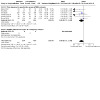
Comparison 11: Platinum vs non‐platinum regimens (sensitivity analysis 4: mTNBC patients selected for trial vs. a subgroup of trial), Outcome 1: Overall survival
Comparison 12. Platinum vs non‐platinum regimens (sensitivity analysis 5: Analyses 1 repeated but with Carey 2012 excluded).
| Outcome or subgroup title | No. of studies | No. of participants | Statistical method | Effect size |
|---|---|---|---|---|
| 12.1 Overall survival | 5 | 856 | (Exp[(O‐E) / V], Fixed, 95% CI) | 0.87 [0.73, 1.03] |
| 12.2 Progression‐free survival/time to progression | 7 | 975 | (Exp[(O‐E) / V], Fixed, 95% CI) | 0.83 [0.72, 0.95] |
| 12.3 Objective tumour response rate (assessable participants) | 9 | 1109 | Risk Ratio (M‐H, Fixed, 95% CI) | 1.38 [1.21, 1.57] |
Characteristics of studies
Characteristics of included studies [ordered by study ID]
Bhattacharyya 2009.
| Study characteristics | ||
| Methods | Randomised phase III trial. | |
| Participants | 126 mTNBC participants between age group of 38 to 72 years and who had already received anthracyclines and taxanes and had relapsed and could not afford ixabepilone and/or avastin. | |
| Interventions | 'No platinum' arm: endoxan 50 mg per day at 10 am and methotrexate 2.5 mg twice a day at 9 am and 5 pm. Platinum arm: Same as above but with 'cisplatinum.' | |
| Outcomes | OTRR.
OS (insufficient OS data reported to calculate hazard ratio for pooling). TTP (insufficient TTP data reported to calculate hazard ratio for pooling). Toxicity (no results reported). |
|
| Notes | Abstract only. Median follow‐up not stated. Median TTP: Platinum arm 13 months vs 'no platinum' arm 7 months (insufficient TTP data reported to calculate hazard ratio for pooling). Median OS: Platinum arm 16 months vs 'no platinum' arm 12 months (insufficient OS data reported to calculate hazard ratio for pooling). |
|
| Risk of bias | ||
| Bias | Authors' judgement | Support for judgement |
| Random sequence generation (selection bias) | Low risk | Stratified on more than one factor. Quote: "Patients were randomised to either... stratified by number of sites of metastasis and with or without visceral metastasis with or without bisphosphonates." |
| Allocation concealment (selection bias) | Unclear risk | Method of concealment was not described in the abstract. |
| Blinding of participants and personnel (performance bias) All outcomes | Unclear risk | No information provided in the abstract. |
| Blinding of outcome assessment (detection bias) (overall survival) | Low risk | No information provided in the abstract. Unlikely that assessment of OS would be influenced by lack of blinding. |
| Blinding of outcome assessment (detection bias) (outcomes other than overall survival and quality of life) | Unclear risk | No information provided in the abstract. |
| Incomplete outcome data (attrition bias) (time‐to‐event outcomes) | Low risk | All 60 and 66 participants randomised to intervention and control groups, respectively, appear to have been analysed in time‐to‐event analyses (intent‐to‐treat analyses), but only median times were reported (hence no time‐to‐event data could be included in meta‐analysis). |
| Incomplete outcome data (attrition bias) (binary outcomes) | Unclear risk | All randomised participants appear to have been assessed/assessable for tumour response. This was not entirely clear though, as it was not explicitly stated and they may have simply used randomised participant denominators. |
| Selective reporting (reporting bias) | High risk | The abstract mentions that toxicity was recorded but no results were reported. In addition, there was no trial registration or published protocol containing prespecified outcomes. The date when participant recruitment began was not reported, but given that this was first published in September 2009, it seemed likely that recruitment began after July 1, 2005. As of April 2015, there has been no further results published other than those in the conference abstract. |
| Other bias | Low risk | None identified. |
Carey 2012.
| Study characteristics | ||
| Methods | Multicentre randomised phase II study. Participants were randomised to control or platinum arms, with control participants additionally receiving platinum upon progression. |
|
| Participants | 112 women with stage IV triple‐negative metastatic breast cancer measurable by RECIST criteria and negative for ER, PR, and HER2 (0 or 1 on immunohistochemistry and/or normal gene copy number by fluorescence in situ hybridisation), of which 102 were treated and included in time‐to‐event analyses. Median age 52 and 49 years in platinum and control arms, respectively. Age range 28 to 33 years. 100% metastatic breast cancer. Of the 102 participants analysed: 55 (54%) were treated in the second‐ or third‐line setting, but not with previous EGFR inhibitor or platinum for metastatic disease; 84 (98%) had received an anthracycline; 65 (76%) had also received a taxane. |
|
| Interventions | Ce vs Ce + C. ARM 1: Cetuximab (400 mg/m2 load then 250 mg/m2 per week intravenously (IV)) alone, with carboplatin (area under the curve of 2, once per week IV) added after progression. ARM 2: Cetuximab (400 mg/m2 load then 250 mg/m2 per week intravenously and with carboplatin (area under the curve of 2, once per week IV). |
|
| Outcomes | OTRR.
OS(Kaplan‐Meier curve).
TTP, defined as "treatment initiation to documented progression" (Kaplan‐Meier curve; y‐axis label typo "Progression‐free survival"). Toxicity (data not useable for meta‐analysis because results for Arm 2 were combined with Arm 1 participants after progression). |
|
| Notes | Estimated min follow‐up = 0.25 months (based on first censoring tick on TTP curve).
Estimated max follow‐up = 38.3 months (based on last censoring tick on TTP curve). Median OS was 7.5 months (95% CI, 5.0 to 11.6) for arm one and 10.4 months (95% CI, 7.7 to 13.1) for arm 2. Study supported by Bristol‐Myers Squibb, University of North Carolina Breast Cancer Specialized Program of Research, Avon Partners‐for‐Progress awards and by National Institutes of Health. |
|
| Risk of bias | ||
| Bias | Authors' judgement | Support for judgement |
| Random sequence generation (selection bias) | Low risk | Quotes: "Patients were randomly assigned…" and "Constrained block randomizations (block size 21 plus 21) kept the imbalance between the arms to four at most". |
| Allocation concealment (selection bias) | Unclear risk | Method of concealment was not described. |
| Blinding of participants and personnel (performance bias) All outcomes | High risk | Quote: "Single Blind (Outcomes Assessor)" at https://clinicaltrials.gov/show/NCT00232505 implying that participants and personnel were aware of treatment allocation. |
| Blinding of outcome assessment (detection bias) (overall survival) | Low risk | Single Blind (Outcomes Assessor). Assessment of OS was unlikely to be influenced by no or incomplete blinding. |
| Blinding of outcome assessment (detection bias) (outcomes other than overall survival and quality of life) | Low risk | Cyclical evaluations including biochemical tests, CT or MRI imaging every 8 weeks, in addition to an independent evaluation of OTRR by "investigators blinded to treatment arms and not involved in the study". |
| Incomplete outcome data (attrition bias) (time‐to‐event outcomes) | Unclear risk | 102 of 112 randomised participants were analysed in time‐to‐event analyses (modified ITT). The 10 excluded participants were excluded after enrolment but before treatment, but no information was provided on the randomised groups of these excluded participants. |
| Incomplete outcome data (attrition bias) (binary outcomes) | Unclear risk | 10 of 112 randomised participants were excluded from all analyses, with no information provided on the randomised groups of these excluded participants. In addition to these 10 excluded participants: 6 of 71 and 0 of 31 participants in the (known) intervention and control groups, respectively, were not assessed/assessable for tumour response (14.3% of all randomised participants); 6 of 71 and 0 of 31 participants in the (known) intervention and control groups, respectively, were excluded from the safety population for evaluating toxicities (14.3% of all randomised participants) (toxicity data were not useable for meta‐analysis because results for Arm 2 were combined with Arm 1 participants after progression). |
| Selective reporting (reporting bias) | Low risk | Toxicity was not listed under 'outcomes' in ClinicalTrials.gov record (https://clinicaltrials.gov/show/NCT00232505), but it was mentioned in the 'secondary objectives' section of the record. All other outcomes in the trial report were listed in the ClinicalTrials.gov record and vice versa. |
| Other bias | Unclear risk | 26 participants in the control arm were additionally given carboplatin after progression. This may have attenuated any differences between treatment arms in OS. |
Fan 2012.
| Study characteristics | ||
| Methods | A prospective, open‐label, randomised phase II clinical trial carried out in the Cancer Hospital, Chinese Academy of Medical Sciences. | |
| Participants | 53 metastatic triple‐negative breast cancer (mTNBC) participants aged ≥18 years with histologically confirmed ER‐, PR‐, and HER2‐ primary breast cancer. Median age 48 and 49 years in platinum and control arms, respectively. Age range 27 to 71 years. 100% mTNBC. 100% 1st‐line. No prior treatment of advanced disease. All the participants had received anthracyclines while 66.7% of participants in the TP arm and 57.7% of participants in the TX arm received paclitaxel in the adjuvant/neoadjuvant setting. |
|
| Interventions | TP vs TX. TP ARM: Docetaxel 75 mg/m2 plus cisplatin 75 mg/m2 IV infusion day 1. TX ARM: Docetaxel 75 mg/m2 IV infusion day 1 plus capecitabine 1000 mg/m2 bid, 2 weeks on, 1 week off. |
|
| Outcomes | OTRR.
OS (Kaplan‐Meier curve).
PFS, defined as "the time from the start of the treatment until disease progression or death" (Kaplan‐Meier curve). Common adverse events. |
|
| Notes | Estimated min follow‐up = 6 months (based on first event on OS curve).
Estimated max follow‐up = 42 months (based on last event on OS curve). Median PFS time: Docetaxel + cisplatin arm 10.9 months, docetaxel + capecitabine arm 4.8 months, P < 0.001. Median survival time: Docetaxel + cisplatin arm 32.8 months, docetaxel + capecitabine arm 21.5 months, P = 0.027. All 53 randomised participants were analysed in time‐to‐event analyses (ITT). Funding grant: AVON China breast cancer research grant and the National Natural Science Foundation of China. |
|
| Risk of bias | ||
| Bias | Authors' judgement | Support for judgement |
| Random sequence generation (selection bias) | Unclear risk | Quote: "patients were randomised…"; no additional details were provided on how random assignment was achieved in the trial report. |
| Allocation concealment (selection bias) | Unclear risk | Method of concealment was not described. |
| Blinding of participants and personnel (performance bias) All outcomes | High risk | Open‐label trial. |
| Blinding of outcome assessment (detection bias) (overall survival) | Low risk | Unlikely that assessment of OS would be influenced by lack of blinding. |
| Blinding of outcome assessment (detection bias) (outcomes other than overall survival and quality of life) | Unclear risk | Not clear if outcome assessors were blinded to allocated intervention. OTRR evaluated by CT or MRI every two cycles; no further details provided. |
| Incomplete outcome data (attrition bias) (time‐to‐event outcomes) | Low risk | All 27 and 26 participants randomised to intervention and control groups, respectively, were analysed in time‐to‐event analyses (intent‐to‐treat analyses). |
| Incomplete outcome data (attrition bias) (binary outcomes) | Low risk | All randomised participants were assessed/assessable for tumour response. All randomised participants appear to have been included in the safety population for evaluating toxicities. |
| Selective reporting (reporting bias) | High risk | No trial registration or published protocol containing prespecified outcomes could be found. The date when participant recruitment began was not reported, but given that this was first published in December 2012 and that there were only 53 participants, it seems highly likely that recruitment began after July 1, 2005. Consequently, there was a high expectation of trial registration. |
| Other bias | Low risk | Baseline characteristics similar across groups except for histological grade, where the docetaxel‐platinum arm had a greater number of grade III tumours than the docetaxel‐capecitabine arm. |
Han 2018 A.
| Study characteristics | ||
| Methods | A randomised partially blinded phase II clinical trial of BRCA1/2 locally recurrent or metastatic breast cancer patients conducted at 86 sites in 20 countries between January 2012 and April 2015. | |
| Participants | Overall, 284 patients with deleterious BRCA1/2 germline mutation locally recurrent or metastatic breast cancer were analysed (4 other patients were excluded after randomisation because they received the wrong treatment). mTNBC results are presented as part of subgroup analyses. 120 patients had TNBC and between 93% and 100% of the 120 TNBC patients had metastatic disease (exact numbers for mTNBC not reported). 41 mTNBC patients analysed in the PCP arm and 38 in the VT arm; VT sample size was halved for analysis. Patient demographics and clinical characteristics were not reported for mTNBC patients. |
|
| Interventions | PCP vs VT PCP arm: Placebo plus carboplatin/paclitaxel: Placebo dose was 120 mg BID orally on days 1–7 (21‐day cycle) in the carboplatin/paclitaxel arms. Carboplatin (area under the curve 6 mg/ml/min) and paclitaxel (175 mg/m2) were administered intravenously on day 3. VT arm: Veliparib with temozolomide: Veliparib dose was 40 mg BID orally on days 1–7. Temozolomide started at 150 mg/m2 QD orally on days 1–5 (28‐day cycle), and was escalated to 200 mg/m2 at cycle 2 if well‐tolerated during the first cycle. |
|
| Outcomes | PFS (reported for mTNBC patients). OTRR (not reported for mTNBC patients). OS (not reported for mTNBC patients). Toxicity (not reported for mTNBC patients). Clinical benefit rate (not reported for mTNBC patients). Adverse events (not reported for mTNBC patients). |
|
| Notes | Only PFS results were reported for mTNBC patients (participants in this study were BRCA1/2 locally recurrent or metastatic breast cancer patients and mTNBC results are presented as part of subgroup analyses). Summary statistics relating to follow‐up time were not reported for mTNBC subgroup. Attempts to contact the corresponding author requesting additional mTNBC results were unsuccessful. AbbVie Inc. provided financial support for the study and participated in the design, study conduct, analysis, and interpretation of the data, as well as the writing, review, and approval of the manuscript. |
|
| Risk of bias | ||
| Bias | Authors' judgement | Support for judgement |
| Random sequence generation (selection bias) | Unclear risk | Quote: "Patients were randomised…"; no additional details were provided on how random assignment was achieved in the trial report. |
| Allocation concealment (selection bias) | Unclear risk | Method of concealment was not described. |
| Blinding of participants and personnel (performance bias) All outcomes | High risk | Quote: "treatment was open label for the VT arm" |
| Blinding of outcome assessment (detection bias) (overall survival) | Low risk | Unlikely that assessment of OS would be influenced by lack of blinding (OS results not reported for mTNBC subgroup). |
| Blinding of outcome assessment (detection bias) (outcomes other than overall survival and quality of life) | Unclear risk | Local and central review of radiographic scans, and events of disease progression determined centrally (but OTRR results not reported for mTNBC subgroup). However, it was not specified if assessors were blinded to treatment allocation. |
| Incomplete outcome data (attrition bias) (time‐to‐event outcomes) | Unclear risk | 4 patients were excluded after randomisation because they received the wrong treatment. An additional 6 patients were excluded because they did not have a deleterious BRCA1/2 germline mutation. It is not clear whether any of these 10 excluded patients had mTNBC (only PFS results were reported for mTNBC patients). |
| Incomplete outcome data (attrition bias) (binary outcomes) | Unclear risk | No binary outcomes or attrition numbers reported for mTNBC subgroup. |
| Selective reporting (reporting bias) | High risk | Results for all outcomes in ClinicalTrials.gov record (https://clinicaltrials.gov/ct2/show/NCT01506609) were reported, but only PFS for mTNBC subgroup analysis. |
| Other bias | Unclear risk | Study participants were selected for deleterious BRCA1/2 germline mutation and mTNBC results were a subgroup analysis. |
Han 2018 B.
| Study characteristics | ||
| Methods | A randomised partially blinded phase II clinical trial of BRCA1/2 locally recurrent or metastatic breast cancer patients conducted at 86 sites in 20 countries between January 2012 and April 2015. | |
| Participants | Overall, 284 patients with deleterious BRCA1/2 germline mutation locally recurrent or metastatic breast cancer were analysed (4 other patients were excluded after randomisation because they received the wrong treatment). mTNBC results are presented as part of subgroup analyses. 120 patients had TNBC and between 93% and 100% of the 120 TNBC patients had metastatic disease (exact numbers for mTNBC not reported). 40 mTNBC patients analysed in the VCP arm and 38 in the VT arm; VT sample size was halved for analysis. Patient demographics and clinical characteristics were not reported for mTNBC patients. |
|
| Interventions | VCP vs VT VCP arm: Veliparib plus carboplatin/paclitaxel: Veliparib dose was 120 mg BID orally on days 1–7 (21‐day cycle). Carboplatin (area under the curve 6 mg/ml/min) and paclitaxel (175 mg/m2) were administered intravenously on day 3. VT arm: Veliparib with temozolomide: Veliparib dose was 40 mg BID orally on days 1–7. Temozolomide started at 150 mg/m2 QD orally on days 1–5 (28‐day cycle), and was escalated to 200 mg/m2 at cycle 2 if well‐tolerated during the first cycle. |
|
| Outcomes | PFS (reported for mTNBC patients). OTRR (not reported for mTNBC patients). OS (not reported for mTNBC patients). Toxicity (not reported for mTNBC patients). Clinical benefit rate (not reported for mTNBC patients). Adverse events (not reported for mTNBC patients). |
|
| Notes | Only PFS results were reported for mTNBC patients (participants in this study were BRCA1/2 locally recurrent or metastatic breast cancer patients and mTNBC results are presented as part of subgroup analyses). Summary statistics relating to follow‐up time were not reported for mTNBC subgroup. Attempts to contact the corresponding author requesting additional mTNBC results were unsuccessful. AbbVie Inc. provided financial support for the study and participated in the design, study conduct, analysis, and interpretation of the data, as well as the writing, review, and approval of the manuscript. |
|
| Risk of bias | ||
| Bias | Authors' judgement | Support for judgement |
| Random sequence generation (selection bias) | Unclear risk | Quote: "Patients were randomised…"; no additional details were provided on how random assignment was achieved in the trial report. |
| Allocation concealment (selection bias) | Unclear risk | Method of concealment was not described. |
| Blinding of participants and personnel (performance bias) All outcomes | High risk | Quote: "treatment was open label for the VT arm" |
| Blinding of outcome assessment (detection bias) (overall survival) | Low risk | Unlikely that assessment of OS would be influenced by lack of blinding (OS results not reported for mTNBC subgroup). |
| Blinding of outcome assessment (detection bias) (outcomes other than overall survival and quality of life) | Unclear risk | Local and central review of radiographic scans, and events of disease progression determined centrally (but OTRR results not reported for mTNBC subgroup). However, it was not specified if assessors were blinded to treatment allocation. |
| Incomplete outcome data (attrition bias) (time‐to‐event outcomes) | Unclear risk | 4 patients were excluded after randomisation because they received the wrong treatment. An additional 6 patients were excluded because they did not have a deleterious BRCA1/2 germline mutation. It is not clear whether any of these 10 excluded patients had mTNBC (only PFS results were reported for mTNBC patients). |
| Incomplete outcome data (attrition bias) (binary outcomes) | Unclear risk | No binary outcomes or attrition numbers reported for mTNBC subgroup. |
| Selective reporting (reporting bias) | High risk | Results for all outcomes in ClinicalTrials.gov record (https://clinicaltrials.gov/ct2/show/NCT01506609) were reported, but only PFS for mTNBC subgroup analysis. |
| Other bias | Unclear risk | Study participants were selected for deleterious BRCA1/2 germline mutation and mTNBC results were a subgroup analysis. |
Icli 2005.
| Study characteristics | ||
| Methods | Prospective randomised non‐blinded multicentre phase III study. No stratification for prognostic factors or centres. Central randomisation. Baseline comparability: no significant imbalance apparent or reported. | |
| Participants | Overall, 201 women with histologically confirmed locally advanced or metastatic breast cancer previously treated with anthracyclines (193 eligible). Limited mTNBC results were provided by study investigators as part of subgroup analyses, but only 6 women had mTNBC.The characteristics of the mTNBC subgroup were not provided. | |
| Interventions | T vs VP‐16 + P. ARM A: Paclitaxel 175 mg/m2 IV, day 1 q3 weeks. ARM B: Cisplatin 70 mg/m2 IV, day 1 q3 weeks + oral etoposide (VP‐16) 50 mg bid, po, days 1 to 7 q3 weeks. |
|
| Outcomes | OS (insufficient OS data reported to calculate hazard ratio for pooling). TTP (insufficient TTP data reported to calculate hazard ratio for pooling). OTRR (no results provided for mTNBC subgroup). Toxicity (no results provided for mTNBC subgroup). | |
| Notes | Conference PowerPoint slide presentation.
Participants crossed over after 2 cycles if disease progressed or there was no evidence of response. Only 6 mTNBC patients in this study; paclitaxel arm (n=4), cisplatin arm(n=2). No results with sufficient information for pooling. Median OS: 16 and 23 months for paclitaxel and platinum arms respectively. Median TTP: 4.2 and 18 months for paclitaxel and platinum arms respectively. "Bristol Myers Squibb (Turkey) supplied limited number of paclitaxel for this trial". |
|
| Risk of bias | ||
| Bias | Authors' judgement | Support for judgement |
| Random sequence generation (selection bias) | Unclear risk | Method of random sequence generation not reported other than "No stratification was carried out for prognostic factors or centers." |
| Allocation concealment (selection bias) | Low risk | Central randomisation. |
| Blinding of participants and personnel (performance bias) All outcomes | High risk | "nonblinded study" |
| Blinding of outcome assessment (detection bias) (overall survival) | Low risk | Non‐blinded study. Unlikely that assessment of OS would be influenced by lack of blinding. |
| Blinding of outcome assessment (detection bias) (outcomes other than overall survival and quality of life) | Low risk | Quote: "Responses were reviewed by two independent experts to confirm the response status blindly for treatment received" (p. 2). |
| Incomplete outcome data (attrition bias) (time‐to‐event outcomes) | Unclear risk | Not clear how many mTNBC participants randomised to intervention and control groups, respectively, were analysed in time‐to‐event analysis. |
| Incomplete outcome data (attrition bias) (binary outcomes) | Unclear risk | Not clear how many mTNBC participants randomised to intervention and control groups, respectively, were assessed/assessable for tumour response. Not clear how many mTNBC participants randomised to intervention and control groups, respectively, were included in the safety population for evaluating toxicities. |
| Selective reporting (reporting bias) | High risk | No trial registration or published protocol prespecifying all study outcomes. Study began recruitment before July 1, 2005 so expectation of trial registration or published protocol was low. However, OTRR and toxicity results were not provided for mTNBC subgroup. |
| Other bias | Low risk | None identified. |
Mustafa 2019.
| Study characteristics | ||
| Methods | A random clinical trial carried out on mTNBC patients who attended to the Department of Oncology and Nuclear Medicine, Suez Canal University, in 2016/2017. | |
| Participants | 110 patients with mTNBC, no previous chemotherapy for metastatic disease, at least one extra cranial lesion which can be measured by MRI or CT in accordance with the response evaluation criteria in solid tumours, and ECOG performance status of 0‐2. Mean age was 46 years. 86 patients (78.18%) of the studied patients were from Ismailia. 71% of patients were ECOG performance status 1 and 29% were ECOG performance status 0. 27 patients (24.55%) were stage 2A, 43 patients (39.09%) stage 2B, 30 patients (27.27%) stage 3A and 10 patients (9.09%) stage 3B. |
|
| Interventions | Group A: Cisplatin Plus Gemcitabine (cisplatin 75 mg/m² on day 1; gemcitabine 1000 mg/m² on days 1 and 8). Group B: Paclitaxel Plus Gemcitabine (paclitaxel 175 mg/m² on day1; gemcitabine 1000 mg/m² on days 1 and 8). Both drugs administered intravenously every 3 weeks for eight cycles at maximum or until the development of disease progress or the intolerable toxic effect. |
|
| Outcomes | OTRR. PFS (insufficient PFS data reported to calculate hazard ratio for pooling). Side effects (insufficient data reported for pooling). |
|
| Notes | Median follow‐up: 12 months.
Median PFS: 8 months Group A, 6 months Group B.
Mean PFS: 7.18 months Group A (SD = 3.209), 5.49 months Group B (SD=2.292) P value for difference between groups in PFS = 0.002 (not stated whether this for difference in medians or means). "Bristol Myers Squibb (Turkey) supplied limited number of paclitaxel for this trial". Funding and conflicts not reported. Attempts to contact the corresponding author requesting additional results were unsuccessful. |
|
| Risk of bias | ||
| Bias | Authors' judgement | Support for judgement |
| Random sequence generation (selection bias) | Unclear risk | "A random assignment is used to allocate patients who are qualified to receive either...";no additional details were provided on how random assignment was achieved in the trial report |
| Allocation concealment (selection bias) | Unclear risk | Method of concealment was not described. |
| Blinding of participants and personnel (performance bias) All outcomes | Unclear risk | No information provided. |
| Blinding of outcome assessment (detection bias) (outcomes other than overall survival and quality of life) | Unclear risk | Not clear if tumour response assessors were blinded to allocated intervention. |
| Incomplete outcome data (attrition bias) (time‐to‐event outcomes) | Low risk | 55 of 55 and 55 of 55 participants randomised to intervention and control groups, respectively, were analysed for median and mean PFS. |
| Incomplete outcome data (attrition bias) (binary outcomes) | Low risk | All 110 mTNBC participants randomised to intervention and control groups, respectively, were assessed/assessable for tumour response. |
| Selective reporting (reporting bias) | High risk | No trial registration or published protocol containing prespecified outcomes could be found. Study was "carried out" in 2016/17, so there was a high expectation of trial registration. Furthermore, only results for the "most common" side effects appear to be reported. |
| Other bias | Unclear risk | Most baseline demographic and clinical characteristic differences between groups not reported. |
Stemmler 2011 A.
| Study characteristics | ||
| Methods | Randomised multicentre phase II trial. Accrual between 2003 and 2006. Groups comparable at baseline in all regards except menopausal status. |
|
| Participants | Overall, a total of 141 participants (91 in Arm A + Arm B) with histologically confirmed metastatic breast cancer. In mTNBC subgroup there were 36 participants (9 in Arm A, 12 in Arm B and 15 in Arm C). The sample size of Arm B was halved for analysis. 100% metastatic breast cancer. |
|
| Interventions | GemVin vs GemCis. ARM A: GemVin: Gemcitabine 1000 mg/m2 + vinorelbine 25 mg/m2. ARM B: GemCis: Gemcitabine 1000 mg/m2+ cisplatin 30 mg/m2. Treatment for a maximum of six (3 week) cycles. |
|
| Outcomes | OS (no results provided for mTNBC subgroup). TTP (no results provided for mTNBC subgroup). OTRR (proportions and exact binomial confidence intervals reported; these were used to calculate numerators and denominators for OTRR fractions). Toxicity (no results provided for mTNBC subgroup). |
|
| Notes | No reported deaths due to toxicity. OTRR: 11.1%, 95% CI: 0.3–48.3 (GemVin); 58.3%, 95% CI: 27.7–84.8 (GemCis). Randomisation procedure not stated ‐ just reported as "randomised". All randomised participants were analysed in time‐to‐event analyses (ITT). "This study was supported by Lilly GmbH Germany." This study was included in Egger 2017 but the reported mTNBC subgroup results for OTRR were inadvertently not included. |
|
| Risk of bias | ||
| Bias | Authors' judgement | Support for judgement |
| Random sequence generation (selection bias) | Unclear risk | Method of random sequence generation not reported. Stated as "randomised" only. |
| Allocation concealment (selection bias) | Unclear risk | Not stated. |
| Blinding of participants and personnel (performance bias) All outcomes | High risk | Registered as 'open‐label' trial (https://www.clinicaltrials.gov/ct2/show/NCT00480597). |
| Blinding of outcome assessment (detection bias) (overall survival) | Low risk | Open‐label study. Unlikely that assessment of OS would be influenced by lack of blinding. |
| Blinding of outcome assessment (detection bias) (outcomes other than overall survival and quality of life) | Unclear risk | Blood and biochemistry tests, and imaging took place during therapy. No details were provided on whether there was a central (independent) evaluation team for assessing tumour response rates. |
| Incomplete outcome data (attrition bias) (time‐to‐event outcomes) | Low risk | In the overall analysis (not mTNBC specific), all 45 and 46 participants randomised to intervention and control groups, respectively, were analysed in time‐to‐event analyses (intent‐to‐treat analyses). |
| Incomplete outcome data (attrition bias) (binary outcomes) | High risk | In the overall analysis (not mTNBC specific), 10 of 45 and 9 of 46 participants randomised to intervention and control groups, respectively, were not assessed/assessable for tumour response (20.3% of all randomised participants). 0 of 45 and 4 of 46 participants randomised to intervention and control groups, respectively, were not included in the safety population for evaluating toxicities (5.8% of all randomised participants). |
| Selective reporting (reporting bias) | High risk | In the overall analysis (not mTNBC specific), all outcomes in the trial report were listed in the ClinicalTrials.gov record and vice versa. However, only OTRR results were reported for mTNBC specific results (https://www.clinicaltrials.gov/ct2/show/NCT00480597). |
| Other bias | Low risk | None identified. |
Stemmler 2011 B.
| Study characteristics | ||
| Methods | Randomised multicentre phase II trial. Accrual between 2003 and 2006. Groups comparable at baseline in all regards except menopausal status. |
|
| Participants | Overall 141 participants (95 in Arm B + Arm C) with histologically confirmed metastatic breast cancer. In mTNBC subgroup there were 36 participants (9 in Arm A, 12 in Arm B and 15 in Arm C). The sample size of Arm B was halved for analysis. 100% metastatic breast cancer. |
|
| Interventions | GemCis vs GemCap. ARM B: GemCis: Gemcitabine 1000 mg/m2 + cisplatin 30 mg/m2. ARM C: GemCap: Gemcitabine 1000 mg/m2 + capecitabine 1.300 mg/m2. Treatment for a maximum of six (3 week) cycles. |
|
| Outcomes | OS (no results provided for mTNBC subgroup). TTP (no results provided for mTNBC subgroup). OTRR (proportions and exact binomial confidence intervals reported; these were used to calculate numerators and denominators for OTRR fractions). Toxcity (no results provided for mTNBC subgroup). |
|
| Notes | No reported deaths due to toxicity. OTRR: 58.3%, 95% CI: 27.7–84.8 (GemCis); and 53.3%, 95% CI: 27.0–78.7 (GemCap). Randomisation procedure not stated ‐ just reported as "randomised". All randomised participants were analysed in time‐to‐event analyses (ITT). "This study was supported by Lilly GmbH Germany." This study was included in Egger 2017 but the reported mTNBC subgroup results for OTRR were inadvertently not included. |
|
| Risk of bias | ||
| Bias | Authors' judgement | Support for judgement |
| Random sequence generation (selection bias) | Unclear risk | Method of random sequence generation not reported. Stated as "randomised" only. |
| Allocation concealment (selection bias) | Unclear risk | Not stated. |
| Blinding of participants and personnel (performance bias) All outcomes | High risk | Registered as "open label" trial (https://www.clinicaltrials.gov/ct2/show/NCT00480597). |
| Blinding of outcome assessment (detection bias) (overall survival) | Low risk | Open‐label study. Unlikely that assessment of OS would be influenced by lack of blinding. |
| Blinding of outcome assessment (detection bias) (outcomes other than overall survival and quality of life) | Unclear risk | Blood and biochemistry tests, and imaging took place during therapy. No details were provided on whether there was a central (independent) evaluation team for assessing tumour response rates. |
| Incomplete outcome data (attrition bias) (time‐to‐event outcomes) | Low risk | In the overall analysis (not mTNBC specific), all 45 and 50 participants randomised to intervention and control groups, respectively, were analysed in time‐to‐event analyses (intent‐to‐treat analyses). |
| Incomplete outcome data (attrition bias) (binary outcomes) | High risk | In the overall analysis (not mTNBC specific),10 of 45 and 9 of 50 participants randomised to intervention and control groups, respectively, were not assessed/assessable for tumour response (18.1% of all randomised participants). 0 of 45 and 1 of 50 participants randomised to intervention and control groups, respectively, were not included in the safety population for evaluating toxicities (1.4% of all randomised participants). |
| Selective reporting (reporting bias) | High risk | In the overall analysis (not mTNBC specific), all outcomes in the trial report were listed in the ClinicalTrials.gov record and vice versa. However, only OTRR results were reported for mTNBC specific results (https://www.clinicaltrials.gov/ct2/show/NCT00480597). |
| Other bias | Low risk | None identified. |
Tutt 2018.
| Study characteristics | ||
| Methods | Phase III trial randomising subjects with metastatic or locally advanced TNBC and or BRCA1/2 breast cancer. | |
| Participants | Eligible patients had metastatic or locally advanced TNBC and or BRCA1/2 breast cancer. An included subject could be ER‐ and HER2‐negative, PgR‐negative/unknown or any ER, PgR and HER2 status if the subject was known to have a BRCA1 or BRCA2 germline mutation and was otherwise eligible to participate Overall, 376 patients were randomised, of which: ‐ 90.2% (n=339) had metastatic disease ‐ 89.9% (n=338) had TNBC ‐ between 80.1% (n=301)) and 89.9% (n=338) had mTNBC (exact numbers not reported for mTNBC, but this range was calculated from the reported number with metastatic disease and the reported number with TNBC above). ‐ 11.4% (n=43) had germline BRCA1/2 mutation; of the 43 women with BRCA1/2 mutation, 29 did not have TNBC and 14 (37%) had TNBC (and it is not clear how many of these 14 TNBC patients had mTNBC). ‐ Patients were excluded if they had previous chemotherapy for metastatic disease other than an anthracycline. 9.5% of participants had received anthracycline chemotherapy. |
|
| Interventions | C vs D. C: Carboplatin (AUC 6 every 3 weeks for six cycles). D: Docetaxel (100 mg/m2 every 3 weeks for six cycles). |
|
| Outcomes | OTRR.
OS. PFS. Toxicity. |
|
| Notes | Estimated min follow‐up = <1 month (based on first event on PFS curve). Estimated max follow‐up = 15 months (based on last event on OS curve). Median PFS: Carboplatin 3.1 (95% CI 2.4 to 4.2) vs docetaxel 4.4 (95% CI 4.1 to 5.1) months. Median OS: Carboplatin 12.8 (95% CI 10.6 to 15.3) vs docetaxel 12.0 (95% CI 10.2 to 13.0) months. Subgroup analysis restricted to 43 BRCA1/2+ participants showed carboplatin was associated with significantly greater proportions of objective responses (68% vs 33%; P = 0.01), longer PFS (p=0.04) but not longer OS (p=0.97). "Sponsor: Institute of Cancer Research, United Kingdom". OTRR results for this study were included in pooled analyses in Egger 2017 and labelled "Tutt 2014". Additional OS and PFS results were extracted from Tutt 2018 for pooling. In Egger 2017, we had classified Tutt 2014 as "Second‐ or third‐line therapy for ≥20% of patients" on the basis of the limited published material at the time. We have reclassified Tutt 2018 as "First‐line therapy for > 80% of patients" on the basis of the more extensive information in the full publications. |
|
| Risk of bias | ||
| Bias | Authors' judgement | Support for judgement |
| Random sequence generation (selection bias) | Low risk | Quote: "ICR‐CTSU allocated patients to carboplatin or docetaxel (1:1 ratio) utilising a computerised minimisation algorithm with a random element. Balancing factors were centre, previous adjuvant taxane chemotherapy, presence of liver or lung metastasis, performance status (0/1 vs 2) and recurrent locally advanced vs metastatic carcinoma" |
| Allocation concealment (selection bias) | Low risk | Treatment allocated by The Institute of Cancer Research Clinical Trials & Statistics Units (ICR ‐CTSU), London |
| Blinding of participants and personnel (performance bias) All outcomes | High risk | Open‐label trial. |
| Blinding of outcome assessment (detection bias) (overall survival) | Low risk | Open‐label trial. Unlikely that assessment of OS would be influenced by lack of blinding. |
| Blinding of outcome assessment (detection bias) (outcomes other than overall survival and quality of life) | High risk | Ther primary endpoint was ORR. Local assessment of ORR was used for primary analysis however an independent Response Evaluation Committee reviewed reported responses centrally at study completion. |
| Incomplete outcome data (attrition bias) (time‐to‐event outcomes) | Low risk | All 188 and 188 participants randomised to intervention and control groups, respectively, were analysed in time‐to‐event analyses (intent‐to‐treat analyses). |
| Incomplete outcome data (attrition bias) (binary outcomes) | Unclear risk | All randomised participants were included in response rate denominators, but it was not explicitly stated that all participants were assessed/assessable. 4 of 188 and 6 of 188 participants randomised to intervention and control groups, respectively, were not included in the safety population for evaluating toxicities (2.7% of all randomised participants). |
| Selective reporting (reporting bias) | Unclear risk | TTP and TTTF are specified as outcomes in ClinicalTrials.gov record (https://clinicaltrials.gov/ct2/show/NCT00532727), but no results for these outcomes were provided in the paper. Nonetheless, the similar outcome of PFS was reported. |
| Other bias | Unclear risk | Effects on OS may have been attenuated by treatment crossover design. |
Yardley 2018 A.
| Study characteristics | ||
| Methods | Multicenter, open‐label, phase II randomised study conducted in 11 countries. The phase II portion of the study was designed to evaluate the risk/benefit profiles of 2 nab‐P experimental arms and to identify via a ranking algorithm the nab‐P combination for use in a phase III portion of the study. | |
| Participants | 191 women 18 years with mTNBC and having received no prior cytotoxic chemotherapy for metastatic breast cancer (64 in nab‐P/C arm and 61 in nab‐P/G arm; nab‐P/G sample size was halved for analysis). Age range 27 to 82 83% of participants were white. 48% residing in North America and 42% residing in Western Europe. Prior neoadjuvant/adjuvant therapy: 64% had Anthracyclines, 62% had Taxanes. 100% first‐line. |
|
| Interventions | nab‐P/C vs nab‐P/G nab‐P/C arm: nab‐paclitaxel 125 mg/m2 plus carboplatin area under the curve 2. nab‐P/G arm: nab‐paclitaxel 125 mg/m2 plus gemcitabine 1000 mg/m2. All agents were given on days 1 and 8 every 3 weeks. |
|
| Outcomes | OTRR.
OS. PFS. Percentage of patients who initiated cycle 6 receiving doublet combination therapy. Adverse events. |
|
| Notes | Estimated min follow‐up = 1 month (based on first event on PFS curve).
Estimated max follow‐up = 35 months (based on last censoring tick on OS curve). Median OS was 16.8 months for nab‐P/C, 12.1 months for nab‐P/G, 12.6 months for G/C. Median PFS was 8.3 months for nab‐P/C, 5.5 months for nab‐P/G, 6 months for G/C. Funding from Celgene Corporation. |
|
| Risk of bias | ||
| Bias | Authors' judgement | Support for judgement |
| Random sequence generation (selection bias) | Low risk | Quote: "…patients were randomised…"; no additional details were provided on how random assignment was achieved in the trial report. However, the protocol stated "Central randomisation via a permuted‐block design and an interactive voice response system will be implemented for both the phase II and III portions of the study." |
| Allocation concealment (selection bias) | Low risk | Method of concealment was not described. However, the protocol stated "Central randomisation via a permuted‐block design and an interactive voice response system will be implemented for both the phase II and III portions of the study." |
| Blinding of participants and personnel (performance bias) All outcomes | High risk | Open label trial. |
| Blinding of outcome assessment (detection bias) (overall survival) | Low risk | Open label but unlikely that assessment of OS would be influenced by lack of blinding. |
| Blinding of outcome assessment (detection bias) (outcomes other than overall survival and quality of life) | High risk | The primary endpoint of the study was investigator assessed PFS. |
| Incomplete outcome data (attrition bias) (time‐to‐event outcomes) | Low risk | All 191 randomised patients were analysed for OS and PFS outcomes. |
| Incomplete outcome data (attrition bias) (binary outcomes) | Low risk | 7 of 130 (5.4%) and 3 of 61 (4.9%) participants randomised to platinum groups and non‐platinum group, respectively, were not assessed/assessable for tumour response (5.2% of all randomised participants). 2 of 130 (1.5%) and 1 of 61 (1.6%) participants randomised to platinum groups and non‐platinum group, respectively, were not included in the safety population for evaluating toxicities (1.6% of all randomised participants). |
| Selective reporting (reporting bias) | Low risk | Results for all outcomes in ClinicalTrials.gov record were reported https://clinicaltrials.gov/ct2/show/NCT01881230 |
| Other bias | Unclear risk | Baseline characteristics were similar across groups except median age was lower in the nab‐P/C and the nab‐P/G groups compared to the G/C group, the nab‐P/C group had a lower proportion of patients who were black or African American or were from Western Europe, and had a disease‐free interval of 1 year compared with the nab‐P/G and G/C groups. |
Yardley 2018 B.
| Study characteristics | ||
| Methods | Multicenter, open‐label, phase II randomised study conducted in 11 countries. The phase II portion of the study was designed to evaluate the risk/benefit profiles of 2 nab‐P experimental arms and to identify via a ranking algorithm the nab‐P combination for use in a phase III portion of the study. | |
| Participants | 191 women 18 years with mTNBC and having received no prior cytotoxic chemotherapy for metastatic breast cancer. (66 in G/C arm and 61 in nab‐P/G arm; nab‐P/G sample size was halved for analysis). Age range 27 to 82. 83% of participants were white. 48% residing in North America and 42% residing in Western Europe. Prior neoadjuvant/adjuvant therapy: 64% had Anthracyclines, 62% had Taxanes. 100% first line. |
|
| Interventions | G/C vs nab‐P/G G/C arm: gemcitabine 1000 mg/m2 plus carboplatin area under the curve 2. nab‐P/G arm: nab‐paclitaxel 125 mg/m2 plus gemcitabine 1000 mg/m2. All agents were given on days 1 and 8 every 3 weeks. |
|
| Outcomes | OTRR.
OS. PFS. Percentage of patients who initiated cycle 6 receiving doublet combination therapy. Adverse events. |
|
| Notes | Estimated min follow‐up = 1 month (based on first event on PFS curve).
Estimated max follow‐up = 35 months (based on last censoring tick on OS curve). Median OS was 16.8 months for nab‐P/C, 12.1 months for nab‐P/G, 12.6 months for G/C. Median PFS was 8.3 months for nab‐P/C, 5.5 months for nab‐P/G, 6 months for G/C. Funding from Celgene Corporation. |
|
| Risk of bias | ||
| Bias | Authors' judgement | Support for judgement |
| Random sequence generation (selection bias) | Low risk | Quote: "…patients were randomised…"; no additional details were provided on how random assignment was achieved in the trial report. However, the protocol stated "Central randomisation via a permuted‐block design and an interactive voice response system will be implemented for both the phase II and III portions of the study." |
| Allocation concealment (selection bias) | Low risk | Method of concealment was not described. However, the protocol stated "Central randomisation via a permuted‐block design and an interactive voice response system will be implemented for both the phase II and III portions of the study." |
| Blinding of participants and personnel (performance bias) All outcomes | High risk | Open label trial. |
| Blinding of outcome assessment (detection bias) (overall survival) | Low risk | Open label but unlikely that assessment of OS would be influenced by lack of blinding. |
| Blinding of outcome assessment (detection bias) (outcomes other than overall survival and quality of life) | High risk | The primary endpoint of the study was investigator assessed PFS. |
| Incomplete outcome data (attrition bias) (time‐to‐event outcomes) | Low risk | All 191 randomised patients were analysed for OS and PFS outcomes. |
| Incomplete outcome data (attrition bias) (binary outcomes) | Low risk | 7 of 130 (5.4%) and 3 of 61 (4.9%) participants randomised to platinum groups and non‐platinum group, respectively, were not assessed/assessable for tumour response (5.2% of all randomised participants). 2 of 130 (1.5%) and 1 of 61 (1.6%) participants randomised to platinum groups and non‐platinum group, respectively, were not included in the safety population for evaluating toxicities (1.6% of all randomised participants). |
| Selective reporting (reporting bias) | Low risk | Results for all outcomes in ClinicalTrials.gov record were reported https://clinicaltrials.gov/ct2/show/NCT01881230 |
| Other bias | Unclear risk | Baseline characteristics were similar across groups except median age was lower in the nab‐P/C and the nab‐P/G groups compared to the G/C group, the nab‐P/C group had a lower proportion of patients who were black or African American or were from Western Europe, and had a disease‐free interval of 1 year compared with the nab‐P/G and G/C groups. |
Zhang 2018.
| Study characteristics | ||
| Methods | Prospective, open‐label, multicentre, randomised, phase 3 trial at 12 institutions or hospitals in China. | |
| Participants | 240 Chinese participants (236 analysed) with breast cancer aged 18 to 70 years who had metastatic triple‐negative breast cancer (mTNBC) histologically confirmed at the primary tumour, with clinical, imaging, histological or cytological evidence of metastatic (stage IV) disease. Median age 47 and 48 years in platinum and control arms, respectively. Age interquartile range 42 to 57 and 43 to 55 years in platinum and control arms, respectively. 100% mTNBC. 100% 1st‐line. 152 (64%) of the 236 participants had received anthracyclines. 195 (83%) of the 236 participants had received taxanes. |
|
| Interventions | Cisplatin + gemcitabine vs paclitaxel + gemcitabine. Platinum ARM: Cisplatin plus gemcitabine (cisplatin 75 mg/m2 on day 1; gemcitabine 1250 mg/m2 on days 1 and 8) intravenously every 3 weeks for a maximum of eight cycles, or until disease progression or intolerable toxic effects developed. Control ARM: Paclitaxel plus gemcitabine (paclitaxel 175 mg/m2 on day 1; gemcitabine 1250 mg/m2 on days 1 and 8) intravenously every 3 weeks for a maximum of eight cycles, or until disease progression or intolerable toxic effects developed. |
|
| Outcomes | OTRR.
OS.
PFS, defined as "the time from the date of randomisation to progression or death from any cause". Adverse events. |
|
| Notes | 4 participants were randomised but not analysed for OS or PFS (i.e. modified ITT). An additional 9 participants were not assessable for response. Estimated min follow‐up = 3 months (based on first censoring tick on OS curve). Estimated max follow‐up = 35 months (based on last censoring tick on OS curve). Median PFS was 7.73 months (95% CI 6.16 to 9.30) in the cisplatin plus gemcitabine group and 6.47 months (5.76 to 7.18) in the paclitaxel plus gemcitabine group. Median survival time was 22.3 months in the cisplatin plus gemcitabine group and 18.6 months in the paclitaxel plus gemcitabine group; not reported in the text of the study paper but estimated from Kaplan‐Meier curve. 118 of 120 randomised metastatic participants were analysed in time‐to‐event PFS analyses (modified ITT). The study was funded by Shanghai Natural Science Foundation and gemcitabine was provided by Eli Lilly. This study was included in Egger 2017 and labelled "Hu 2015". Updated OS and PFS results were extracted for pooling from Zhang 2018. |
|
| Risk of bias | ||
| Bias | Authors' judgement | Support for judgement |
| Random sequence generation (selection bias) | Low risk | Quote: "Randomisation was done centrally via a block randomization of size eight, with no stratification factors, via an interactive web‐response system." |
| Allocation concealment (selection bias) | Low risk | Central allocation. Quote: "Randomisation was done centrally…" and "After checking the inclusion criteria, the study coordinator sent the allocated treatment back to the investigator by fax." |
| Blinding of participants and personnel (performance bias) All outcomes | High risk | Open‐label trial. |
| Blinding of outcome assessment (detection bias) (overall survival) | Low risk | Unlikely that assessment of OS would be influenced by lack of blinding. |
| Blinding of outcome assessment (detection bias) (outcomes other than overall survival and quality of life) | Unclear risk | The extent and/or the effectiveness of intended blinding was not clear. Quote: "Tumour response was assessed by a team of local investigators … and when needed, with independent central assessment, every two cycles until disease progression." Assessment of toxicity appeared to be unblinded. Quote: "Adverse events were recorded at each treatment visit, at each follow‐up visit, and at the end‐of‐study visit." |
| Incomplete outcome data (attrition bias) (time‐to‐event outcomes) | Unclear risk | 118 of 120 and 118 of 120 participants randomised to intervention and control groups, respectively, were analysed in time‐to‐event analysis (modified intent‐to‐treat analysis). |
| Incomplete outcome data (attrition bias) (binary outcomes) | Low risk | 8 of 120 and 5 of 120 participants randomised to intervention and control groups, respectively, were not assessed/assessable for tumour response (5.4% of all randomised participants). 2 of 120 and 2 of 120 participants randomised to intervention and control groups, respectively, were not included in the safety population for evaluating toxicities (1.7% of all randomised participants). |
| Selective reporting (reporting bias) | Low risk | OS was not listed under 'outcomes' in ClinicalTrials.gov record (https://clinicaltrials.gov/ct2/show/NCT01287624) but it was mentioned in the 'purpose' section of the record. All other outcomes in the trial report were listed in the ClinicalTrials.gov record and vice versa. |
| Other bias | Unclear risk | Baseline characteristics were generally similar across groups except for ECOG performance status, number of metastatic organ sites and menopausal status. |
AUC: Area under the curve bid and BID: Twice a day Ce: Cetuximab C: Carboplatin CI: Confidence interval CT: X‐ray image made using computerized axial tomography D: Docetaxel ECOG: Eastern Cooperative Oncology Group EGFR: Epidermal growth factor receptor ER: oestrogen receptor G/C: gemcitabine plus carboplatin GemCap: Gemcitabine, capecitabine GemCis: Gemcitabine, cisplatin GemVin: Gemcitabine, vinorelbine HER2: Human epidermal growth factor receptor 2 ICR‐CTSU: The Institute of Cancer Research Clinical Trials & Statistics Unit ITT: Intention‐to‐treat IV: Intravenous Max: Maximum Min: Minimum mTNBC: metastatic triple‐negative breast cancer MRI: Magnetic resonance imaging nab‐P/C: nab‐paclitaxel plus carboplatin nab‐P/G: nab‐paclitaxel plus gemcitabine ORR: Objective response rate OS: overall survival OTRR: Objective tumour response rate P: Cisplatin p.: Page po: by mouth PCP: Placebo plus carboplatin/paclitaxel. PFS: progression‐free survival PR and PgR: Progesterone receptor QD: one a day QoL: Quality of life RECIST: Response Evaluation Criteria In Solid Tumors SD: Standard deviation T: Paclitaxel TNBC: Triple‐negative breast cancer TP: Docetaxel, cisplatin TTF: Time to treatment failure TTP: Time to progression TTTF: Time to treatment failure TX: Docetaxel, capecitabine VCP: Veliparib plus carboplatin/paclitaxel VP‐16: Oral etoposide VT: Veliparib with temozolomide
Characteristics of excluded studies [ordered by study ID]
| Study | Reason for exclusion |
|---|---|
| Amadori 2013 | Published tables indicate that the study tested for ER and HER2 status, but mTNBC specific results were not published. Requests for mTNBC specific results were declined by the study sponsor Eli Lilly. |
| Crump 2008 | Included 38% participants with locoregional disease. Attempts to contact authors were unsuccessful. |
| Fountzilas 2004 | Published tables indicate that the study tested for ER, PgR and HER2 status, but mTNBC specific results were not published. Attempts to contact the trial investigators requesting mTNBC specific results were unsuccessful. |
| Fountzilas 2009 | Published tables indicate that the study tested for TNBC status and there were 56 mTNBC patients. However, comparisons of treatment groups for the mTNBC subgroup were not published. Attempts to contact the trial investigators requesting mTNBC specific results were unsuccessful. |
| NCT00201760 | Enrolled only 10 patients who were unselected for mTNBC and did not report mTNBC specific results |
| Somlo 2015 | Participants not randomised. |
| Wang 2008 | > 20% participants with locally advanced disease only. Data were not reported separately. |
| Xu 2011 | Published tables indicate that the study tested for ER and HER2 status, but mTNBC specific results were not published. Attempts to contact the trial investigators requesting mTNBC specific results were unsuccessful. |
Characteristics of ongoing studies [ordered by study ID]
NCT00717951.
| Study name | A Randomised,Multi‐Center Study of Docetaxol Plus Capecitabine or Cisplatin in Anthracycline‐Pretreated Patients With Advanced Breast Cancer. |
| Methods | Randomised, phase 2, multicentre study. |
| Participants | Participants with advanced breast cancer. |
| Interventions | Docetaxel + capecitabine vs docetaxel + cisplatin. |
| Outcomes | OTRR. TTP. TTF. 2 year PFS. Safety. QoL. |
| Starting date | May 2008. Estimated study completion date: May 2010. |
| Contact information | Jiang Zefei, Ph.D, emails: jiangzf@hotmail.com; jiangzefei@medmail.com.cn. |
| Notes | Do not appear to have published any results. Emails sent to the principal investigator requesting a progress report on the study were not answered. Would need mTNBC specific results. |
NCT01898117.
| Study name | Biomarker Discovery Randomized Phase IIb Trial With Carboplatin‐cyclophosphamide Versus Paclitaxel With or Without Bevacizumab as First‐line Treatment in Advanced Triple Negative Breast Cancer. |
| Methods | Randomised phase IIb trial. |
| Participants | Participants with advanced triple‐negative breast cancer. |
| Interventions | Carboplatin‐cyclophosphamide vs paclitaxel with or without bevacizumab. |
| Outcomes | PFS. OS. Toxicity. |
| Starting date | July 2013. Estimated primary completion date: December 2019. |
| Contact information | Sabine C Linn, Prof, MD, email; s.linn@nki.nl. |
| Notes |
NCT02207335.
| Study name | Trial of Gemcitabine_Capecitabine Versus Gemcitabine_Carboplatin in Breast Cancer. |
| Methods | A multicentre randomised phase Ⅲ clinical trial. |
| Participants | Participants with triple‐negative recurrent or metastatic breast cancer. |
| Interventions | Gemcitabine + capecitabine vs gemcitabine + carboplatin. |
| Outcomes | Response (RECIST 1.1). |
| Starting date | December 2013. Estimated study completion date: December 2016. |
| Contact information | Zhongsheng Tong, Master, email: mailto:18622221181%40163.com?subject=NCT02207335, CIH‐TZS‐20140421‐01, Trial of Gemcitabine_Capecitabine Versus Gemcitabine_Carboplatin in Breast Cancer. |
| Notes | Do not appear to have published any results. Emails sent to the principal investigator in 2019 requesting a progress report on the study were not answered. Would need mTNBC specific results. |
NCT02207361.
| Study name | Paclitaxel in Combination With Carboplatin Versus Paclitaxel Plus Epirubicin in Metastatic Breast Cancer |
| Methods | Randomised prospective clinical trial. |
| Participants | Participants with metastatic breast cancer. |
| Interventions | Paclitaxel + carboplatin vs paclitaxel + epirubicin. |
| Outcomes | Response (RECIST 1.1). |
| Starting date | December 2013 |
| Contact information | Zhongsheng Tong,18622221181@163.com |
| Notes | Limited conference abstract results published. Emails sent to the principal investigator in 2019 requesting mTNBC specific results were not answered. |
NCT02299999.
| Study name | Evaluation of the Efficacy of High Throughput Genome Analysis as a Therapeutic Decision Tool for Patients With Metastatic Breast Cancer |
| Methods | Randomised controlled trial |
| Participants | Patients With Metastatic Breast Cancer |
| Interventions | Platinum based chemotherapies vs targeted agent |
| Outcomes | OTRR. PFS. Overall survival. |
| Starting date | April 2014 |
| Contact information | Monica Arnedos, Monica.ARNEDOS@gustaveroussy.fr |
| Notes | Not clear whether platinum therapies are randomised. Would need mTNBC specific results. |
NCT02544243.
| Study name | Randomised, Multicenter Phase II Study in Patients With Metastatic Breast Cancer With Vinorelbine Plus Gemcitabine Versus Vinorelbine Plus Cisplatin |
| Methods | Randomised, Multicenter Phase II Study |
| Participants | Patients With Metastatic Breast Cancer |
| Interventions | Vinorelbine Plus Gemcitabine Versus Vinorelbine Plus Cisplatin |
| Outcomes | PFS. OS. Toxicity. |
| Starting date | September 2015 |
| Contact information | Contact: Xinzhao Wang, 08wangxinzhao@163.com |
| Notes | Would need mTNBC specific results. |
NCT02546232.
| Study name | Improved Breast Cancer Therapy (I‐BCT‐1) in the Neoadjuvant and Metastatic Setting: A Phase 2 Clinical Trial Protocol Studying Biological Rationale for the Optimal Selection of Treatment Regimens |
| Methods | Randomised, Phase 2 Clinical Trial |
| Participants | Breast cancer patients with metastatic disease |
| Interventions | Metastatic patients are randomised 1:1 to receive paclitaxel alone or paclitaxel in combination with carboplatin. |
| Outcomes | OTRR. |
| Starting date | April 2015 |
| Contact information | Olav Engebraaten, Department of Oncology, Oslo University Hospital |
| Notes | Would need mTNBC specific results. |
NCT02819518.
| Study name | Study of Pembrolizumab (MK‐3475) Plus Chemotherapy vs. Placebo Plus Chemotherapy for Previously Untreated Locally Recurrent Inoperable or Metastatic Triple Negative Breast Cancer (MK‐3475‐355/KEYNOTE‐355) |
| Methods | Randomized, Double‐Blind, Phase III Study |
| Participants | Women with previously untreated locally recurrent inoperable or metastatic triple negative breast cancer |
| Interventions | Carboplatin vs various non‐platinum regimens |
| Outcomes | PFS. OS. Toxicity |
| Starting date | July 2016 |
| Contact information | Medical Director Merck Sharp & Dohme Corp. |
| Notes |
NCT03423849.
| Study name | Prospective Randomized Controlled Study of the Maintenance Regimen and Revised Regimen for Advanced Breast Cancer Survivors After First‐line Salvage Therapy |
| Methods | Randomised controlled trial |
| Participants | Advanced Breast Cancer Survivors After First‐line Salvage Therapy |
| Interventions | vinorelbine and platinum (NP) vs vinorelbine and gemcitabine (NG) |
| Outcomes | Disease‐free survival OS. |
| Starting date | February 2018 |
| Contact information | Zhaoyun Liu, Shandong Cancer Hospital and Institute |
| Notes | Would need mTNBC specific results. |
NCT03424005.
| Study name | A Phase Ib/II, Open‐Label, Multicenter, Randomized Umbrella Study Evaluating The Efficacy And Safety Of Multiple Immunotherapy‐Based Treatment Combinations In Patients With Metastatic Triple‐Negative Breast Cancer (Morpheus‐TNBC) |
| Methods | A Phase Ib/II, Open‐Label, Multicenter, Randomized Umbrella Study |
| Participants | Patients With Metastatic Triple‐Negative Breast Cancer |
| Interventions | Atezolizumab + Chemo (Gemcitabine + Carboplatin or Eribulin) vs Capecitabine |
| Outcomes | OTRR. PFS. OS. Toxicity |
| Starting date | March 2018 |
| Contact information | Study Director: Clinical Trials Hoffmann‐La Roche |
| Notes | Unclear whether platinum is randomised. |
NCT03499899.
| Study name | A Phase II Open‐label, Randomized, Three‐arm, Multicenter Study of LAG525 Given in Combination With Spartalizumab (PDR001), or With Spartalizumab and Carboplatin, or With Carboplatin, as First or Second Line Therapy in Patients With Advanced Triple‐negative Breast Cancer |
| Methods | A Phase II Open‐label, Randomized, Three‐arm, Multicenter Study |
| Participants | Patients With Advanced Triple‐negative Breast Cancer |
| Interventions | LAG525 Given in Combination With Spartalizumab (PDR001), or With Spartalizumab and Carboplatin, or With Carboplatin |
| Outcomes | OTRR. PFS. OS. |
| Starting date | July 2018 |
| Contact information | Study Director: Novartis Pharmaceuticals |
| Notes |
BRCA: Breast cancer susceptibility gene ER: Oestrogen receptor HER2: Human epidermal growth factor receptor 2 PR: Progesterone receptor QoL: Quality of life RECIST:Response Evaluation Criteria In Solid Tumors
Differences between protocol and review
The protocol for our previous review (Egger 2017) proposed that trials would be included if study participants were to receive first‐line treatment. As few trials assessing first‐line treatment were identified for inclusion in the original version of our previous review (Carrick 2004), those meeting the remaining eligibility criteria but which involved participants who were not first‐line naive were included. This modification of the inclusion criteria was maintained for this review with subgroup analysis by treatment line being performed (treatment‐comparisons with first‐line therapy for > 80% of participants versus second‐ or third‐line therapy for ≥ 20% of participants).
The addition of an adverse event, treatment discontinuation, as recommended by the clinical peer‐reviewer.
Five of the six subgroup analyses in this review were not prespecified in the protocol for our previous review but were added in response to new hypotheses and available subgroups. All of the six subgroup analyses in this review were included in our previous review.
Contributions of authors
SE, and MC assessed trial eligibility. SE, MC and QL performed data extraction. SE and MC performed 'Risk of bias' assessments. SE entered the data. SE performed the statistical analysis and wrote the review. NW provided clinical input. All authors commented on and contributed to the writing of the review.
Sources of support
Internal sources
Cancer Council NSW, Australia
External sources
No sources of support supplied
Declarations of interest
SE: none known. MC: none known. QL: none known. NW: has intermittently served on advisory boards for pharmaceutical companies and been paid honoraria for educational lectures sponsored by pharmaceutical companies. None of these activities concerned use of platinums for breast cancer and fees were donated to a patient care fund at Westmead Hospital.
Edited (no change to conclusions)
References
References to studies included in this review
Bhattacharyya 2009 {published data only (unpublished sought but not used)}
- *.Bhattacharyya GS, Basu S, Agarwal V, Malhotra H, Pareekh PM, Babu KG, et al. 41LBA Single institute phase II study of weekly cisplatinum and metronomic dosing of endoxan and methotrexate in second line metastatic breast cancer triple-negative. In: European Journal of Cancer Supplements. Vol. 7. 2009:18-19.
Carey 2012 {published data only}
- *.Carey LA, Rugo HS, Marcom PK, Mayer EL, Esteva FJ, Ma CX, et al. TBCRC 001: randomized phase II study of cetuximab in combination with carboplatin in stage IV triple-negative breast cancer. Journal of Clinical Oncology 2012;30(21):2615-23. [DOI] [PMC free article] [PubMed] [Google Scholar]
- NCT00232505. Cetuximab + / - carboplatin for estrogen receptor-negative, progesterone receptor-negative metastatic breast cancer. clinicaltrials.gov/show/NCT00232505 (accessed 13 April 2016).
Fan 2012 {published data only}
- Fan Y, Xu BH, Yuan P, Ma F, Wang JY, Ding XY, et al. Docetaxel–cisplatin might be superior to docetaxel–capecitabine in the first-line treatment of metastatic triple-negative breast cancer. Annals of Oncology 2013;24(5):1219-25. [DOI] [PubMed] [Google Scholar]
Han 2018 A {published data only}
- *.Han HS, Diéras V, Robson M, Palácová M, Marcom PK, Jager A, et al. Veliparib with temozolomide or carboplatin/paclitaxel versus placebo with carboplatin/paclitaxel in patients with BRCA1/2 locally recurrent/metastatic breast cancer: randomized phase II study. Annals of Oncology 2017;29(1):154-61. [DOI] [PMC free article] [PubMed] [Google Scholar]
- NCT01506609. The study evaluating efficacy and tolerability of veliparib in combination with temozolomide or in combination with carboplatin and paclitaxel versus placebo in subjects with BRCA1 and BRCA2 mutation and metastatic breast cancer. https://clinicaltrials.gov/ct2/show/NCT01506609 (accessed July 30 2019).
Han 2018 B {published data only}
- *.Han HS, Diéras V, Robson M, Palácová M, Marcom PK, Jager A, et al. Veliparib with temozolomide or carboplatin/paclitaxel versus placebo with carboplatin/paclitaxel in patients with BRCA1/2 locally recurrent/metastatic breast cancer: randomized phase II study. Annals of Oncology 2017 Sep 29;29(1):154-61. [DOI] [PMC free article] [PubMed] [Google Scholar]
- NCT01506609. The study evaluating efficacy and tolerability of veliparib in combination with temozolomide or in combination with carboplatin with and paclitaxel versus placebo in subjects with BRCA1 and BRCA2 mutation and metastatic breast cancer. https://clinicaltrials.gov/ct2/show/NCT01506609 (accessed July 30 2019).
Icli 2005 {published and unpublished data}
- Icli F, Akbulut H, Uner A, Bulent Y, Altinbas M, Baltali E, et al. Paclitaxel (T) vs cisplatin + VP-16 (EP) in metastatic breast cancer patients treated with anthracyclines: A phase III randomized study, Turkish Oncology Group. Annals of Oncology 2002;13:47.
- *.Icli F, Akbulut H, Uner A, Yalcin B, Baltali E, Altinbas M, et al. Cisplatin plus oral etoposide (EoP) combination is more effective than paclitaxel in patients with advanced breast cancer pretreated with anthracyclines: a randomised phase III trial of Turkish Oncology Group. British Journal of Cancer 2005;92:639-44. [DOI] [PMC free article] [PubMed] [Google Scholar]
Mustafa 2019 {published data only (unpublished sought but not used)}
- Mustafa S, Zamzam M, Abdel Mohsen S, Hassanen E. Cisplatin plus gemcitabine versus paclitaxel plus gemcitabine as first-line therapy for metastatic triple negative breast cancer. The Egyptian Journal of Hospital Medicine 2019;74(8):1878-83. [Google Scholar]
Stemmler 2011 A {published data only}
- NCT00480597. Gemcitabine/vinorelbine versus gemcitabine/cisplatin versus gemcitabine/capecitabine in metastatic breast cancer. clinicaltrials.gov/ct2/show/NCT00480597 (accessed 13 April 2016).
- *.Stemmler HJ, DiGioia D, Freier W, Tessen HW, Gitsch G, Jonat W, et al. Randomised phase II trial of gemcitabine plus vinorelbine vs gemcitabine plus cisplatin vs gemcitabine plus capecitabine in patients with pretreated metastatic breast cancer. British Journal of Cancer 2011;104(7):1071-8. [DOI] [PMC free article] [PubMed] [Google Scholar]
Stemmler 2011 B {published data only}
- NCT00480597. Gemcitabine/vinorelbine versus gemcitabine/cisplatin versus gemcitabine/capecitabine in metastatic breast cancer. clinicaltrials.gov/ct2/show/NCT00480597 (accessed 13 April 2016).
- *.Stemmler HJ, DiGioia D, Freier W, Tessen HW, Gitsch G, Jonat W, et al. Randomised phase II trial of gemcitabine plus vinorelbine vs gemcitabine plus cisplatin vs gemcitabine plus capecitabine in patients with pretreated metastatic breast cancer. British Journal of Cancer 2011;104(7):1071-8. [DOI] [PMC free article] [PubMed] [Google Scholar]
Tutt 2018 {published data only}
- NCT00532727. Triple negative breast cancer trial (TNT). clinicaltrials.gov/show/NCT00532727 (accessed 13 April 2016).
- Tutt A, Ellis P, Kilburn L, Gilett C, Pinder S, Abraham J, et al. The TNT trial: A randomized phase III trial of carboplatin (C) compared with docetaxel (D) for patients with metastatic or recurrent locally advanced triple negative or BRCA1/2 breast cancer (CRUK/07/012). Cancer Research 2015;75(9 Supplement):S3-01. [Google Scholar]
- Tutt A, Ellis P, Kilburn LS. The TNT trial: A randomized phase III trial of carboplatin compared with docetaxel for patients with metastatic or recurrent locally advanced trip-negative or BRCA1/2 breast cancer. In: Thirty-Seventh Annual CTRC-AACR San Antonio Breast Cancer Symposium; December 9-13, 2014; San Antonio, TX. Vol. 75. 2014:S3-1.
- *.Tutt A, Tovey H, Cheang MC, Kernaghan S, Kilburn L, Gazinska P, et al. Carboplatin in BRCA1/2-mutated and triple-negative breast cancer BRCAness subgroups: the TNT Trial. Nature medicine 2018;24(5):628-41. [DOI] [PMC free article] [PubMed] [Google Scholar]
Yardley 2018 A {published data only}
- NCT01881230. Evaluate risk/beneift of nab paclitaxel in combination with gemcitabine and carboplatin compared to gemcitabine and carboplatin in triple negative metastatic breast cancer (or metastatic triple negative breast cancer) (tnAcity). https://clinicaltrials.gov/ct2/show/NCT01881230 (accessed July 30 2019).
- Yardley DA, Brufsky A, Conte P, Cortes J, Glück S, Nabholtz J-MA, et al. TnAcity: A phase 2/3 randomized study of weekly nab-paclitaxel in combination with either gemcitabine or carboplatin vs gemcitabine/carboplatin as first-line treatment for triple-negative metastatic breast cancer. Cancer Research 2013;73(24 Supplement):OT3. [Google Scholar]
- *.Yardley DA, Coleman R, Conte P, Cortes J, Brufsky A, Shtivelband M, et al. nab-Paclitaxel plus carboplatin or gemcitabine versus gemcitabine plus carboplatin as first-line treatment of patients with triple-negative metastatic breast cancer: results from the tnAcity trial. Annals of Oncology 2018;29(8):1763-70. [DOI] [PMC free article] [PubMed] [Google Scholar]
Yardley 2018 B {published data only}
- NCT01881230. Evaluate risk/beneift of nab paclitaxel in combination with gemcitabine and carboplatin compared to gemcitabine and carboplatin in triple negative metastatic breast cancer (or metastatic triple negative breast cancer) (tnAcity). https://clinicaltrials.gov/ct2/show/NCT01881230 (accessed July 30 2019).
- Yardley DA, Brufsky A, Conte P, Cortes J, Glück S, Nabholtz J-MA, et al. TnAcity: A phase 2/3 randomized study of weekly nab-paclitaxel in combination with either gemcitabine or carboplatin vs gemcitabine/carboplatin as first-line treatment for triple-negative metastatic breast cancer. Cancer Research 2013;73(24 Supplement):OT3. [Google Scholar]
- *.Yardley DA, Coleman R, Conte P, Cortes J, Brufsky A, Shtivelband M, et al. nab-Paclitaxel plus carboplatin or gemcitabine versus gemcitabine plus carboplatin as first-line treatment of patients with triple-negative metastatic breast cancer: results from the tnAcity trial. Annals of Oncology 2018 Jun 6;29(8):1763-70. [DOI] [PMC free article] [PubMed] [Google Scholar]
Zhang 2018 {published data only}
- *.Hu XC, Zhang J, Xu BH, Cai L, Ragaz J, Wang ZH, et al. Cisplatin plus gemcitabine versus paclitaxel plus gemcitabine as first-line therapy for metastatic triple-negative breast cancer (CBCSG006): a randomised, open-label, multicentre, phase 3 trial. Lancet Oncology 2015;16(4):436-46. [DOI] [PubMed] [Google Scholar]
- NCT01287624. Gemcitabine plus cisplatin versus gemcitabine plus paclitaxel in triple negative breast cancer (TNBC). clinicaltrials.gov/ct2/show/NCT01287624 (accessed 13 April 2016).
- *.Zhang J, Lin Y, Sun XJ, Wang BY, Wang ZH, Luo JF, et al. Biomarker assessment of the CBCSG006 trial: a randomized phase III trial of cisplatin plus gemcitabine compared with paclitaxel plus gemcitabine as first-line therapy for patients with metastatic triple-negative breast cancer. Annals of Oncology 2018;29(8):1741-7. [DOI] [PubMed] [Google Scholar]
References to studies excluded from this review
Amadori 2013 {published data only}
- *.Amadori D, Carrasco E, Roesel S, Labianca R, Uziely B, Soldatenkova V, et al. A randomized phase II non-comparative study of pemetrexed‑carboplatin and gemcitabine‑vinorelbine in anthracycline- and taxane-pretreated advanced breast cancer patients. International Journal of Oncology 2013;42(5):1778-85. [DOI] [PubMed] [Google Scholar]
- Amadori D, La Torre I, Carrasco EM, Roesel S, Labianca R, Moreau-Donnet V, et al. A randomized phase II study of pemetrexed-carboplatin and gemcitabine-vinorelbine in patients with anthracycline- and taxane-pretreated advanced breast cancer. Journal of Clinical Oncology 2011;29(15 Suppl):1051-1051. [Google Scholar]
- NCT00325234. Pemetrexed-carboplatin and gemcitabine-vinorelbine in advanced breast cancer. clinicaltrials.gov/ct2/show/results/NCT00325234 (accessed 13 April 2016).
Crump 2008 {published data only}
- Crump M, Gluck S, Tu D, Stewart D, Levine M, Kirkbride P, et al. Randomized trial of high-dose chemotherapy with autologous peripheral-blood stem-cell support compared with standard-dose chemotherapy in women with metastatic breast cancer: NCIC MA.16. Journal of Clinical Oncology 2008;26(1):37-43. [DOI] [PubMed] [Google Scholar]
Fountzilas 2004 {published data only}
- Fountzilas G, Kalofonos HP, Bafaloukos D, Papakostas P, Kosmidis P, Gogas H, et al. Paclitaxel and epirubicin versus paclitaxel and carboplatin as first-line chemotherapy in patients with advanced breast cancer: A phase III study conducted by the Hellenic Cooperative Oncology Group. Annals of Oncology 2002;13(Suppl 5):46-69. [DOI] [PubMed] [Google Scholar]
- *.Fountzilas G, Kalofonos HP, Dafni U, Papadimitriou C, Bafaloukos D, Papakostas P, et al. Paclitaxel and epirubicin versus paclitaxel and carboplatin as first-line chemotherapy in patients with advanced breast cancer: a phase III study conducted by the Hellenic Cooperative Oncology Group. Annals of Oncology 2004;15(10):1517-26. [DOI] [PubMed] [Google Scholar]
Fountzilas 2009 {published data only}
- Fountzilas G, Dafni U, Dimopoulos MA, Koutras A, Skarlos D, Papakostas P, et al. A randomized phase III study comparing three anthracycline-free taxane-based regimens, as first-line chemotherapy, in metastatic breast cancer. A Hellenic Cooperative Oncology Group Study. Breast Cancer Research and Treatment 2009;11:87-99. [DOI] [PubMed] [Google Scholar]
NCT00201760 {unpublished data only}
- NCT00201760. A randomized phase II study of gemcitabine/ trastuzumab and gemcitabine/ cisplatin/ trastuzumab in patients with metastatic breast cancer. clinicaltrials.gov/show/NCT00201760 (accessed 12 April 2016).
Somlo 2015 {published and unpublished data}
- Somlo G, Frankel PH, Luu TH, Ma CX, Arun B, Garcia AA, et al. Efficacy of the PARP inhibitor (PI) ABT-888 (veliparib [vel]) either with carboplatin (carb) or as a single agent followed by post-progression therapy in combination with carb in patients (pts) with BRCA1-or BRCA2-(BRCA)-associated metastatic breast cancer (MBC). Journal of Clinical Oncology 2015;33(15 Suppl):520. [Google Scholar]
Wang 2008 {published data only}
- Wang Y, Wu Q, Su F, Zhou L, Ye Z, Yang J, et al. Phase II study of docetaxel plus epirubicin versus docetaxel plus cisplatin as first-line chemotherapy for metastatic breast cancer. Chinese Journal of Oncology 2008;30(7):541-4. [PubMed] [Google Scholar]
Xu 2011 {published data only}
- NCT00191854. Gemcitabine combinations in metastatic breast cancer (MBC), 1st Line. clinicaltrials.gov/ct2/show/results/NCT00191854 (accessed 13 April 2016).
- *.Xu B, Jiang Z, Kim SB, Yu S, Feng J, Malzyner A, et al. Biweekly gemcitabine-paclitaxel, gemcitabine-carboplatin, or gemcitabine-cisplatin as first-line treatment in metastatic breast cancer after anthracycline failure: a phase II randomized selection trial. Breast Cancer 2011;18(3):203-12. [DOI] [PubMed] [Google Scholar]
References to ongoing studies
NCT00717951 {unpublished data only}
- NCT00717951. A randomised, multi-center study of docetaxol plus capecitabine or cisplatin in anthracycline-pretreated patients with advanced breast cancer. clinicaltrials.gov/show/NCT00717951 (accessed April 12 2016).
NCT01898117 {unpublished data only}
- NCT01898117. Triple-B study;carboplatin-cyclophosphamide versus paclitaxel with or without bevacizumab as first-line treatment in advanced triple negative breast cancer (Triple-B). clinicaltrials.gov/show/NCT01898117 (accessed 12 April 2016).
NCT02207335 {unpublished data only}
- NCT02207335. A multicenter randomized phase III clinical trial of gemcitabine in combination with capecitabine versus gemcitabine plus carboplatin as first-line treatment in triple-negative recurrent or metastatic breast cancer. clinicaltrials.gov/ct2/show/NCT02207335 (accessed 12 April 2016).
NCT02207361 {unpublished data only}
- NCT02207361. A randomized prospective clinical trial of paclitaxel in combination with carboplatin versus paclitaxel plus epirubicin as first-line treatment in metastatic breast cancer. clinicaltrials.gov/ct2/show/NCT02207361 (accessed 12 April 2016).
NCT02299999 {published data only}
- NCT02299999. SAFIR02_Breast - efficacy of genome analysis as a therapeutic decision tool for patients with metastatic breast cancer (SAFIR02_Breast). clinicaltrials.gov/ct2/show/NCT02299999 (accessed October 2019).
NCT02544243 {published data only}
- NCT02544243. Vinorelbine/gemcitabine versus vinorelbine/cisplatin in metastatic breast cancer. clinicaltrials.gov/ct2/show/NCT02544243 (accessed October 2019).
NCT02546232 {published data only}
- NCT02546232. Improved Breast Cancer Therapy (I-BCT-1) in the neoadjuvant and metastatic setting. clinicaltrials.gov/ct2/show/nct02546232 (accessed October 2019).
NCT02819518 {published data only}
- NCT02819518. Study of pembrolizumab (MK-3475) plus chemotherapy vs. placebo plus chemotherapy for previously untreated locally recurrent inoperable or metastatic triple negative breast cancer (MK-3475-355/KEYNOTE-355). clinicaltrials.gov/ct2/show/NCT02819518 (accessed October 2019).
NCT03423849 {published data only}
- NCT03423849. The maintenance regimen and revised regimen for advanced breast cancer survivors after first-line salvage therapy. clinicaltrials.gov/ct2/show/NCT03423849 (accessed October 2019).
NCT03424005 {published data only}
- NCT03424005. A study evaluating the efficacy and safety of multiple immunotherapy-based treatment combinations in patients with metastatic or inoperable locally advanced triple-negative breast cancer (Morpheus-TNBC). clinicaltrials.gov/ct2/show/NCT03424005 (accessed October 2019).
NCT03499899 {published data only}
- NCT03499899. A study of efficacy and safety of LAG525 in combination with spartalizumab, or with spartalizumab and carboplatin, or with carboplatin, in patients with advanced triple-negative breast cancer. https://clinicaltrials.gov/ct2/show/NCT03499899 (accessed October 2019).
Additional references
Beslija 2009
- Beslija S, Bonneterre J, Burstein HJ, Cocquyt V, Gnant M, Heinemann V, et al. Third consensus on medical treatment of metastatic breast cancer. Annals of Oncology 2009;20(11):1771-85. [DOI] [PubMed] [Google Scholar]
Burzykowski 2008
- Burzykowski T, Buyse M, Piccart-Gebhart MJ, Sledge G, Carmichael J, Lück HJ, et al. Evaluation of tumor response, disease control, progression-free survival, and time to progression as potential surrogate end points in metastatic breast cancer. Journal of Clinical Oncology 2008;26(12):1987-92. [DOI] [PubMed] [Google Scholar]
Carrick 2004
- Carrick S, Ghersi D, Wilcken N, Simes J. Platinum containing regimens for metastatic breast cancer. Cochrane Database of Systematic Reviews 2004, Issue 3. Art. No: CD003374. [DOI: 10.1002/14651858.CD003374.pub3] [DOI] [PubMed] [Google Scholar]
Clements 2012
- Clements MS, Roder DM, Yu XQ, Egger S, O'Connell DL. Estimating prevalence of distant metastatic breast cancer: a means of filling a data gap. Cancer Causes & Control 2012;23(10):1625-34. [DOI] [PubMed] [Google Scholar]
De Angelis 2005
- De Angelis CD, Drazen JM, Frizelle FA, Haug C, Hoey J, Horton R, et al. Is this clinical trial fully registered?—A statement from the International Committee of Medical Journal Editors. New England Journal of Medicine 2005;352(23):2436-8. [DOI] [PubMed] [Google Scholar]
Egger 1997
- Egger M, Smith GD, Schneider M, Minder C. Bias in meta-analysis detected by a simple, graphical test. BMJ 1997;315(7109):629-34. [DOI] [PMC free article] [PubMed] [Google Scholar]
Egger 2017
- Egger SJ, Willson ML, Morgan J, Walker HS, Carrick S, Ghersi D, et al. Platinum-containing regimens for metastatic breast cancer. Cochrane Database of Systematic Reviews 2017, Issue 6. Art. No: CD003374. [DOI: 10.1002/14651858.CD003374.pub4] [DOI] [PMC free article] [PubMed] [Google Scholar]
Eisenhauer 2009
- Eisenhauer E, Therasse P, Bogaerts J, Schwartz LH, Sargent D, Ford R, et al. New response evaluation criteria in solid tumours: revised RECIST guideline (version 1.1). European Journal of Cancer 2009;45(2):228-47. [DOI] [PubMed] [Google Scholar]
Ferlay 2018a
- Ferlay J, Ervik M, Lam F, Colombet M, Mery L, Piñeros M, et al. (2018) Global Cancer Observatory: Cancer Today. Lyon, France: International Agency for Research on Cancer.. https://gco.iarc.fr/today accessed [17 January 2019].
Ferlay 2018b
- Bray F, Ferlay J, Soerjomataram I, Siegel RL, Torre LA, Jemal A. Global Cancer Statistics 2018: GLOBOCAN Estimates of Incidence and Mortality Worldwide for 36 Cancers in 185 Countries. CA: a cancer journal for clinicians Novemebr 2018;68(6):394-424. [DOI] [PubMed] [Google Scholar]
Foulkes 2010
- Foulkes WD, Smith IE, Reis-Filho JS. Triple-negative breast cancer. NEJM 2010;363(20):1938-48. [DOI] [PubMed] [Google Scholar]
GradeproGDT
- GRADEproGDT: GRADEpro Guideline Development Tool [Software]. McMaster University, 2015 (developed by Evidence Prime, Inc.). Available from www.gradepro.org.
Guan 2015
- Guan X, Ma F, Fan Y, Zhu W, Hong R, Xu B. Platinum-based chemotherapy in triple-negative breast cancer: a systematic review and meta-analysis of randomized-controlled trials. Anti-cancer Drugs 2015;26(8):894-901. [DOI] [PubMed] [Google Scholar]
Guyatt 1998
- Guyatt GH, Juniper EF, Walter SD, Griffith LE, Goldstein RS. Interpreting treatment effects in randomised trials. BMJ 1998 Feb 28;316(7132):499-501. [DOI] [PMC free article] [PubMed] [Google Scholar]
Guyatt 2011
- Guyatt GH, Oxman AD, Sultan S, Glasziou P, Akl EA, Alonso-Coello P, et al, the GRADE Working Group. GRADE guidelines: 9. Rating up the quality of evidence. Journal of Clinical Epidemiology 2011;64(12):1311-6. [DOI] [PubMed] [Google Scholar]
Hayes 1995
- Hayes DF, Henderson IC, Shapiro CL. Treatment of metastatic breast cancer: present and future prospects. Seminars in Oncology 1995;22(Suppl 5):5-21. [PubMed] [Google Scholar]
Higgins 2011
- Higgins JPT, Green S, editor(s). Cochrane Handbook for Systematic Reviews of Interventions Version 5.1.0 (updated March 2011). The Cochrane Collaboration, 2011. Available from handbook.cochrane.org.
Higgins 2019
- Higgins JPT, Thomas J, Chandler J, Cumpston M, Li T, Page MJ, et al. Cochrane Handbook for Systematic Reviews of Interventions version 6.0. Cochrane, July 2019. [Google Scholar]
Hortobagyi 1996
- Hortobagyi GN, Piccart-Gebhart MJ. Current management of advanced breast cancer. Seminars in Oncology 1996;23(Suppl 11):1-5. [PubMed] [Google Scholar]
Kassam 2009
- Kassam F, Enright K, Dent R, Dranitsaris G, Myers J, Flynn C, et al. Survival outcomes for patients with metastatic triple-negative breast cancer: implications for clinical practice and trial design. Clinical Breast Cancer 2009;9(1):29-33. [DOI] [PubMed] [Google Scholar]
Kaya 2018
- Kaya V, Yildirim M, Yazici G, Gunduz S, Bozcuk H, Paydas S. Effectiveness of platinum-based treatment for triple negative metastatic breast cancer: a meta-analysis. Asian Pacific journal of cancer prevention 2018;19(5):1169. [DOI] [PMC free article] [PubMed] [Google Scholar]
Mani 2002
- Mani S, Graham MA, Bregman DB, Ivy P, Chaney SG. Oxaliplatin: a review of evolving concepts. Cancer Investigation 2002;20(2):246-63. [DOI] [PubMed] [Google Scholar]
Noll 2006
- Noll DM, Mason TM, Miller PS. Formation and repair of interstrand cross-links in DNA. Chemical Reviews 2006;106(2):277-301. [DOI] [PMC free article] [PubMed] [Google Scholar]
Parmar 1998
- Parmar MKB, Torri V, Stewart L. Extracting summary statistics to perform meta-analyses of the published literature for survival endpoints. Statistics in Medicine 1998;17:2815-34. [DOI] [PubMed] [Google Scholar]
RevMan 2014 [Computer program]
- Review Manager 5 (RevMan 5). Version 5.3. Copenhagen: Nordic Cochrane Centre, The Cochrane Collaboration, 2014.
Sikov 2015
- Sikov WM. Assessing the role of platinum agents in aggressive breast cancers. Current Oncology Reports 2015;17(2):1-10. [DOI] [PubMed] [Google Scholar]
Stordal 2007
- Stordal B, Pavlakis N, Davey R. Oxaliplatin for the treatment of cisplatin-resistant cancer: a systematic review. Cancer Treatment Reviews 2007;33(4):347-57. [DOI] [PubMed] [Google Scholar]
Tierney 2007
- Tierney JF, Stewart LA, Ghersi D, Burdett S, Sydes MR. Practical methods for incorporating summary time-to-event data into meta-analysis. Trials 2007;8(1):1. [DOI] [PMC free article] [PubMed] [Google Scholar]
Yusuf 1985
- Yusuf S, Peto R, Lewis J, Collins R, Sleight P. Beta blockade during and after myocardial infarction: an overview of the randomized trials. Progress in Cardiovascular Diseases. 1985;5:335-71. [DOI] [PubMed] [Google Scholar]


